
 US Navy Fleet Aircraft Carriers (1942-50): USS Essex, Yorktown, Intrepid, Hornet, Lexington, Bunker Hill, Wasp, Franklin, Ticonderoga, Randolph, Hancock, Bennington, Shangri-la, Bonhomme Richard, Antietam, Boxer, Lake Champlain, Princeton, Tarawa, Kearsage, Leyte, Philippine Sea, Valley Forge, Oriskany
US Navy Fleet Aircraft Carriers (1942-50): USS Essex, Yorktown, Intrepid, Hornet, Lexington, Bunker Hill, Wasp, Franklin, Ticonderoga, Randolph, Hancock, Bennington, Shangri-la, Bonhomme Richard, Antietam, Boxer, Lake Champlain, Princeton, Tarawa, Kearsage, Leyte, Philippine Sea, Valley Forge, OriskanyWW2 US Carriers:
USS Langley | Lexington class | Akron class (airships) | USS Ranger | Yorktown class | USS Wasp | Long Island class CVEs | Bogue class CVE | Independence class CVLs | Essex class CVs | Sangamon class CVEs | Casablanca class CVEs | Commencement Bay class CVEs | Midway class CVAs | Saipan classThe world’s largest capital ship program
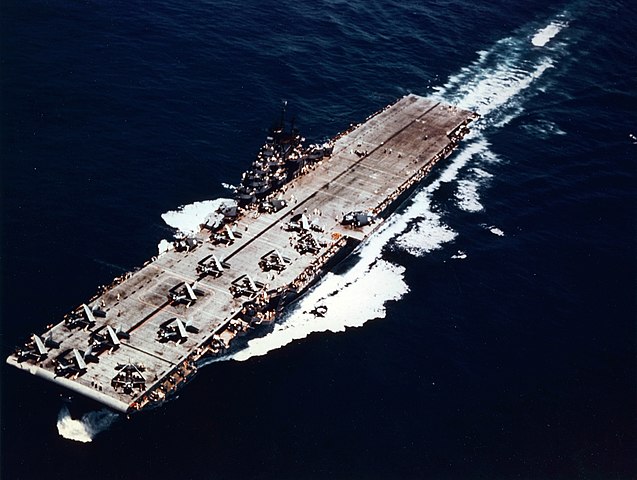
In March 1941, the first of the most prolific series of heavy aircraft carriers in history started with the laying USS Essex’s keel in Newport News. The genesis of these exceptional ships started in June 1939, in the decision to support the three Yorktowns of the Pacific fleet, of which the third, USS Hornet, was still nearing completion (launched December 1940).
For the most part, they resumed the qualities of the previous ships, but this time without worrying about treaty limits. They were defined as a wartime emergency fleet aircraft carrier class, including a number of event-induced upgrades.
For 32 ships programmed, 8 cancelled, 24 were laid down, 17 were completed early enough to see the Second World War and 14 actually seeing combat. USS Essex was completed much earlier than anticipated, on December 31, 1942. But only operational from May 1943, soon joined by not only 13 other sister ships, but the fast ones of the Independence class ☍ (CVL) which were created at the origin as an interim, until the Essex came.
Eventually they will complete the latter well, despite initial reticences of the admiralty. The Essex from mid-1943 to Septemer 1945 played a central role and despite furious reprisals by Kamikaze attacks and heavy damage, none was lost (like USS Franklin).
After Japan’s departure of naval treaties in 1936, the U.S. realized it needed to bolster its naval strength and the Naval Expansion Act of Congress was passed on 17 May 1938, enabling a new 40,000 tons limit for aircraft carriers, the “escalator clause” aslo applied to battleships. This extra tonnage allowed to built the Hornet as a copy-paste of the Yorktowns, as well as the new USS Essex as lead ship of a new class.
They were awaited like the Messiah, with many other programs slowed sown or suspended (notably battleships) to compensate for the loss of Lexington, Yorktown, Hornet, and later Wasp(in the Atlantic) leaving only USS Enterprise (badly damaged several times by the way) and Saratoga (too) to hold the line for months.
Suffice to say that the Essex class would bring a well expected breath of fresh air to the beleaguered US Navy.
But the Essex also formed the backbone of the USN in the Cold War. Until their gradual replacement from frontline duties by the supercarriers of the 1960s, they played their role in Korea but also in Vietnam for many. Gradually modernized and rebuilt to operate jets and helicopters they were still relevant in 1970. One also became also the Apollo program main recovery ship. There were two sub-classes: Ticonderoga, the “long hull” design, and USS Oriskany, which was entirely rebuilt for modern jets and was used as a standard for conversion (Completed September 1950) called SCB-27. As of today, four were preserved: USS Yorktown (Patriot’s Point, Mount Pleasant), USS Intrepid, in New York City, USS Hornet, in Alameda, and USS Lexington at Corpus Christi.
Genesis of the Essex class
Design work on a new (unnamed) carrier design started already in 1939, under the leadership of Commander Leslie Kniskern, appointed as chief design officer, Bureau of Ships. Kniskern coordinated a large amount of data from naval architects, aviation facilities, catapults or arresting gear specialist companies, aviation service, plus a small, but dedicated aviator board. Also the Carrier Desk Officer of the Bureau of Aeronautics under Commander James Russell put its weight in the balance. Russell knew well all pre-war aircraft carriers, landing and taking off from all of these, and just completed at this point a two years tour aboard USS Yorktown, following her initial fitting out. He was both an aviator and naval officer, and almost became Kniskern’s main advisor during the initial process.
Since earlier carrier classes were all the product of international naval treaties restrictions, endlessly playing with nerve-ratching limits, with the Washington Treaty ending in 1936 it became possible to increase carrier tonnage authorized by Congress in 1938. Bureau of Ships just restarted its top design priorities, making a requirement now only limited by the locks at the Panama Canal, the deciding factor for an upper limit in size.
Next in line, came the definitions (with aviators) of the “sunday punch”, composition of the air group onboard that would be responsible for all the tactical operations. The larger size brought hopes to bring up the total number onboard of just 100 aircraft, plus spares. Next came in hierarchical order its composition, the balance within this projection of force between fighters (both for strike escort and as local defence – CAP), bombers and torpedo-bombers.
Eventually, by tweaking with other aspects of the design and making some compromises, it was found best to reduce this initial requirement to a compliment of 90 aircraft, notably due to the fact they all needed to be spotted on the flight deck at the same time, for a fully armed deck-load launch, single strike which was precisely called the “Sunday Punch”. The concept was developed during academy war games years, and allowed the greatest tactical efficiency in operations. In practice though, it was never applied exactly like the theory, at least at Midway, when emergency dictated a launch in “penny packets”, but at least in the less strainous conditions from 1943 when Essex-class ships carried out their first strikes, it was applied.
Another fact entering the equation was the growing size and weight of naval aircraft. In 1939, the USN park still comprised several biplanes, notably the F3F, F2F, FF, Curtiss SBC Helldiver, etc. but the Douglas TBD Devastator that was just entering service was massive compared to these, up to 10,194 lb (4,623 tons.) fully loaded, with a wingspan of 50 feet. This would require more square footage, more free deck forward for take-off. Catapults were also part of the design but stayed as an option, as slowing down the ship’s “full strike” delivery. At the time, simply pointing the ship towards favourable ocean winds across the deck was enough, with full throttle, wheels blocked starts.
Requirement to spot 90 planes on the deck ready for launch still was a daunty challenge for all designers, using scaled-up version of the Hornet as a starting point. Extra space was soon found by eliminating the two starboard gun sponsons (compensated later by the island’s twin turrets), extending the flight deck. The island itself was made sufficiently off-board and narrow to free deck space, and since USS Wasp experimented with an external aircraft elevator now met widespread approval. This deck edge elevator still, could fold up for the Panama canal crossing. All the tricks in and out of the book were proposed and adopted to maximize flight deck space (see later about the “sunday punch”).
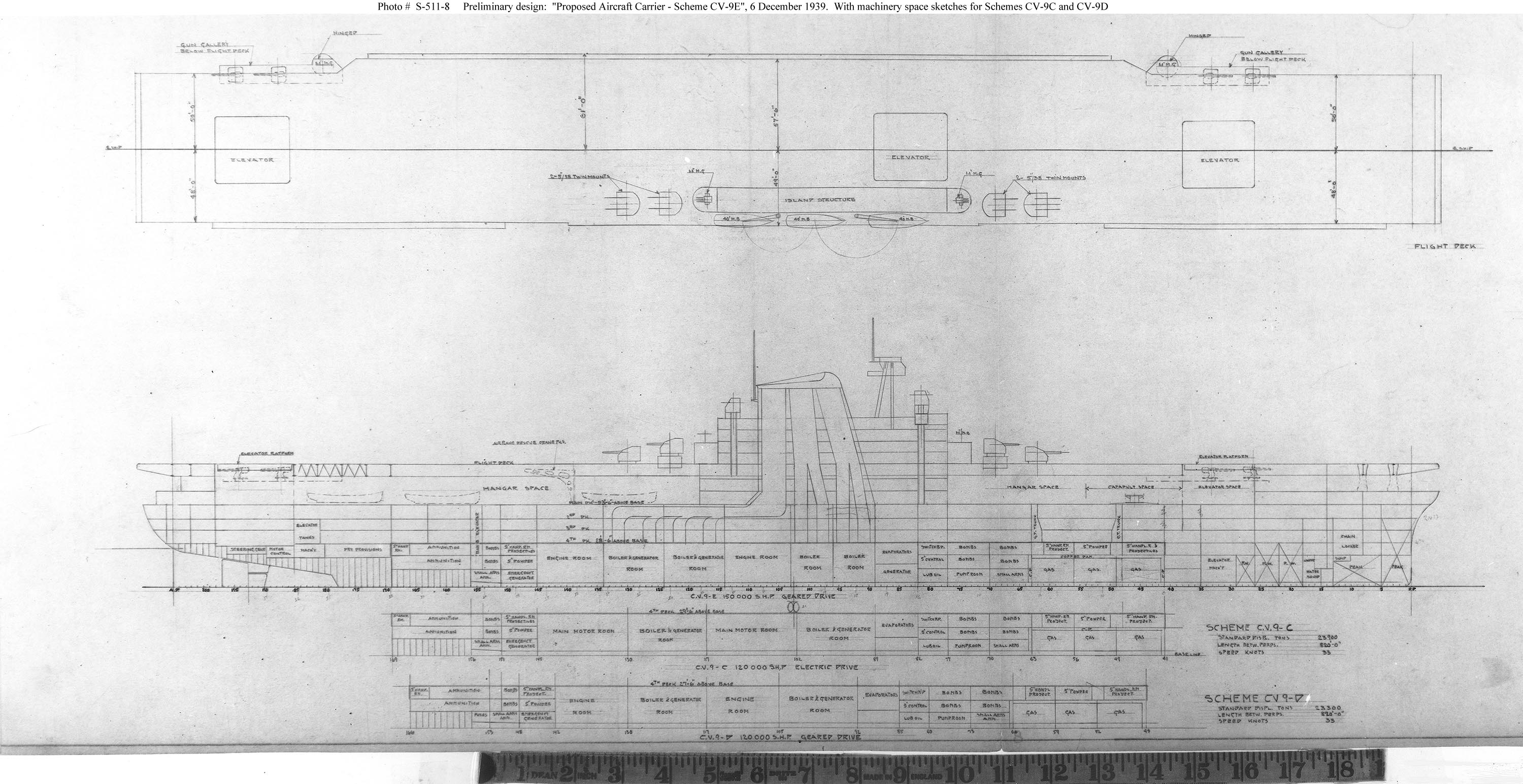
Preliminary design, proposed Scheme CV9E, 6 december 1939. Note the position of the lifts, all centerline, and same size, the combination of island turrets and single mount 5-in/38 in sponsons, and large funnel.
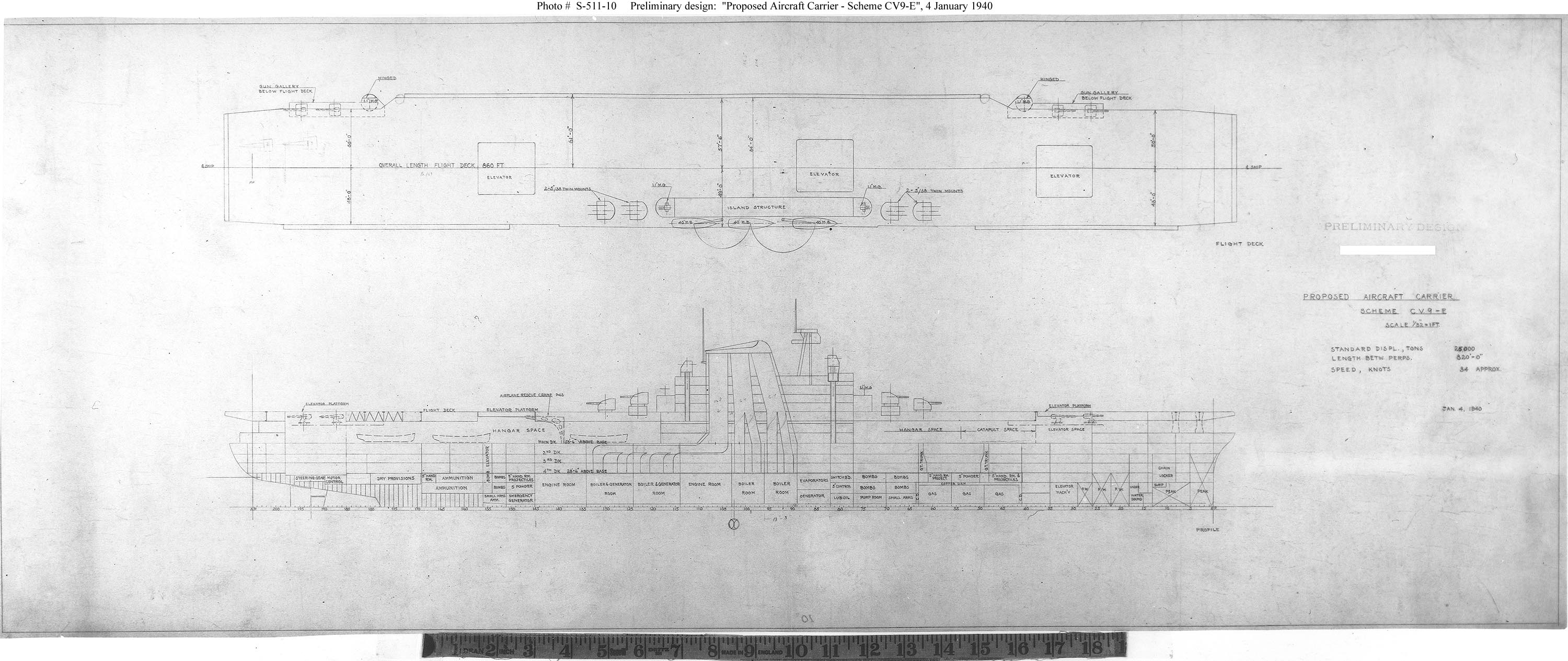
Same, dated 4 January 1940, the lifts are now heavenly spaced on the 860 fts flight deck, and there are towo islands fire positions for quad 1-inch MGs. The fire director tripod is reminiscent from the Yorktown class as well.
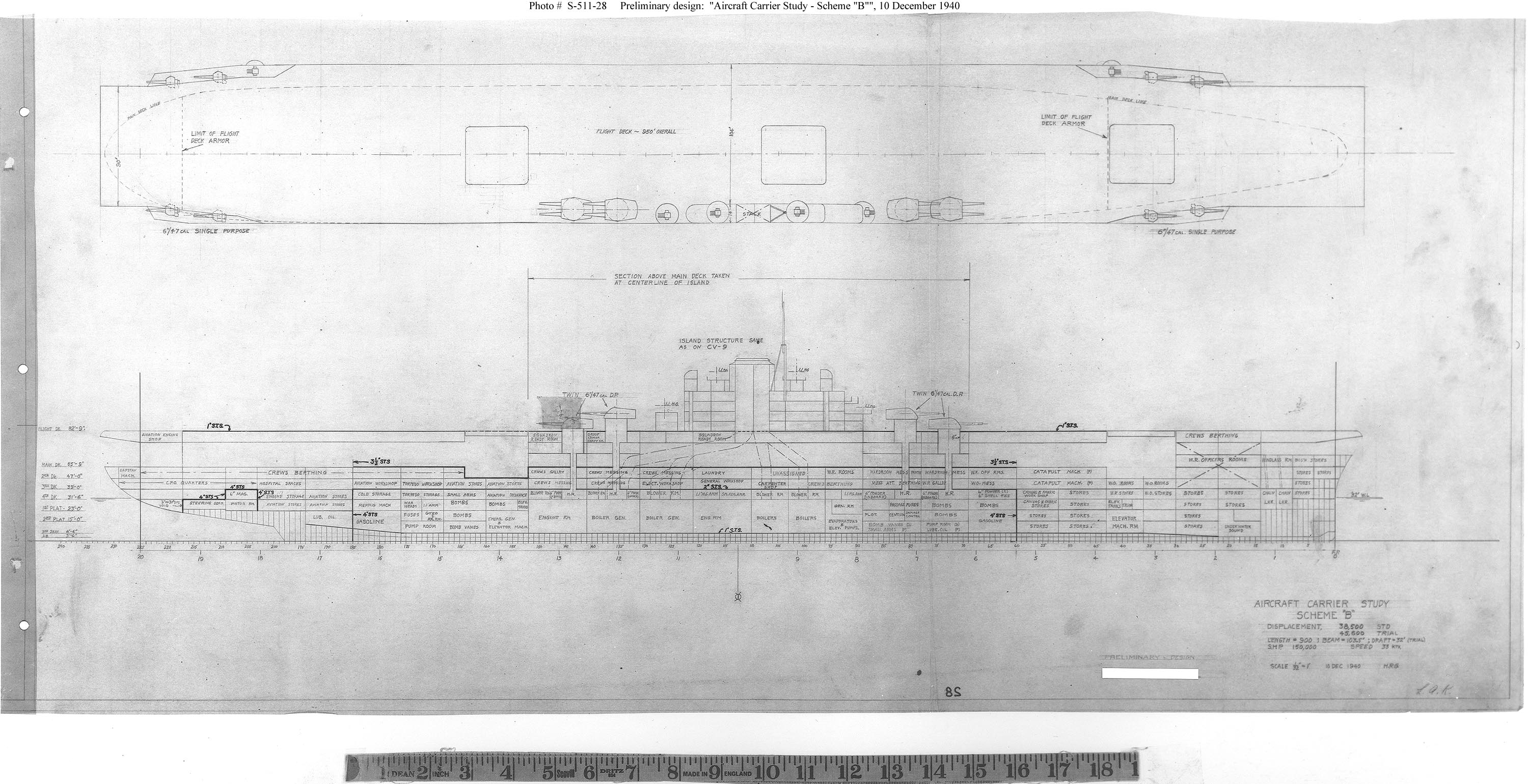
Preliminary design, aircraft carrier study “B”, signed 10 Dec. 1940. The armoured “self protection” alternative project. It Introduces many changes, notably with an all 6-inches/47 guns (sixteen, in four twin turrets and eight pivots, masked singles on sponsons). The funnel is smaller and with rearranged truncated exhausts, an simpler tripod mast. The most striking aspect is about the armour, 3 inches 1/2 of STS steel on the main armor deck/hangar floor, 1-1/2 inch on the flight deck, 4 inches over sensible parts like avgas tanks, steering gear, ammo magazines, creating a citadel starying at waterline level, with a 2-1/2 inches roof and 4 inches bulkheads. The closest the USN went for a semi-armoured aircraft carrier.
The question of whether or not to armoring the flight deck was at the heart of vigorous dicussions. Naval architecture requires to balance metacentric height, that an armoured deck would inevitably compromise. Possible solution was to compensate on the lower hull, using ballasts and bulges, but again, Panama Canal limit prevented additions. The massive armored flight deck and its structural supports needed would also reduce the useable hangar deck space inside.
Despite the US knew about the British bold step with the Illustrious class and its fully armoured hangar (the price of a much smaller air group) decision was made early on NOT to protect the flight dekc but concentrate rather on the lower hangar deck, and fourth deck (above the machinery, tanks and stores) which made better sense, and not sacrificing any of the air group’s full strenght.
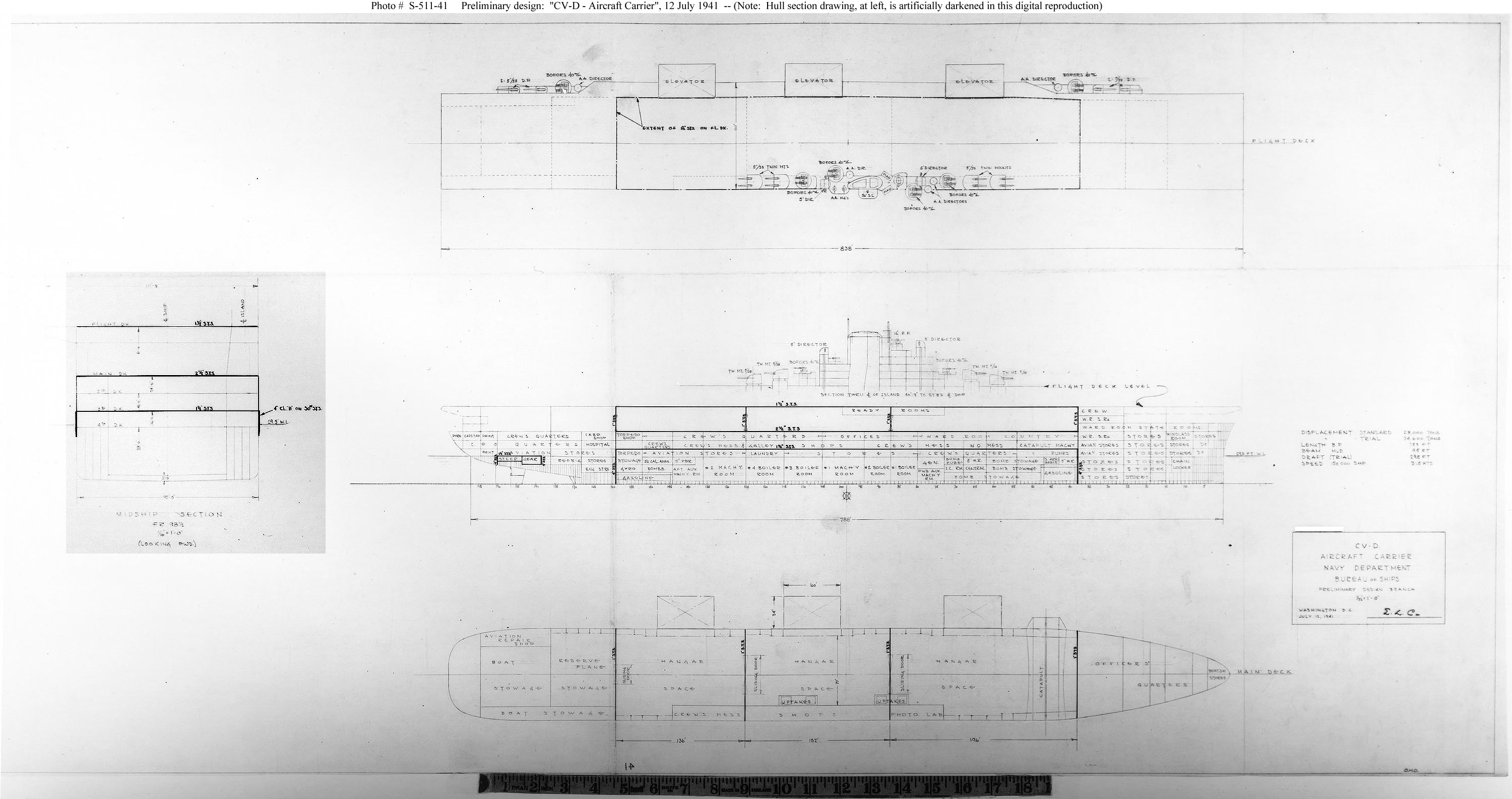
Preliminary BuShip design “CV-D Aircraft Carrier” July, 12 1941. A return to the 4-in/38 armed carrier, but taking in a revised version of the previous armour, this time creating a “armoured hangar” like the Illustrious class, but reduced to 1/2 of the total lenght of the ship, and compartimentalized into three sub-sections. Also there are now three external lifts. Armour is lighter, 1-1/2 inches STS for the flight deck, 1 inches for the bulkheads and subdivisions, 2-1/2 inches for the hangar floor, 1-1/2 inches for the roof of the citadel below (still with 4 inches bulkheads).
In conversations about maximizing the flight deck size, Commander Russell pushed hard for the an all rectangular shape, to the bow. This was part to reach more space for spotting aircraft and giving pilots a full width for take-off, especially when at very end of it. Naval architects of course resisted the idea due to the placement of structural support on the corners, as the hull needed to be at its narrowest.
But it evolved once it was assured the flight deck would not be armored, and Commander Russell pushed architects to come wih a solution. The latter argued a single middle support would fail structurally in heavy seas but the “aeronautic board” convinced them that an occasional buckled deck was worth a safer, larger take-off platform. The rectangular flight deck was eventually approved as well, and the bluckling up in heavy weather was realized through typhoons southeast of Japan in 1945, six carriers suffering that damage as predicted.
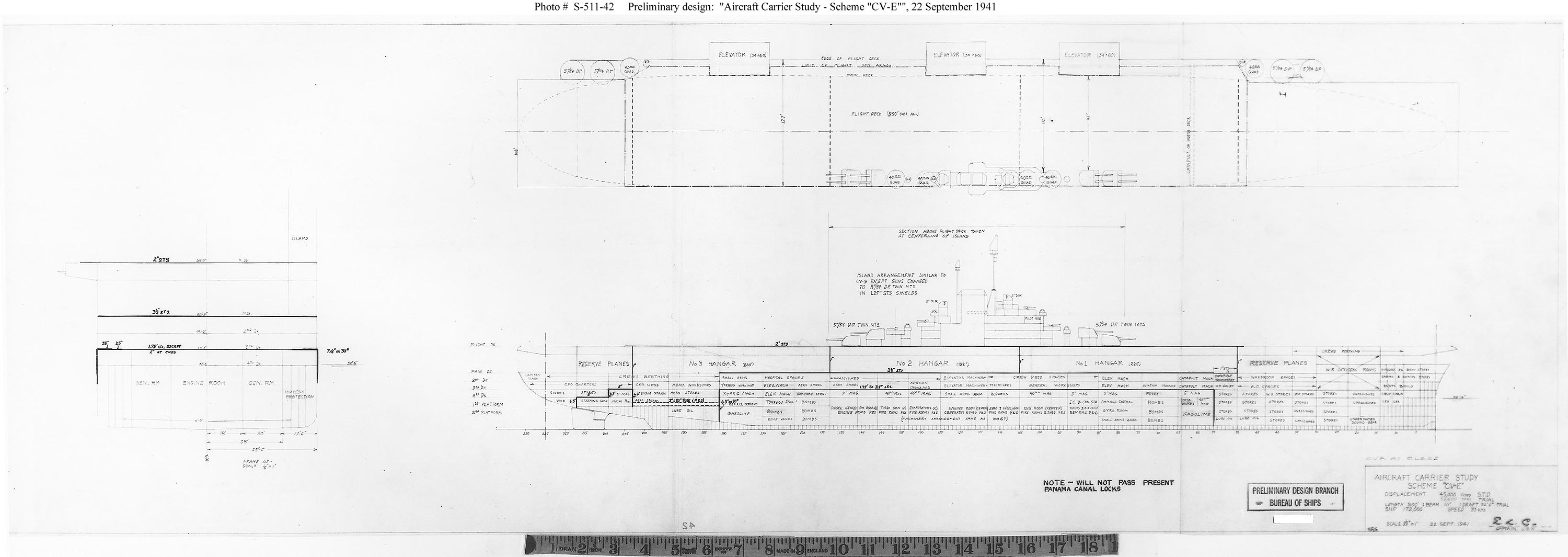
CV-E design scheme, 22 September 1941

Final, more detailed preliminary design, “C9-19 aircraft carrier”, 23 September 1941. Further work has been made for the hangar armour scheme. It is extended to guarantee a large air group to be protected, into three sub-sectoions, and similar bulkheads as before but a heavier flight deck, 2 inches thick, a,d 3-1/2 inches for the hangar floor/upper armored deck. The citadel below had sloped bulkheads at 6.3° to 20° and ASW bulkhead tubes, still 5-inches over the magazine and steering gear. For the first time future radar positions are shown. It is mentioned the 5-in/54 in twin mounts replace the 5-in/38 encased in 1.25 inches STS armor. Also two internal, one external lift.
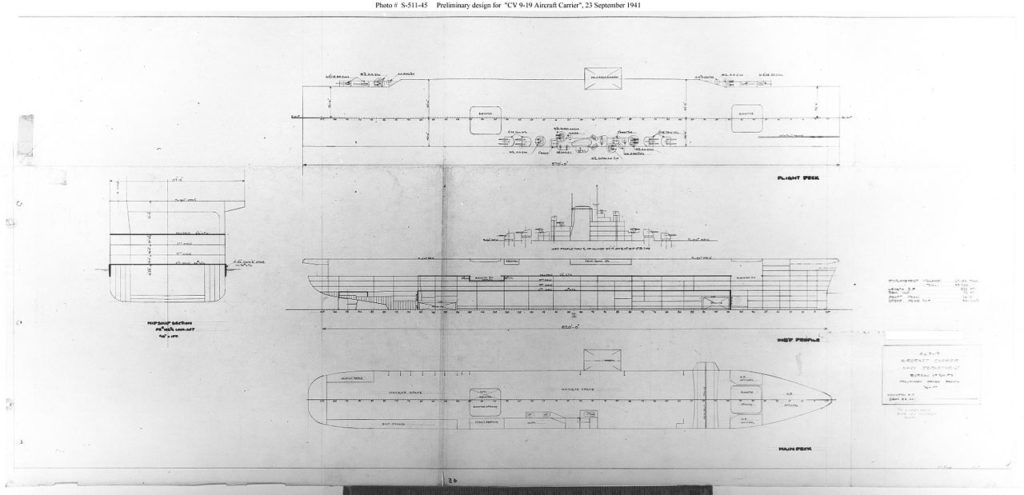
Final plan approved for CV-9, September 1941. Very close to the previous scheme, but apparently back to 5-in/38 turrets.
Construction programme
CV-9 was to the prototype for a 27,000-ton of standard displacement aircraft carrier class. It was obviously larger than Yorktown class, yet still smaller than the converted Saratogas, but with a fully dedicated design, authorizing a much larger air rgoup to be carried. This went into two waves of authorizations, when the US were still at peace: CV-9, CV-10 and CV-11 were ordered from Newport News Shipbuilding & Drydock Company on 3 July 1940. Under the terms the new Two-Ocean Navy Act or Vinson-Walsh Act to establish the composition of the Navy and authorize more constructions (June 1940), ten more of the Essex class were programmed, eight ordered on 9 September, CV-12-15 from Newport News, CV-16−19 from Bethlehem Steel’s Fore River Shipyard, then CV-20, CV-21 just eight days after Pearl Harbor, from the Brooklyn Navy Yard, and Newport News.
As the US were at war, the Congress appropriated funds for no les than nineteen additional Essex-class carriers, ten in August 1942: CV-31, 33-35 (Brooklyn NyD), CV-32 (Newport News) CV-36 & CV-37 (Philadelphia Navy Yard), CV-38-40 (Norfolk Navy Yard). In June 1943, an extra three was authorized: CV-45 (Philadelphia NyD), CV-46 (Newport News NyD) CV-47 (Fore River Shipyard). In 1944, six more were authorized, CV-50 to CV-55, all cancelled as it was now clear the Pacific war was turning favourably and they were now surplus. Of all those above, only two were completed and trained to be active in WW2, the rest only had a cold war career.
Naming Trivia
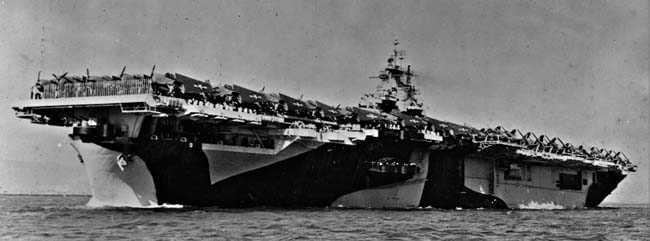
The Essex-class carriers confirmed the tendency of naming CVs after historic battles, started with the Lexington class. The first eight however were assigned names from older historic ships (Essex, Bon Homme Richard, Intrepid, Kearsarge, Franklin, Hancock, Randolph, Cabot) and others renamed during construction after losses: USS Lexington (CV-2) at Coral Sea, Yorktown (CV-5) at Midway originally (former Bon Homme Richard) Wasp and Hornet later. Lexington and Yorktown were both historic ships and historic battles.
USS Wasp(ii) was the former Oriskany but replace CV-7 sunk near Guadalcanal, Hornet(ii) the former Kearsarge after CV-8 lost at the Battle of Santa Cruz Islands. Valley Forge was renamed Princeton after the loss of USS Princeton (CVL-23) at Leyte Gulf (October 1944). Ticonderoga and Hancock’s name were swapped under construction due to the John Hancock life insurance company’s massive bond at the condition the ship was under construction in the company’s home state (Massachusetts). USS Shangri-La was another curiosity: Obviously not a historical battle, it came from a facetious remark by President Franklin Delano Roosevelt suggesting that men from the Doolittle Raid flew from the the namesake ficticious Himalayan kingdom based on the bestseller 1933 novel “Lost Horizon” at the time. She was also the last scrapped, in 1988.
The ships never laid down CV-50-55 being canceled, this left nine hull still unfinished in August 1945. Of these, six were completed and two, USS Reprisal and Iwo Jima were scrapped. Oriskany was a bit different as she was the very last laid down and in such an early stage of construction it was decided to take her in hand for radical modifications, making her into a brand new and improved design. So she was completed in 1950 and acted as a prototype to convert the others. With 32 fleet aircraft carriers (considered as capital ships), 26 laid down, 24 commissioned, this still made the USN hhaving arguably the largest of such programs in history.
Detailed design
These ships remained very fast, with a large straight wooden flight deck and side lifts, carrying twice as much aviation fuel and ammunition, and an equally larger aviation group of 100 aircrafts. Their main island was pushed, overhanging to the side. The hangar was hardly larger however with a full capacity of 91 aircraft and maximum capacity of 108, including typically 36 fighters, 37 dive bombers dive and 18 torpedo bombers.
Their high pressure boilers turbines developed 150,000 hp for 32.7 knots, better than the Yorktowns but also 10,000 tonnes more in displacement. They were roomy if not comfy for the crews, and had a better protected hangar with two armored decks as well as additional armor over the machinery, tanks and ammunition holds. Finally and above all else, the larger Essex had room for a better AA from the start with a battery of four twin 5-in/38 standard turrets, plus eight quad 40 mm quadruple mounts and around forty six 20 mm Oerlikons “by default”. It was further reinforced for those out in 1944-45, with 18-31 and quadruple 40 mm mounts (up to 124 guns !) and from 61 to 70 of 20 mm, even in twin mounts plus twelve quad Browning .5 cal. (USS Lexington ii.)
Armor design development
On the armour side, debates raged and still went on today among experts and historians about the effect of the strength deck location. British designers looked at the Essex class design and saw the peculiarities of the hangar deck armor inefficient, whereas historians such as D.K. Brown saw the American arrangement superior in many ways. In the late 1930s, the location of the strength deck at hangar deck level reduced topweight and resulted in smaller supporting structures, thus more internal aircraft capacity, for the same displacement.
And so, the first, larger supercarriers necessitated a deeper hull. This shifted the center of gravity and stability lower enough so that the strength deck could be lifted up to the flight deck. This freed US naval architects to move the whole armor scheme higher while still sticking to severe stability specifications, and keeping seaworthiness intact.
“Design 9G” among the developments leading to the final Essex design included an armored flight deck with reduced aircraft capacity at 27,200 tons. It was 1,200 tons more than “Design 9F”, the final one while “9G” was furher developed and became in wartime the development basis for the first true USN armoured carriers, the 45,000-ton Midway class.
Specifications called for the use of Special Treatment Steel (STS) all around, whenever possible also. Armor plating evolved a great deal since the 1860s, and metallurgy science also in the XXth century, notably alloys driven by the need of new aviation materials. This was a new nickel-chromium steel alloy, giving the same protective qualities as “Class B” armor. It was more resistant to splintering and allowed to be used as a full structural plate rather than and add-on for protection (therefore a deadweight). STS became a de facto structural material like no USN ship before, wherever it was desirable, so on hangar deck, fourth deck, pilot house, bulkheads, steering works, magazines and avgas tanks.
Hangar space design & arrangements
As compared to battleship design, the hangar deck became the ship’s main deck, and having a lighter flight deck meant it could be raised a bit higher, allowing to suspend below the roof all needed spare parts and of course having gantry cranes, enough clearing space above folded wings, and enough work space for the crews. Designers included however a kind of half-deck also, Gallery or Mezzanine Deck suspended from beneath the flight deck which were used as aviation squadron ready rooms, plus Combat Information Center (later moved below the armour deck in the “long hull” versions).
The flight deck surface was wooden, as custom practice, notably to avoid excessive metal heat in tropical climates and south pacific waters in general. It was made of teak beams, laid athwartships or crossways, in steel channels. On each twelfth cross-channel, steel tie-down slots were installed to lash down aircraft, crating a spot. These had also the advantage of easy replacement using few tools, having the deck ready for flight operations quicky, something that was praised in 1943-45 after Kamikaze attacks. An armored deck however, would have require shipyard repairs, so keeping the ship longer out of operations.
In the preliminary designs attention was paid at the size of the flight and hangar decks for balanced operations while preserving the maximal air group onboard. Aircraft design went through an incremental storm, more than doubling in weight for far better performances but also much higher landing speeds. Flight decks needed more takeoff space and the fleet carriers to come were all provided even pre-war had flush deck catapults although little actual catapulting drills were don eoutside experimentation.
With the war breaking out, the darwinian imperative of the sky’s mastery saw weight increasing massively, especialy on US planes, with increased armor and armament and larger aircrews. The Grumman TBF behemoth was a spendid example of this upgrade. Compared to the Devastator it replaced, at 5.6 tons empty versus seven tons. By 1945, catapult launches were far more common, some reporting up to 40% launches by that means, notably to allow the fighters, F6F and F4U to act as fighter-bombers, carrying heavy loads.
The hangar area design led to endless discussions and conferences between the naval bureaus, noyably pondering about the size, place and weight of the supporting structures to carry the increased aircraft weight when landing, taxiing or parked, and on the inside, the stringht to support spare fuselages and parts for all planes aboard “under the roof”. The whole was still to provide enough room for all types stored, wings folded, with enough clearance under the tails and wings tips, and a clean working space.
The question of elevators
One particular innovation propoer to USS Essex were a portside deck-edge elevator, in addition to two inboard elevators. This deck-edge elevator proved successful on USS Wasp and soon incorpprated in several preliminary designs. Experiments were made with hauling aircraft by crane also, to a ramp between the hangar and flight decks, but this was way too slow for a realistic deployment. BuShips and the Chief Engineer of A.B.C. Elevator Co. combined their skills to design a better engine for this port side elevator, since it was only supported from one side, taking a massive strain an all bearing and components. Otherwise it was standard in dimensions with 60 by 34 ft (18 by 10 m) in surface.
The two other inboard elevator also traveled vertically with four column bearings, and smaller motor. Engineers made sure to place the elevators as to not creat a large hole in the flight deck when the elevator was in the “down” position. It was a reflection of past uses and a critical factor to stay operable during combat operations. Relocated to the side, it could add its weight to deck operations this time, whateer the aicraft parking and towing on the deck. This side elevator also increased the effective deck space in “up” position, creating an extra parking place out of the flight deck. Its machinery was less complex, with 20% less workload.
Internal accomodations
Compared to the CV-4 class, improvements were made, notably for the ventilation system but also lighting, or trash burner design. They had also better facilities for handling ammunition. Several measures made them safer to manage. The additions of ASW compartiments made for a greater fueling capacity. There was also a much more effective damage control equipment, which benefitted always well trained teams. This was proven at least on two occasions, when ships of the class were seemeingly doomed bt survived thanks to their crew’s damage management, and better equipments.
Despite all these extras raising the tonnage, engineers works out ways to limit weight when possible as well as greatly simplified and streamlined construction for mass production. There was an extensive use of flat and straight metal pieces, as well as intensive use of Special Treatment Steel (STS) (nickel-chrome steel alloy, equal to Class B armor plating), fully structural to save weight.
The initial complement of 215 officers and 2,171 enlisted men without the air group pilots and teams, was well absorbed by the roomy interiors, however, like most USN vessels in 1945 with all additions, this total crew was closer to 4,000. Boat stowage was limited as the ship relied on inflatables stored everytwhere possible. But the few boats were carried on the starboard aft section. The aviation repair workshop was located after the hangar, on the port side.
Aircraft facilities
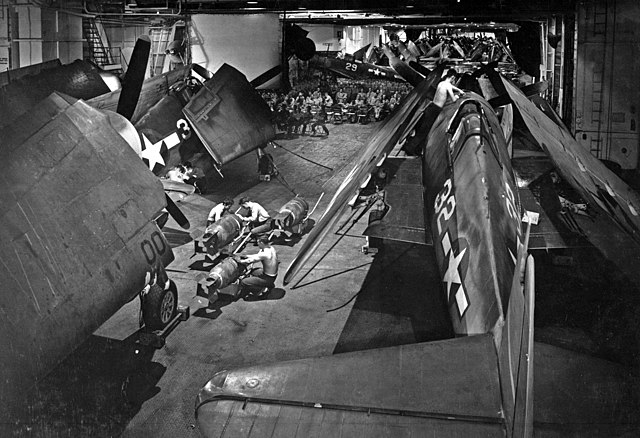
F6F in the Hangar of USS Yorktown, with bombs being installed by the crew, 1943
Since preliminary design for USS Essex, attention was paid on the size of the flight and hangar decks, taking in account takeoff space, heavier aircraft and the current doctrine of “deck-load strike” (launching as rapidly as possible as many aircraft that can be spotted on the flight deck). Interwar first-line carriers were given flush deck catapults, yet still it was rare. By 1945, catapult launches were far more common as doctrine evolved into the way of using these in coordination with spotted planes behind.
Also the hangar area design and its greater strenght were a prerequisite both to support heavier models’s landing, but also internally to carry 50% of each operational plane spare parts aboard, so 33% of the total carried aircraft, all under the flight deck. And there was to be also a sufficient working space below.

F6F Hangar-catapulted onboard USS Hornet
The portside deck-edge elevator was probably the standardized, greatest innovation of the design, combined to two inboard elevators. Already tested on USS Wasp, it was adopted, located on the port side and offering many advantages as well as being less costly in maintenance than regular inboard elevators, as well as not offering a “gate” inside the hagae to burning fuel, debris, or a bomb.
The external lift, located opposite to the island on the port side, measured 60 by 34 ft (18 by 10 m) in platform surface, with a 18,000 Ibs. capacity. The two inboard elevators were squared (but with rounded corners), both 48′ 3″ x 44′ 3″ with a capacity 28,000lbs due to their sturdier four bearings. One was located forward, offset to the centerline to starboard, close to the catapult. It was basically the “hangar-to-launch” elevator supposing for the lifted plane to be lifted up facing aft, then a 90°turn. The second was located was further aft, also offset to centerline starboard, close to the island’s aft twin 5-in/38 turrets.
There were sixteen Mark 4 hook arrestors for both long and short landings, the idea being to spot as many landed planes as possible in stacked at the front, then middle and aft, and offering more possibilities for a landing plane missing the first cables. In all, the USS Essex was provided circa 30 of these, some alternated with heavy-duty models with twin rollers. There were more than on the Yorktowns, but the novelty was a set of arrestor cables across the bow with a performance specification to conduct flight operations while steaming in reverse, which proved handy after typhoons when ships with bukled-up decks had to recuperate their aircraft.
Two catapults were installed, one H4B starboard forward, close to the elevator and one H4A in the hangar. USS Essex was delivered with none. The quicky transverse catapult inside the hangar was located behind the forward elevator. This was a controversial addition, but coherent with previous ships, concerning the Yorktown, Intrepid, Hornet, Bunker Hill, and Wasp. It was launching on the port side. Still in development in 1941 it was omitted on CV-9 but added to the next batch. Use was limited and they were eventually dismounted ath the first occasion. In 1944, all ships had two H4B catapults forward, one Port and one starboard. The ships also carrier 231,650 Gallons in four separated and well below the hull tanks as well as 625.5 Tons or naval ordnance in well protected stores: 0.5 and 0.3 cal. ammunition, bombs, torpedoes and rockets.
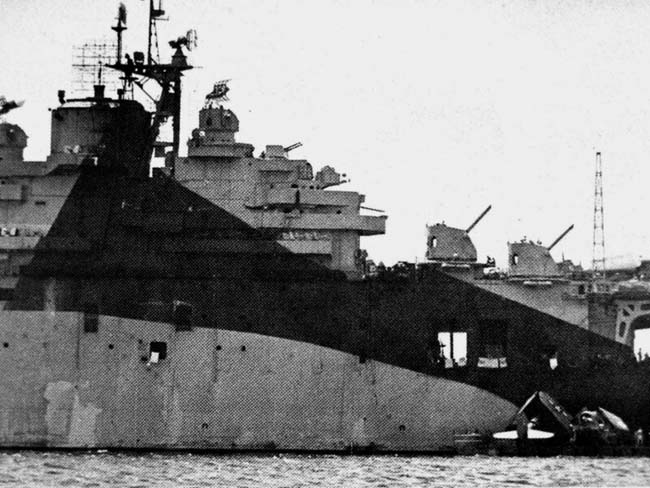
USS Essex refitted to standards in 1944
Protection
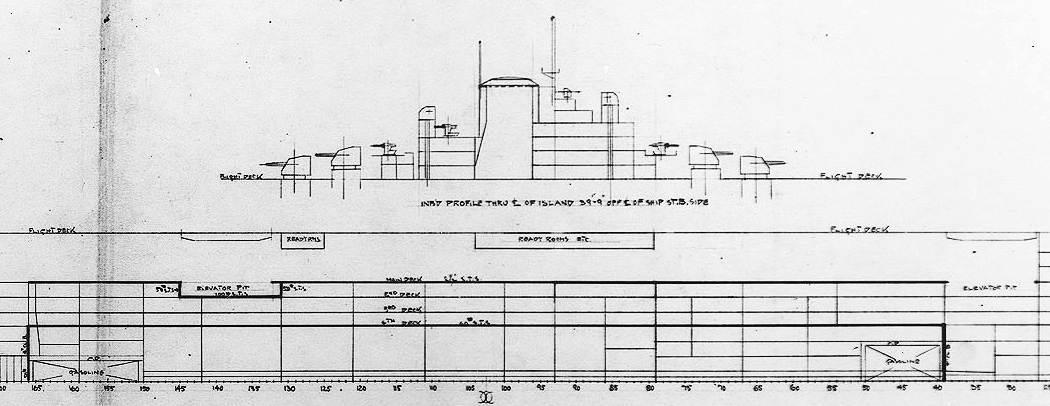
Closup of the preliminary design study
The long discussion leading to the final design secured a compromised protection scheme compared to some of the proposals, notably making them as the first “armoured carriers” of the USN. But as a large air group was the deciding factor, the armour scheme was kept “lighter”, yet still better studied than on the Yorktown class. The large use of STS armor notably as strenght or add-on protection was new.
- Armor Belt: 2.5 to 4 inches (64–102 mm) backed by .75 in (19mm) STS
- Main armor deck: 2.5 in (64 mm) +STS for the hangar deck
- 1.5 in (38 mm) for the STS 4th deck
- 2.5 in STS above the steering gear and aft ammunition magazine.
- ASW compartimentation, longitudinal bulkheads
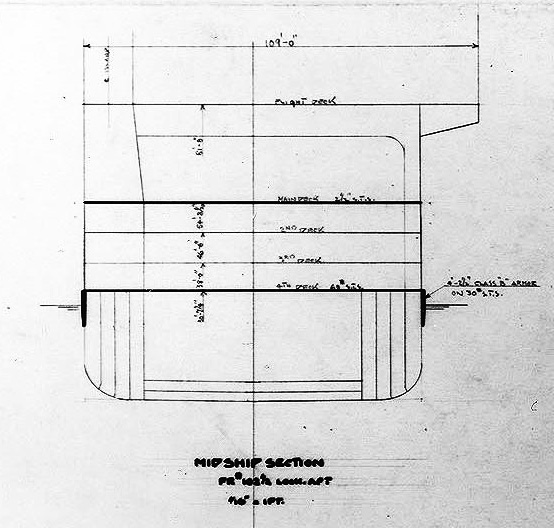
Preliminary design cut section armour figures
The final September 1941 design showed an “open hangar” without bulkheads, but strenghtened elevator pits, hangar floor, and then a two-level “citadel”, the upper one below the hangar deck comprised four decks with armour, larger at the 4th deck, at waterline level, then a second citadel below with proper bulkheads. The avgaz tanks were located deep down, just behind the aft bulkhead. Another pair of avgaz tanks were situated behind the forward bulkhead. The forward inboard elevator had no armoured pit, as it was situated beyond the hangar armoured deck. Officers quarters and mess were situated alongside and forward.
ASW protection received special attention. There was the usual alternated, compartimented powerplant with all boilers and turbines in their own space, but all the spaces below the waterline had a long-studied, intricated internal design integrating the hull’s outer armor plate. The underwater armor extended 17 feet deep below the waterline, with as specified the capability to resist 500 pounds (230 kg) of TNT. At the time this was not enough for the latest Japanese torpedoes, but at least it was designed to moderate the blast and confine the flooding. There were two outer fuel oil tanks sandwiched with two inner void spaces and the frames staggered to avoid transmitting the blast wave too deeply inside. There was an embryo of concept such as the “raft” created in the 1970s to cancel noise in submarines. Of course, a mandatory triple bottom used against magnetic mines ran for almost all the lenght of the ship.

The thin main flight deck armor prevented widespread damage inthe hangar, but not always. Matters were made complicated by the trajectories of shattered planes destroyed in flight by AA.
On the topic of protection, there was a mix of passive (STS armor) and active measures also concerning the aviation ammunition storage and avgas tanks protection, which also reuired a lot of attention: Contraty to navy “heavy” fuel oil, aviation gasoline or “avgas” was highly volatile. Several features were incorporated to safely handling the 240,000 gallons onboard:
The fuel was spread between three tanks, one centerline, saddle-shaped and on both sides, plus another saddle-shaped alongside both of the other two. This allowed to empty these from the outside toward the middle for stability, as they were gradually filled with seawater for ballast but also acting as protection buffers with the center tank.
-The fuel was not pumped directly to the fight deck or hangar deck. Instea, seawater was pumped into the fuel tanks. As the level rose at the bottom the fuel was floating on top, forced up before delivery. This allowed avgas volatile compound vapors lingering in the hangar, at risk of a single spark, with the adantage of seawater to keep the tank pressure always the same, allowing also to drain the risers and empty the fuel supply system on the hangar deck with less risk in case of a fire.
The need of ventilation, also to avoid these gasoline vapors building up in the hangar was recoignised early enough and adressed in part by not armoring the flight deck, allowing for large openings along the edges of hangar deck that could be closed off when needed with rolling shutters. This feature became life-saving on several occasions during the Kamikaze onslaught in 1944-45.
Powerplant

Sailors of an Essex-class carrier cleaning up the propeller at Puget Sound.
While much more powerful than the Yorktown class, the Essex class powerplant was about the same, but upgraded. Indeed, several design innovations were incorporated, with new Steam turbines (chosen over turbo-electric designs) with new gears, placed in four boiler rooms, two engine rooms on the center-line. Each boiler room contained two Babcock and Wilcox boilers.
The four shafts (same four-blade, bronze casted, approx. 12 feets (3.65 meters) in diameter, 27,000 pounds (12,247 kg) propellers*) were driven by four Westinghouse geared turbines, with each paired low-pressure and high-pressure turbines connected to double-reduction gears. They were fed by steam coming from eight Babcock & Wilcox boilers working at 565 psi and 850°F (450°C). The low-pressure turbines were used for cruising, at lower power and shaft revolutions, but bypassed with the steam fed directly to the high-pressure turbine when higher power ws required. This was sufficient for an output, as designed, or 150,000 shp, so far making them the most powerful aircraft carriers until the Midways in 1945.
This compared well to the Yorktown’s 120,000 shp by using Parsons steam turbines coupled with nine B&W boilers. The Essex class boilers were larger and far more efficient, and like in the North Carolina class, the gearing system was brand new and innovative.
Out of it, engineers expected the ships ro reach their design speed of 33 knots (37 mph 60.6 km/h), more than the 32.5 knots of their predecessors. Their large hull was also able to accomodate more oil, enough to reach a Range of 20,000 nautical miles (37,000 km) at 15 knots (28 km/h) thanks to a total capacity of 4758 tons, up to 6330 tons. This was an impressive autonomy, almost twice as large as for the Yorktown class, allowing them practically to cross half the globe in one go, transiting for example from Pearl Harbor to UK via Panama. They were perfectly fitted for Pacific operations.
However in service it was rather 15,440 Nautical Miles as reported. They were also slower than expected, USS Essex making 32.93kts on Trials, with 154,054 hp measured on a shaft, also on Trials. They were relatively good seaboats, reacting well at the helm due to the size of their sole large rudder, but still, they heeled and lost speed on hard turns, and needed 765 Yards (700 m) at 30 knots to make a full turn, not that bad given their 250 m long hull.
For electrical lighting onboard, they relied on four 1,250kW Ships Service Turbine Generators, and two emergency 250 kW Diesel Generators to avoid being totally “dead in the water”. In theory there were backups for pumps to keep the ship afloat. However between explosions and fires some ships like USS Franklin practically lost all power.
* One of these is on display (U.S.S. Intrepid) at the Hudson River and W. 46th Street.
Armament
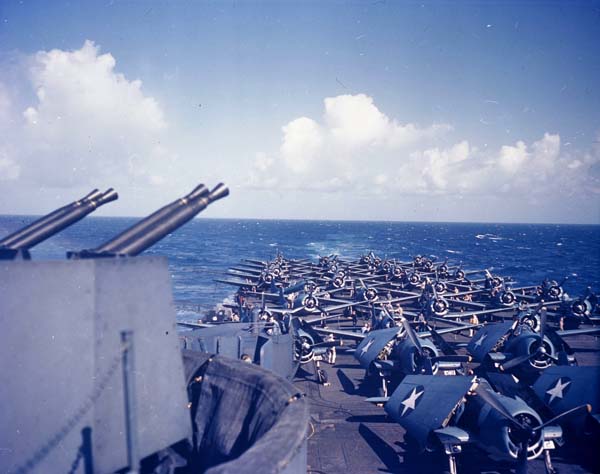
40mm quad watching over parked F6F and TBFs.
The original design planed no less than twelve 5 in/38 caliber gun mounts, four in enclosed twin mounts turrets fore and aft of the island, starboard side, and four single open mounts on the port and starboard corners aft and forward, in sponsons, later reduced to four on the port side only. Both the 40 mm and 20 mm were adopted in the final 1941 design. There was little need of additions in 1944, but the “long hull” at least gave a better arc of fire to the forward quad AA mount.
5-inch/38
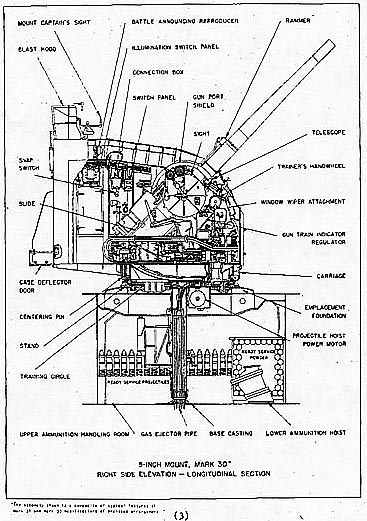
Detailed ONI cutout of the 5-in/38 turret
The ubiquitous 5 inches/38 caliber (127 mm) used by the US Navy. They will be detailed in a dedicated post. These guns had a maximum range of seven miles and a rate of fire of fifteen rounds per minute. The 5-inch guns could fire VT shells, known as proximity fuzed-shells, that would detonate when they came close to an enemy aircraft. The 5-inch guns could also aim into the water, creating waterspouts which could bring down low flying aircraft such as torpedo planes.
Gene Slover’s, US Navy Pages, Naval Ordnance and Gunnery Vol 1 ordnance on the 5-in/38
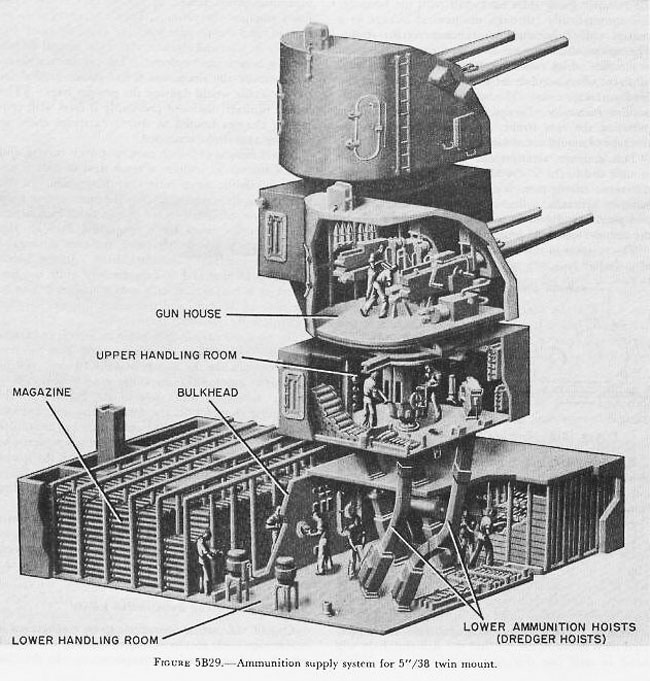
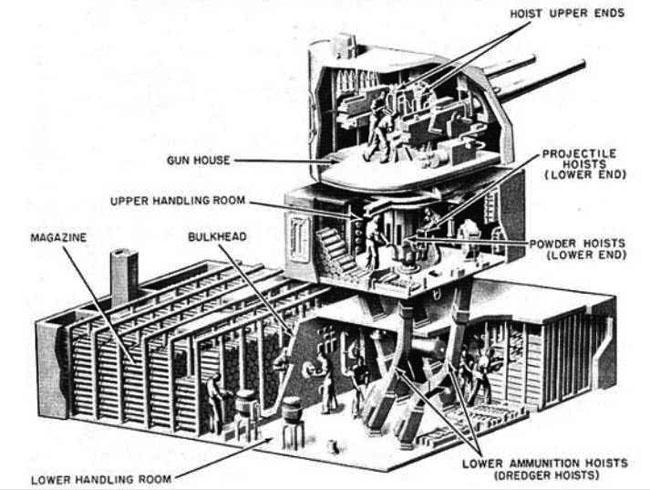

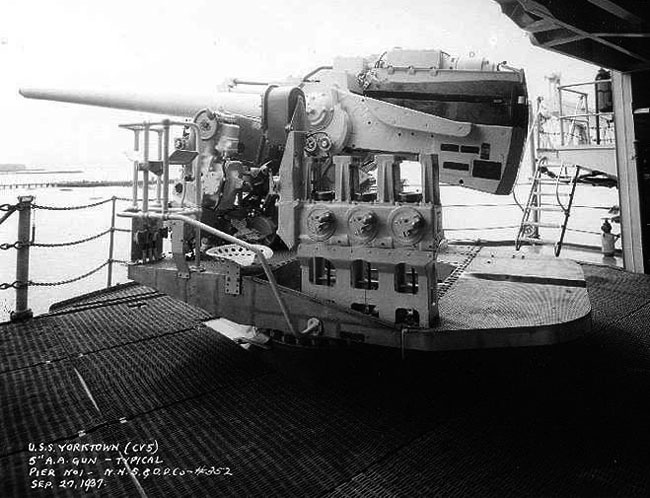
Several photos and tech views (ONI) of the 5-1/38 in turret and pivot mount.
40 mm/60 mark 1.2 Bofors AA
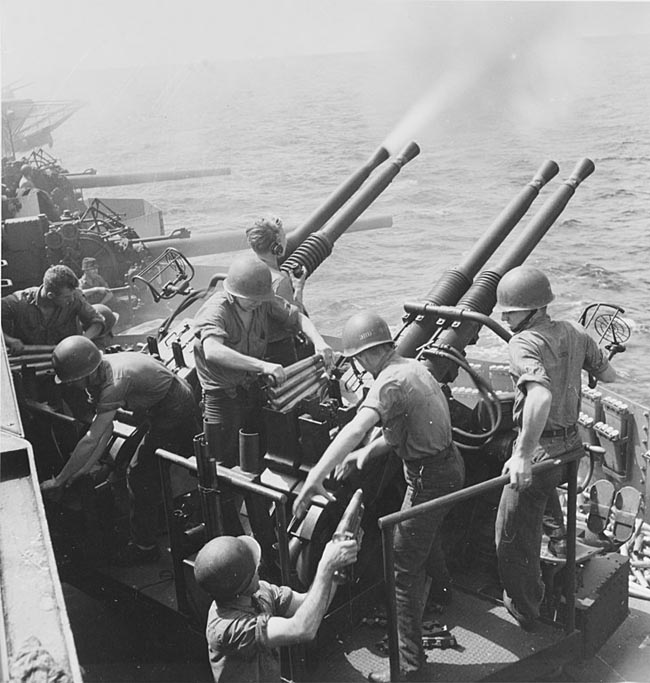
40 mm Bofors with Mk.12 mount quad in action, USS Hornet.
No less than seventeen quadruple Bofors 40 mm anti-aircraft guns were planned, although designs from 1940 integrated the 1.1 in/75 or 28 mm “chicago piano” quad mount instead. There wre three on eiher side of the island starboard (two aft, one forward), superfiring over the 5-in turrets, another one at the bow, another at the stern, both in the axis with a restrictive arc of fire, two in sponsons aft starboard, and two starboard. The 1.1 were never installed, 40 mm were ready instead, and were a significant improvement over the Lexington and Yorktown classe’s AA armament, which also included 0.5 cal. Browning HMGs. The latter were also planned, even integrated into the tripod platform, but never installed.
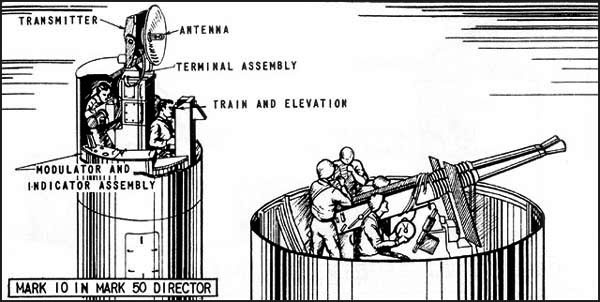
Mk10 radar, 40mm Bofors ONI
20mm/70 Oerlikon Mark 1.2
No less than 65 single Oerlikon 20 mm cannon completed this firepower. They were installed in sponsons alongside the flight deck, the island, fore and aft generally in multiple rows. The largest of these was the starboard aft sponson, behind the N°4 5-in turret and counting ten of these AA guns.
Radars
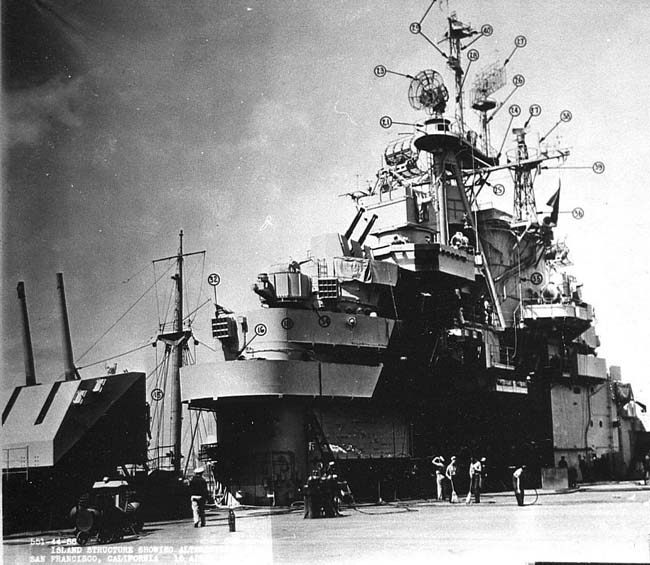
ONI Essex refit close view of the island’s specifics
It is not quite easy to really assess precisely, per ship and date, the electronics suite onboard. Only refits details gave clues. What is certain however, is that all Essex class ships were provided with the latest radars and electonics suite.
USS Essex(CV-9): Had the common SK surveillance radar flatbed antenna, the SC-2, SG radar and two Mk 4 fire control system radars installed atop Mk34 directors fore and aft on the island’s superstructure.
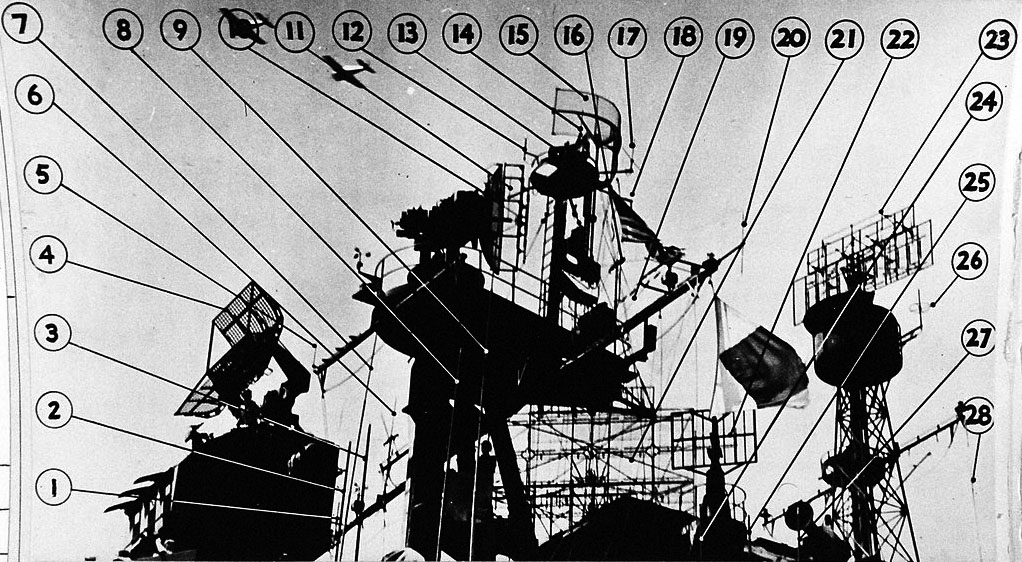
A picture of the antenna arrangement on the U.S. aircraft carrier USS Lexington (CV-16) in 1944/45. Following antennae can be identified:
1-3 , 5-9, 11, 14, 16-20, 24, 25, 28, 29: various radio communication aerials;
4: Mk 4 fire control radar on Mk 37 director;
10: SM radar;
11: SO IFF antenna on the SM radar;
12: CPN-6 radar beacon;
13: SG surface-search radar;
15: YE homing beacon;
21: SK-1 air-search radar with BT-5 IFF;
22: homing beacon;
23: SC radar with BT-5 IFF;
26: ABK-7 identification radar.
src: U.S. Navy Naval Aviation News March 1946
SC-2 Radar
A smaller additional radar (15′ x 4’6″ (4.6m by 1.4m)) to the main model, introduced in 1942 and mostly used by destroyers due to its smaller weight. It was so good that it was seen in use until 1963. Same basic set as the SK but smaller antenna composed of 6×2 dipoles. It was lost in altitude resolution but sill had a PPI display and integral IFF. The 1944-45 models had also antijamming features. Its wavelenght was 1.5 m, pulse width 4 microsecond and Pulse Repetition Frequency 60 Hz, its scan rate 5 rpm, and power 20 kW.
Max Range was 80 nautical miles (150 km) to detect a medium bomber, 40 nm (70 km) for a fighter; On sea, it could detect a battleship at 20 nm (40 km) which was close to useless to react due to the gunnery range.
Accuracy was 100 yards/3° (90m) and resolution 1500 feet/10°(460m), altitude accuracy 2000 feet (600m) for a total weight of 3000 lbs (1360 kg). First batch (Mark 2) was completed in December 1943, second in December 1944 (Mark 4). On the Essex-clas it was generally installed on the mainmast while the SK was installed on a side platform overhanging to starboard.
SK Radar

USS Bunker Hill radar suite
The SK radar was a large bedframe style air search radar introduced in 1943 and used on large ships. Essentially an SC-2 radar set, but with a larger antenna fitted with 6×6 dipoles. it could detect a target like a medium bomber at 10,000 feet ceiling and 100 nautical miles distance. Elevation could be estimated from positions of maximum and minimum signal strength, difference of signals between antenna rows. Used an A-scope with 15/75/375 miles range scale, PPI-scope with 20/75/200 range and even IFF Mk.IV, provided by the vertically polarized antenna, atop the main antenna. It was replaced in 1945 by the SK-2, recoignisable to its large parabolic antenna fed by a dipole. The SK was specific to carriers, destroyers and escorts, replacing the 1941 CXAM-1 radar set.
SG Radar
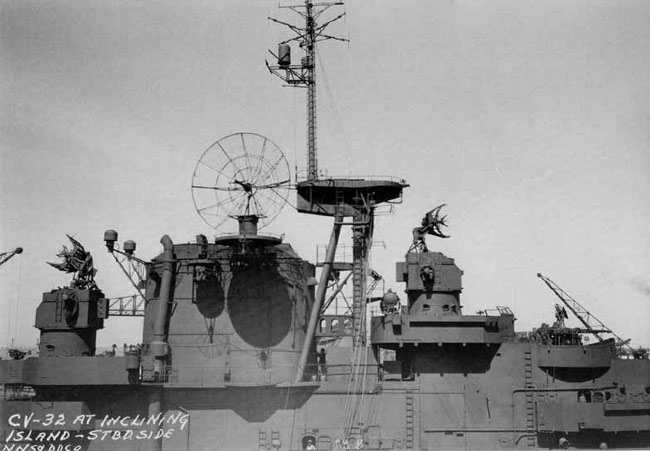
SK Radar and other Essex class island details
A small surface search radar (later SG-1) usually installed on destroyers and CVs as well. Located on the mainmast, it had an A-scope and PPI-scope displays and was able to pick up submarine periscopes at 10,000 yards. 64 km overall range, working at 3000 Mhz, working at 1.3 to 2 µs pulse width. It was introduced in 1942 and produced until late 1943 but served for two decades.
SM Radar
Introduced in late 1943 it was complementary to the SG, a small pole radar combining a flatbed array and parabolic antenna for surface search or a full parabolic model. It was used as a main control radar, and often two were installed to manage the main guns.
SK-2 Radar
Replacement for the SC, it was a lighter but still very large parabolic antenna, main surveillance air and surface radar of the USN, standard in 1944. They were Long Wave Search Sets in the same familiy of the SC and SC-1.
SC-2 Radar
Replacement for the SG in 1944, it had a smaller, lighter and more rectangular bedframe antenna. Also used on destroyers, but present on the axial mainmast onf Essex-class ships commissioned in 1944-45.
CV10, 12, 16, 18 were presuably given the same SK and SC-2, but also the new SG and SM radars as well as two new Mk.12.22 fire control radars.
CV13, 14 and 15, CV19, 20, 31 and 38 were given the 1945 eletronics suite: SK-2 radar (the parabolic one), SC-2, two SG radars, the SM radar, and two Mk 12.22 FCS radars.
CV21, 32, 33, 36, 37, 39, 40, 45, 47 were equipped with the SK-2, the new SR radar, the SG, but also the new SG-6, and a variable number of SP, SX control radars as well as two Mk 12.22, but also two Mk 29, six Mk 39, nine Mk 28 radars and TDY ECM suite all post-war. They were seen in action in Korea and Vietnam.
Accomodations & features
USS Lexington’s Chart Room
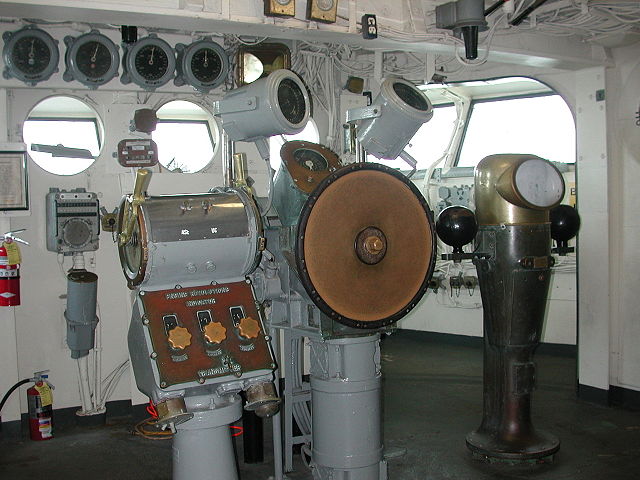
USS Lexington’s Helm
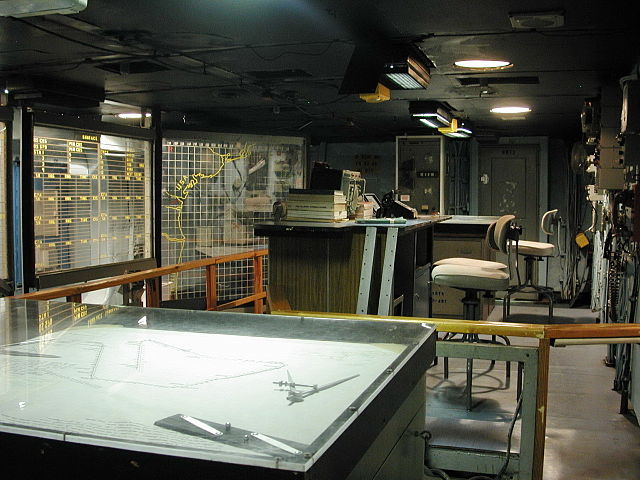
CV-16 Combat Information Center in action
Air Group of the Essex class: The “Sunday Punch”

The carriers’ main advantage (informally known as the “Sunday Punch” due to components proportions) was their all-time offensive power comprising 36 fighters, 36 dive bombers, and 18 torpedo bombers as planned, and acted. Only the initial models carried changed: The F4F Wildcat, SBD Dauntless and TBD Devastator initially planned all discarded for the new generation when the ships entered service. On USS Essex, completed in December 1942 (a fiction as we saw already) were supposed to carry two squadrons of F4F Wildcat, two of SB2U Vindicator (even older!) and/or as complement to SBD Dauntless, and SOC Seagull. The old Vindicator was retired in late 1942 and there is no photo or document proof it was used from her flight deck. It is never mentioned for the other carriers of the class.
The case of the Curtiss SOC seagull is more nunanced. This reconnaissance biplane floatplane was recalled after the fail of its designated successor, the Seamew, due to its abysmal performances. It was generally at this point in 1943 often replaced by the kingfisher when available. And it existed with floats or wheeltrain, so perfectly able to operate from the deck as well. It was related to the use of hangar catapults on the Yorktown class, not repeated in the CV-9 design (This transverse hangar-deck catapult was found however in CV-10, 11, 12, 17, 18, and later removed). But again, the complete lack of photo evidence supposed otherwise. Its already more likely for the Kingfisher although, again, there is no photo or data showing this. The transverse catapults were rarely used in practice as it disturbed mooth hangar operations, a main reason for their removal a the first occasion.
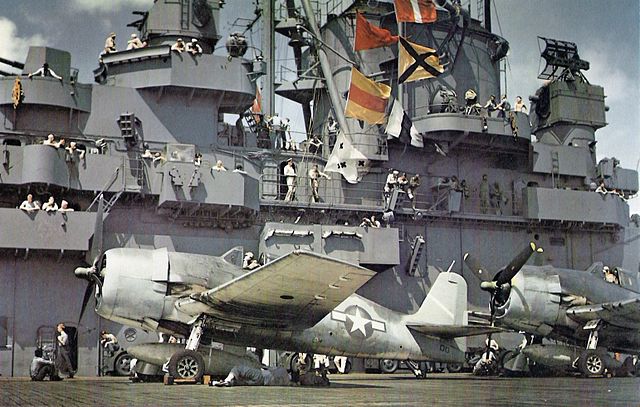
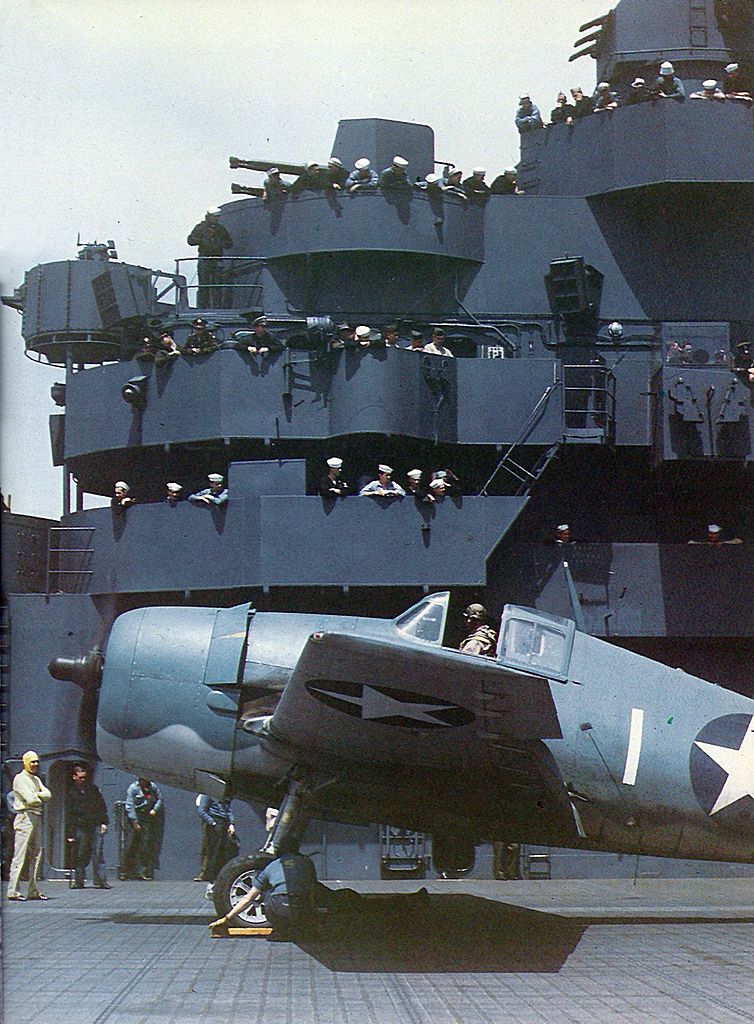
F6F-3, USS Yorktown, 31 August 1943.
-The case of the F4F-3 Wildcat is more interesting. Its designated successor, the F6F was indeed in December 1942 was still not in service, introduced in 1943 an constantly upgraded until November when appeared the F6F-3N night fighter variant. On USS Essex, the first production F6F-3 (R-2800-10engine) which flew on 3 October 1942 reached operational readiness with VF-9 in February 1943. So during her initial post-commission time USS Essex, which was given former USS Ranger’s air group reequipped with the F4F-3 Wildcat in April 1942, but the group was redeployed on USS Essex and only in April 1943 CVG-9 was deployed to the Pacific Fleet, with the F6F and all pilot qualifications made. So, if any indeed operated from USS Essex (again, no photo to back this up) in this transitional phase, it would have been only to test the flight deck and facilities, not in an operational way as the F6F was chosen instead.
Regular air group

Avengers and Hellcats of Carrier Air Group 5 warming up on the flight deck of USS_Yorktown (CV-10) circa late 1943. The Essex class carriers inaugurated the F6F in combat, since USS Essex having them practically at shakedown stage. A marriage made in heaven for the remainder of the war as the plane started to be used massively as fighter-bomber towards the end.
The Grumman F6F Hellcat would be the standard fighter, the Curtiss SB2C Helldiver (at least from early 1944) the standard scout/dive bomber, and the Grumman TBF Avenger its torpedo bomber since the start, also used in other attack roles.

SBD-5, VB-5, CV-10 (USS Yorktown, October 1943). The case of the Douglas SBD Dauntless was another interesting one. This one however is well documented. The Dauntless soldiered on the early Essex class carriers since the Helldiver’s protracted and complicated development dragged on. Dauntless were kept aboard until replaced by the helldiver during replenishment phases or prolongated drydock maintenance/modernization in the US, apparently from early May1944, after the second offensive against Truk. USS Lexington (CV-16) and Yorktown CV-10 used aparently only four SBDs for reconnaissance. The Grumman TBF was used for strikes up to that point. So on some carriers the SBD soldiered for almost one a half year, seeing notably the end of the Solomons campaign and several island-hopping campaigns.
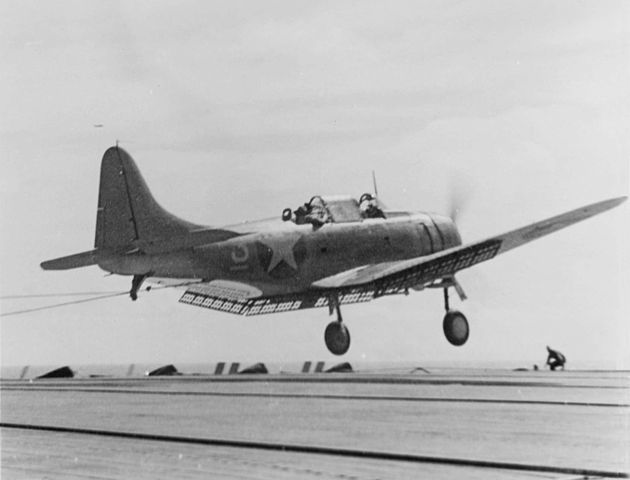
SBD catching wire when landing on USS Essex in 1943.
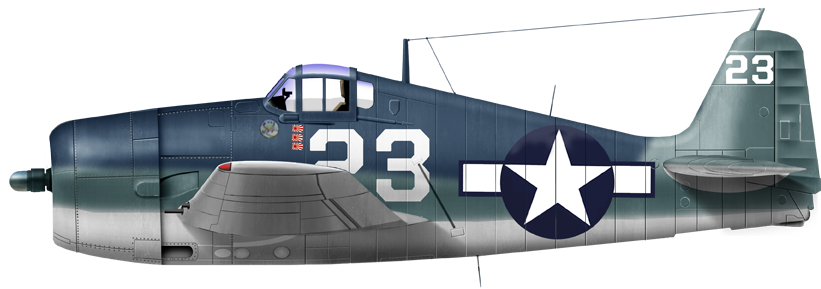
Grumman F6F Hellcat, VF9, USS Essex 1944. On 30 AUGUST 1943, Task Force 15 (Rear Adm. Charles A.
Pownall in command) with USS Essex (CV 9), Yorktown(CV 10), and Independence (CVL 22), launched nine strike groups in a day-long attack on Japanese installations on Marcus Island in the prototype fast carrier strike. TBF-1
Avengers from Independence sank three small Japanese vessels. This second raid against Marcus marked the first attack by Essex- and Independence-class carriers and the combat debut of the F6F-3 Hellcat. (src).
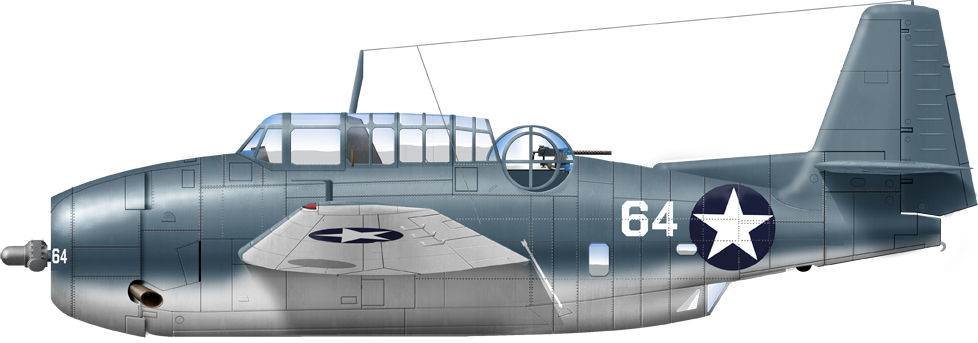
Grumman TBF Avenger, GGG USS Essex 1944
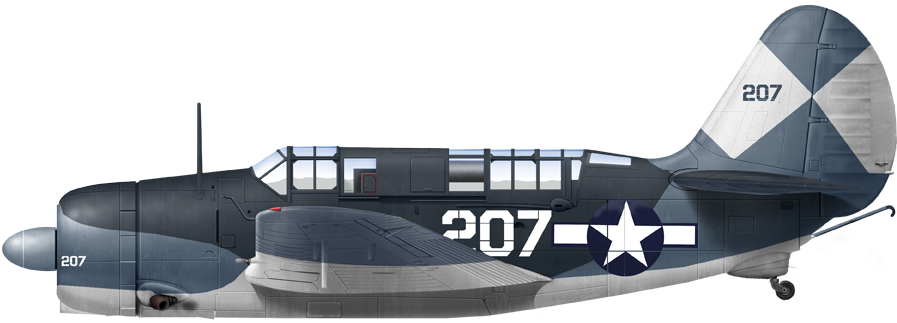
Curtiss SB2C Helldiver, VB-83, USS Essex April 1945
From USS Bunker Hill onwards, the Vought F4U Corsair was introduced into fighter-bomber squadrons (VBFs) as Japanese moslty lost air power at that point. These were the precursors to modern fighter-attack squadrons or VFAs, pioneering doctrine and tactics, and put to good use in Korea. In 1945, all of carrier-based combat aircraft gradually acted as ground attack aircraft, and almost systematicaly mounted underings 5-inch High Velocity Aircraft Rockets (HVARs). They rampaged everything with these, compensating the lack of accuracy by sheer instant firepower on any objective. In the summer of 1945, entire air groups rampaged through industrial areas and ports, but also all remaining shipping over the Japanese home islands.
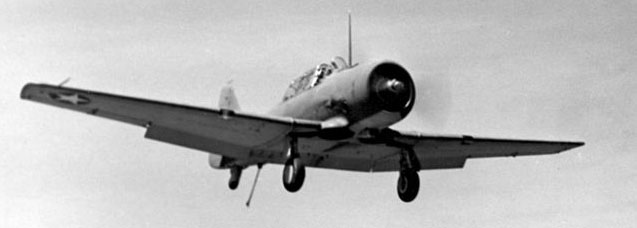
SNJ AT6-Texan, before first landing on USS Bunker Hill 1943. Upon commissioning, flight decks were tested first by North American AT-6 Texan, the standard advanced trainer of the time.
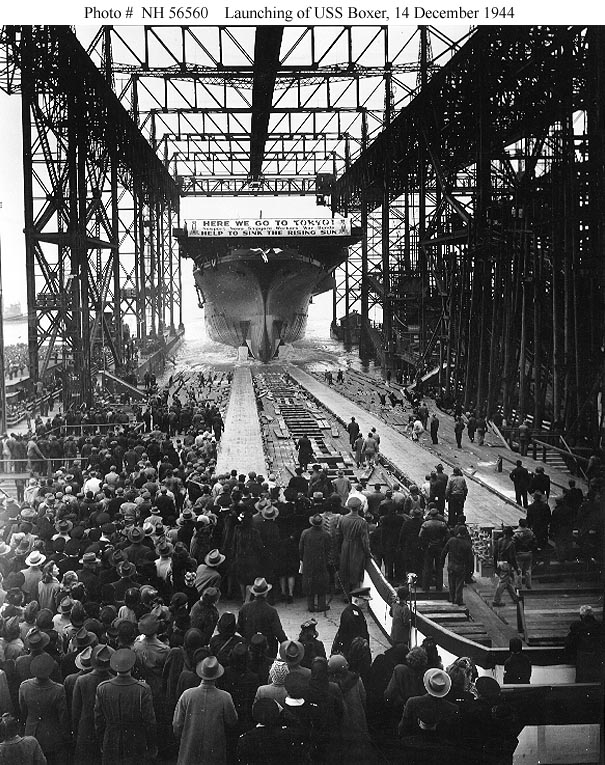
USS Boxer, launch in 1944
Essex class (1942) specifications |
|
| Dimensions | 265.8 x 28.3/45 x 8.38m (872 ft oa x 147.5 ft oa x 27.4 ft) |
| Displacement | 27,208 long tons standard, 34,881 tons FL |
| Crew | 2862 |
| Propulsion | 4 sets Westinghouse geared steam turbines, 8 Babcock & Wilcox boilers |
| Speed | 150,000 shp, 32.7 kts |
| Range | Oil 4758-6330 tons = 15,440 nm/15 kts |
| Armament | 4×2+4×1 5-in/38 Mk 12, 8×4 40mm/56 Mk 1.2, 46x 20mm/70 Mk 4, 91 aircraft |
| Armor | Belt: 64-102mm (4 in), hangar deck: 64 mm (2.5), main deck: 38 mm (1.5) |
The Ticonderoga “long hull” improvements
USS Bunker Hill, 1945
Basically, from CV-14 onwards, which inaugurated this new standard, all Essex-class would be fitted with a longer clipper bow, with increased rake and flare, projecting largely forward of the flight deck edge. The main idea was to procure a better arc of fire for the forward quad 40 mm AA but also improve seakeeping, notably for the flight deck.
But this was not limited to this. Addition of AA was considerable, with plans to almost double the initial 1942 design. They notably gained new sponson 40 mm quad mounts, three starboard close to the island, two aft, lower on the hull side, and as much on the port side. They also were given new, more modern electronics suite, notably with the distinctive SK-2 radar. The USN made no distinction, only Historians and specialists. However this became a new standard and some of these changes were incrementally ported on earlier “short-bow” Essex-class ships nearing completion or back in the yard for an overhaul.
To sum it all up:
- Longer bow, about 10 m increase in overall lenght
- Safer ventilation
- Safer aviation-fuel systems
- Combat information center moved below the armored deck
- Addition of a second flight-deck catapult
- Removal of the hangar deck catapult
- 3rd Mk 37 fire-control director
- New radars suite, notably the SK-2 main surveillance radar
- Increased AA, both 40 mm and 20 mm
Simplifications in design were also an ongoing process, as well as building itself: USS Essex for example needed 15 months to be built, versus USS Hornet (ii), just 12 months, but about 20 months to completion, versus 38 for prewar standards. For comparison a modern CV like USS G.Ford needs 48 months from the keel laying to launch. This was still a far cry compared to Vancouver Kaiser’s yards delivering Jeep Carriers at breakneck pace (3 months to launch for the last one, 5 to completion). The Essex class were infinitely more complex in all areas.
Ticonderoga sub-class (1944) specifications |
|
| Dimensions | 270.7m oa (888 feet), same. |
| Crew | 3000+ |
The Oriskany’s complete redesign
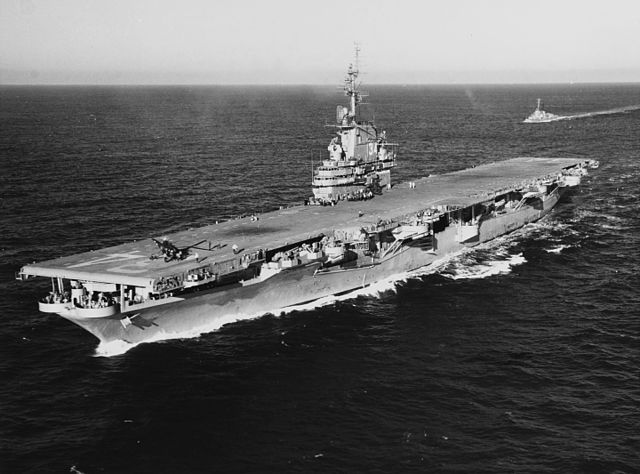
On this chapter, the USS Oriskany appeared as a game changer: The name was assigned to CV-18, renamed Wasp so the when CV-34 keel was laid in 1942, the latter unherited it. “Mighty O” was close to cancellation, as she was laid down on 1 May 1944 in New York and launched on 13 October 1945. So at this point the war was over, and she was already surplus. However she was too advanced for simple cancellation and to be scrapped, so as construction was suspended on 22 August 1946, 85% complete, the admiralty wanted to try digested war lessons, and considerably improve upon the design, dating back to late 1940 essentially.
Therefore, USS Oriskany was redesigned, basically as a prototype for further conversions, named as the SCB-27 modernization program (see later). This was started on 8 August 1947, and engineers still needed to tore down the ship down to a 60% completion stage to have more freedom. A lot of her structure was removed, as to make her able to operate the new generation of carrier aircraft, notably jets.
Engineers were acutely aware these new jets and late-gen piston-powered planes needed a longer, roomier and overall much stronger flight deck, as the structure behind. Both was massively reinforced. Also stronger elevators were fitted, as well as new and much more powerful hydraulic catapults. The arresting gear also followed that trend and was heavy-duty.
Also, the island structure was completely rebuilt, taking in account a lot of observations and reports made abour carrier operations management on board.
The island also supported a new generation of radars, for air and surface surveillance, first warning, tracking, and fire control.
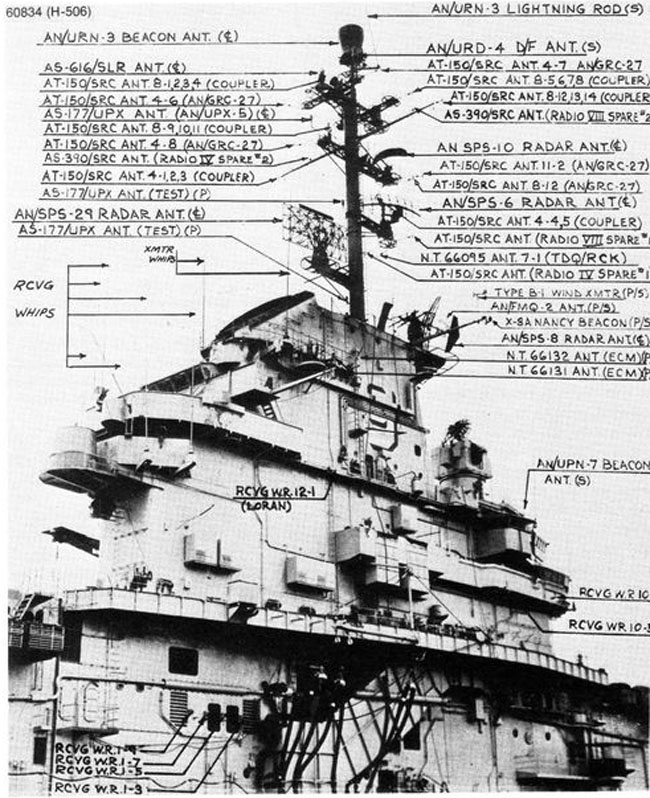
USS Essex SBC-27 electronics suite, ONI
The deck anti-aircraft 5-in/38 turrets were removed. It came as no surprise. Basically they were a prewar request due to limited confidence in fighter’s ability to create an efficient defense bubble around a carrier (and not anticipating the heavy support brought by the surrounding ships). Better weaponry was studied which arrived to maturation in between, the last before the missile age. So it reflected a compromise: The ship still retained eight 5-in/38 guns in sponsons, and forteen 20-mm Oerlikon as a “last-ditch reassaurance” in very close quarters, but it was all completed by the latestn radar-assisted twin mount 28 3-inch (7.6 cm) 50 caliber guns that were to replace the Bofors. The deletion of not only these turrets and Bofors mount allowed to keep the deck “clean” with more space alongside the smaller, more compact island.
Blisters were added to the hull (bulges) not to improve ASW defence, but just raise the cross-sectional in order to boost buoyancy and stability (incidentally also making there for a larger fuel aviation bunker volume). On USS Orikany they were required for the simple reason of the addition of much topside weight, due to a completely revamped and wider, heavier flight deck.
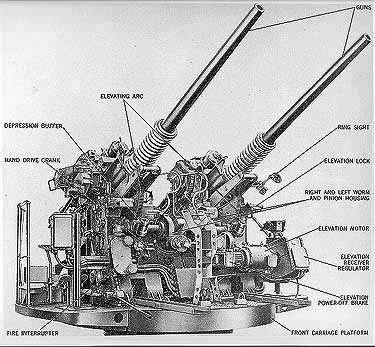
3-in/50 twin guns on USS Oriskany – ONI
After all this, USS Oriskany was commissioned in the New York Naval Shipyard, on 25 September 1950. She would not only validates the SBC reconstruction standard soon applied on nearly all Essex-class vessels, but she would also take part in the war in Korea, Vietnam (7 battle stars), decommissioned in 1976 but only stricken in 1989. But instead, she was repossessed by the Navy and eventually ended after a long mothball in the Beaumont Reserve, sunk as an artificial reef on May 17, 2006, the largest ship ever for this purpose.
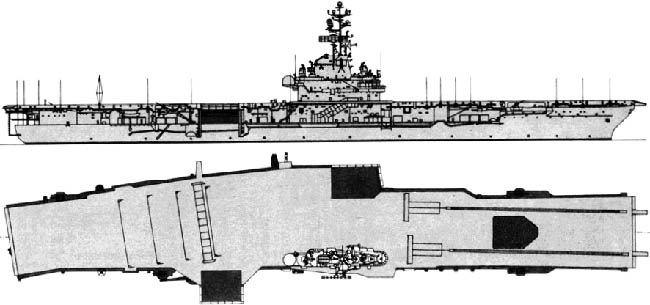
USS Oriskany in 1990
USS Oriskany (1950) specifications |
|
| Dimensions: Flight deck, long overall | 911 feet (277.7 meters) |
| Dimensions: Flight deck, width overall | 195 feet (59.5 meters) |
| Dimensions: Hull’s largest beam | 106.6 feet (32.5 meters) |
| Dimensions: Draft | 30.8 feet (9.4 meters) |
| Displacement | 44,700 tons full load |
| Crew | Circa 4360 |
| Propulsion | No change |
| Speed | 33 knots |
| Armament | 8x 5-inch (12.7 cm)/38 in sponsons, 14×2 3-inch (7.6 cm)/50, 14x 20mm AA guns |
| Armor | Waterline belt 2.5–4 in (64–102 mm), Deck: 1.5 in (38 mm), Hangar deck: 2.5 in (64 mm), Bulkheads: 4 in (102 mm) |
The Essex class in operations: Organisation, Tactics, Supply/repair
Essex class airstrikes tactics

F4U corsair, back in 1945 on Essex-class carriers for fighter-bomber tasks.
Tactical employment changed as the war progressed. In 1942, the doctrine implied a single CV, or a pair launching an combined air strike. This allowed to keep together a sizeable CAP for close defence. But this was the theory. The pair worked well in that under attack it multiplied the AA protective screen and split the enemy efforts by dispersing the targets. Combat experience however in 1943 hurt this theory enough that noew doctrine were to be tested.
Discussions went on and as the new Essex class were soon available, tactics adapted towards more combined strength. The combined AA fire of the entire task group and their combined screen created a protective umbrella against marauding enemy aircraft. The carriers thus were rarely separated, especially from 1944. The size of the escort grew considerably also, with the delivery of more cruisers and destroyers.
Two or more of task groups supported each other, making by their sum a fast carrier task force. Lessons learned with the operation of a single group of six CV, or split into two groups of three, or three groups of two, helped to test many new tactics which all eventually were codified in task force operation manuals in 1945.
The evolution of the fast carrier task force, combined with preparatory strikes, peripheric strikes to isolate the island targeted, then on-groung close support, combined with a protective CAP, and the cruisers and battleships reconnaissance planes to search beyond radar range, do search and rescue missions, or ASW patrols, were all defined in 1944-45.
The use of radar also considerably shortened the response time to an incoming threat, CAPs being projected in an “inner” and “outer bubble”, one launched far in advance for a long-range interception, the other kept for closer defence, and the combined task force AA being the ultimate “steel wall” at closer range. It should be noted that from late 1943, the Essex-class had a smaller night-fighter CAP with specially trained and equipped F6F Hellcats. It well complemented the first radar warning which worked at all time, day and night.
The fast carrier force organization
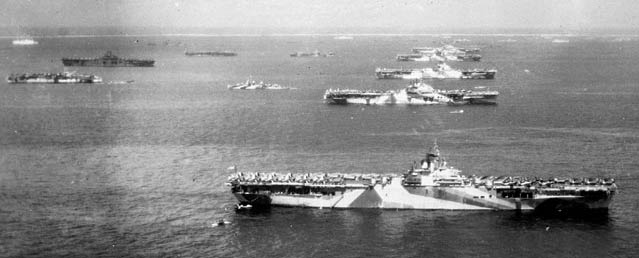
“Murderers row”, TF 38 at Ulithi Atoll, 3rd fleet carriers at anchor, 8 December 1944.
By far, of course, TF 38/58 (the name only reflecting a change in leadership), also called the “fast carrier task force” was the pivot of all USN counter-offensives in the Pacific from August 1943, concentrating all Essex-class carriers, which really were its bedrock. At that stage the only aircraft carriers left from the interwar were USS Saratoga and Enterprise, including in this same unit. At its peak in December 1944, it concentrated more combined firepower than any other task force in history, with 17 carriers, 6 battleships, 13 cruisers, 58 destroyers, and a total of 1,100 aircraft, increased for the Battle of Iwo Jima in early 1945. But it was born in August 1943, built around USS Saratoga under the command of Rear Admiral Frederick C. Sherman.
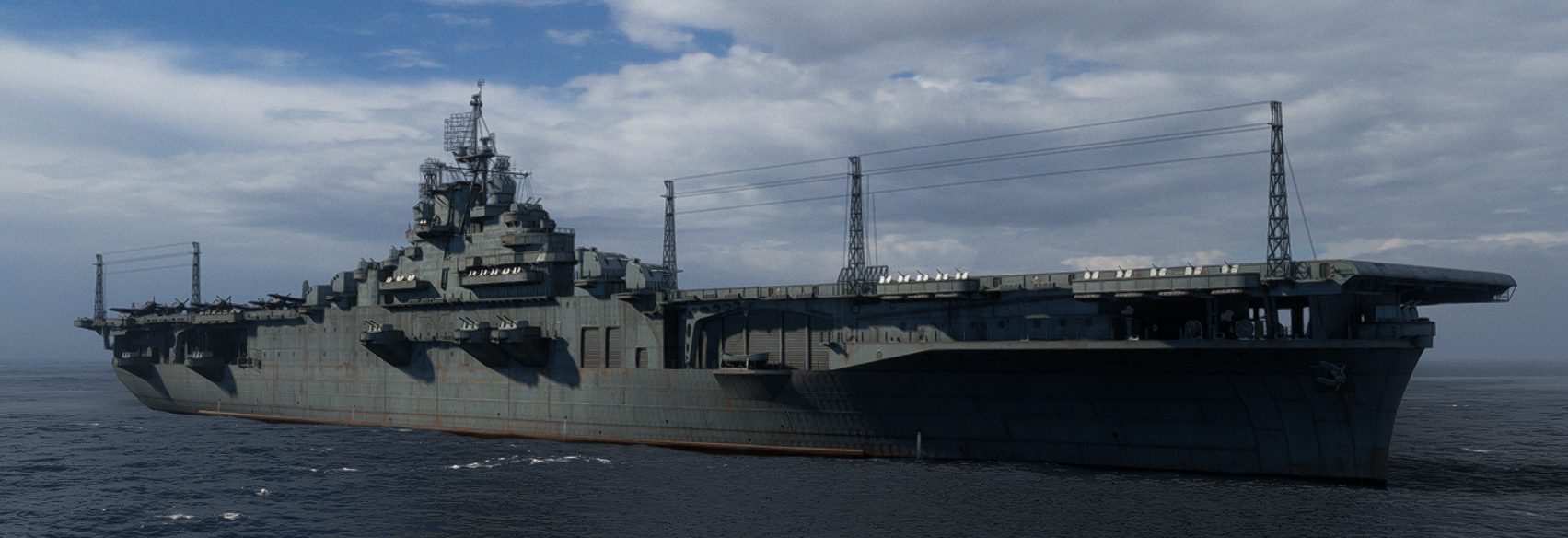
USS Essex as completed Dec. 1942


USS Essex in the pacific 1943 (world of warships)
Task Force 38 and Task Force 58
TF 38 was really the barinchild of Admiral Mitscher. However the overall command alternated between two Raymond Spruance and William “Bull” Halsey, two very different personalities. Spruance, calculating and cautious, and “Bull” Halsey, far more aggressive and gambling his assets. These were dividing personalities. Officers in general preferred to serve under Spruance while most common sailors preferred Halsey, certainly more accessible. TF 38/58 fell under overall command of Admiral Chester Nimitz.
The name reflected its belongings: With Spruance’s Fifth Fleet, under Mitscher, this was Task Force 58 (6 January 1944). And under Halsey, Third Fleet (Vice Admiral John S. McCain Sr) it became Task Force 38. Planning for upcoming operations was completed when each admiral and staff rotated out of active command, allowing a higher operational tempo and misleading the Japanese into believing naval assets were much greater than in reality. That demoralization however did not bear fruits as much as expected.

Vice Admiral Marc A Mitscher aboard USS Lexington CV-16 June 1944
The Task Force was often split between Task Groups (TG) to simultaneously attack different objectives related to the main one (in general assaulting an island). Their role, before the amphibious fleet was there, was to interdict the sky to the enemy in the while area and destroy all visible installations on the island itself. This traduced into distant sweeps aiming at destroying all surrounding Japanese airfields, notably to ensure no attack will come over the Amphibious fleet when assaulting the beaches.
It was especially vital with the rise of Kamikaze attacks from mid-1944 to mid-1945. The logical conclusion was that when closing with Japan itself, notably for the assault of Iwo Jima and Chichi Jima were taken care of by separate TGs. The latter operated still close enough to mutually cover themselves in case of a massive air attack on one or the other TG. This ensure the Task Force to always keep maximum protection and maximum striking power at all times. The main objective of the fast carrier task force was to enable operations for the much larger 3rd or 5th Amphibious Force tasked to provide support to the Marines, and maintained operational at sea by Service Squadrons to resplenish it (see below).
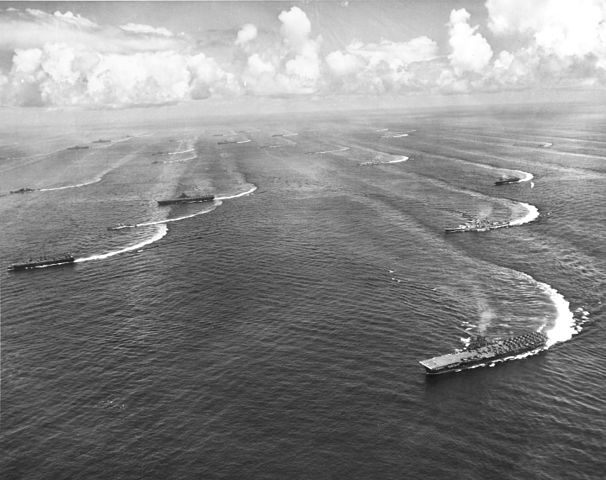
Task Force 38 off the coast of Japan 1945
The first “textbook” operation by TF 38 was Operation Hailstone, a massive combined air strike combined with surface vessels attacks on Truk Lagoon on 17–18 February 1944. This was a crippling defeat for the latter, with the main airfield obliterated, all installations visible in the harbor and around it, and all shipping as well, including many military vessels. With TF 58, the fast carrier force comprised nine CVs and eight CVLs, the latter operating in support, dedicated to the CAPs, leaving the fleet carriers to lead the air strike.
Detailed organization on 1st May 1945
The FIRST CARRIER TASK FORCE, PACIFIC (Com1stCarTaskForPac) was under command of Vice Admiral M. A. Mitscher (30)
The SECOND CARRIER TASK FORCE, PACIFIC (Com2ndCarTaskForPac) was commanded by Vice Admiral J. S. McCain (21).
| CardDiv 1 | R. Adm. F. C. Sherman | CV 9 ESSEX CV 15 RANDOLPH CVL 22 USS INDEPENDENCE CVL 25 COWPENS |
| CardDiv 2 | R. Adm. C. A. F. Sprague | CV 13 FRANKLIN CV 19 HANCOCK CV 38 SHANGRI-LA CVL 30 SAN JACINTO |
| CardDiv 3 | R. Adm. T. L. Sprague | CV 10 YORKTOWN CV 16 LEXINGTON CV 36 ANTIETAM CVL 24 BELLEAU WOOD |
| CardDiv 4 | R. Adm. G. F. Bogan | CV 17 BUNKER HILL CV 11 INTREPID CV 39 LAKE CHAMPLAIN CVL 28 CABOT |
| CardDiv 5 | R. Adm. J. J. Clark | CV 12 HORNET CV 18 WASP CV 21 BOXER CVL 26 MONTEREY |
| CardDiv 6 | R. Adm. A. W. Radford | CV 14 TICONDEROGA CV 20 BENNINGTON CVL 27 LANGLEY CVL 29 BATAAN |
| CardDiv 7 | R. Adm. D. B. Duncan | CV 6 ENTERPRISE CV 31 BON HOMME RICHARD |
CarDiv 11 (based around Saratoga) and CarDiv 12 (around USS Ranger) were both part of the Commander Carrier Training Squadron, Pacific, under R. Adm. R. E. Jennings. USS Enteprise ws the sole interwar aicraft carrier still in active, frontline duty (Carrier Division 7) until 1945.
Supply and repairs- Service Squadron Ten:

USS Essex refuelled at sea underway by USS Tallulah off Luzon, late 1944 (navsource)
Service Squadron 10 comprised hundreds of support vessels which resupplied and maintained TF 38/58.
Alongside the numerous changes of advanced bases for replenishing the ships of TF 38/58, there was a whole organization for the supply chain across the Pacific and back to Pearl Harbor and the homeland, as much as an impressive feat in itself as the rest. It concerned supplies of food, fuel, ammunition and all possible naval and air ordnance, aviation gasoline, navy oil, a galaxy of spare parts, and all in between. Due to the frequency of “supply runs” made by the fast carrier force, this organization comprised all the ships needed to maintain a fleet fully operational far from any base. In 1944 for example, to keep a steady operational pace under halsey, refuelling at sea was pioneered and perfected.
The years of the interwar Navy Bureaus and shipyards believed that a repair ship or tender could provide everything needed beyond minor repairs. but in actual combat, crew’s ingenuity proved time and again, the ships could be maintained at sea and repaired whenever they were, with all the skills necessary to not to sail back home for drydocking. By December 1942 was created the predecessor to Service Squadron Ten, comprising all the ships needed for relatively extensive repairs: They fitted for example USS New Orleans (CA 32) with a temporary bow (made of coconut logs!) after the Battle of Tassafaronga, so she could sail to Australia.
Occurence of ships having their bows blown off, sterns blasted away, massive hull gashes and such a structural mess and internal chaos that all previous expectation fell of battle damage fell short. With a closer, more extensive help, Essx-class ships could remain at sea as long as possible, before completing if needed the task in Pearl Harbor, and then Home for the most serious devastation. It was only a matter of local capabilities. The effort of the crews of all these specialized ships is as heroic in their efforts as any servicemen. Service Squadron Ten notably, attached to T38/58 enabled the it to keep “ressurecting ships” the Japanese believed and announced sunk, time and again.
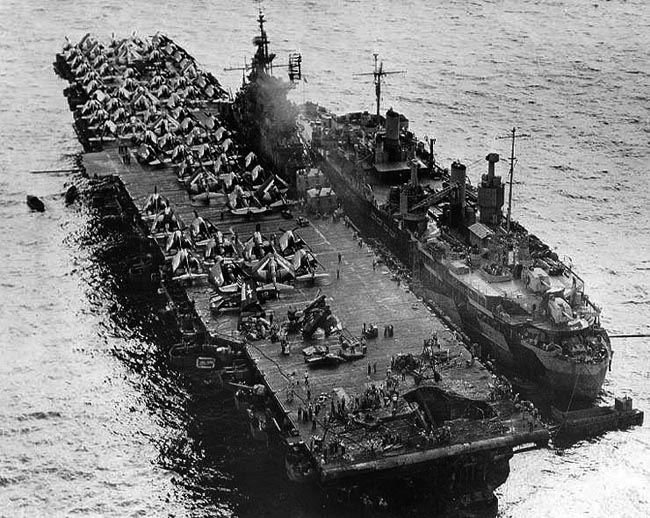
USS Randolph under repair, Ulithi 1945
Squadron Ten comprised a fleet of floating drydocks, repair ships, tenders, crane barges and auxiliaries, allowing them to perform all major repairs needed to battle damaged Essex-class aircraft carriers. Floating drydocks in particular, large enough to accomodate a battleship, proven absolutely critical in restoring these to seaworthy and operative conditions. By February 1945, for example a superb demonsratin of the collective skill and knowhow of this was performed when repairing for example 60 feet of flight deck on USS Randolph (in 18 days !), creating a new bow, replacing guns, electrical equipment burned by fire, even structural beaming. In February 1945 alone, some 52 USN vessels were repaired in floating drydocks. Randolph repairs at sea would remain at the pinnacle of the genre in US history, allowing the ship to sray on duty insetead of departing for a long trip and much longer repairs at home which would have retired her from operations until the end of the war.
SBC-27/125 cold war reconstructions
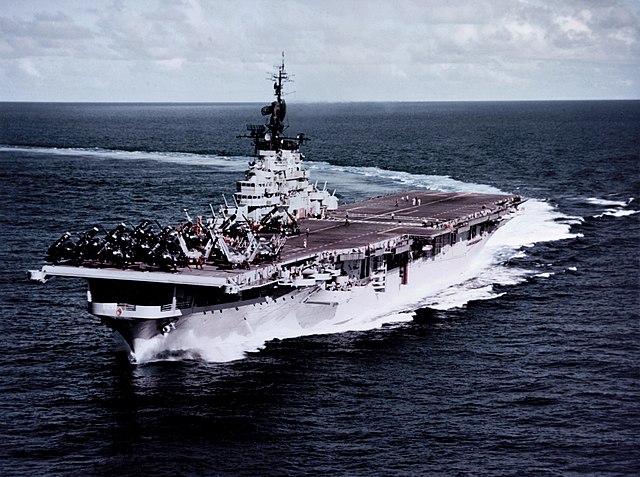
USS Philippine Sea July 1955
Note: This post is split in two, the cold war SBC-27 and career will be seen separately in 2022. The following career focus here on WW2 and the years preceding their reconstruction.
The term “SCB” refers to “Ship Characteristics Board (Program)”.
Foreworld
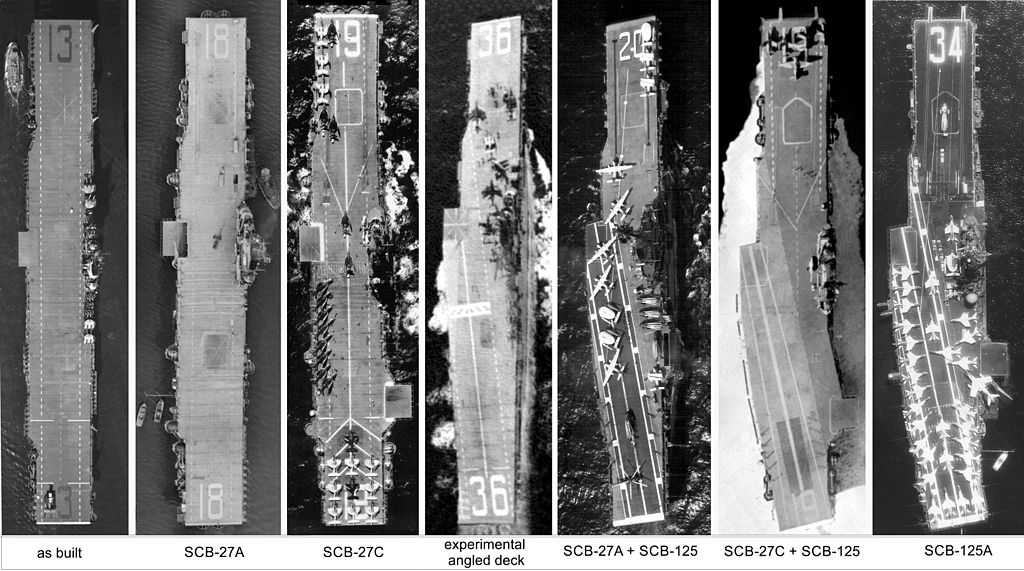
The range of modernizations of the class in the post-war era, exemplified by their flying deck
The construction of the Essex-class aicraft carrier, as well as other mass-built ships for the USN during the war led in 1947 to an assessment of what was to be mothballed and kept in reserve afterwards. The need of the USN gradually decreased in the peace time context, and gradually all carriers, after some service notably for veteran repatriations in 1946 were placed in decommission and reserved in the Atlantic and Pacific. In June 1950 however, the Korean war started and in addition to all Essex-class vessels still in operation, it was chosen to reactivate many of those in mothballed. Since aviation and radar technology made headway in between, it was assessed what ships would be taken in hands to be converted. Most were, the only exception would be the most battered carriers in 1945 like Randolph and Franklin.

USS Bunker Hill (CV-17) moored at San Diego, 1970.
It was soon assessed that the spacious hangars could accommodate jets, but still various modifications were necessary to significantly improve the capability of the ships to handle these heavier, faster jets. Among the modifications detailed for the Oriskany, only SBC-27 carrier, the improvements included for the first time jet-blast deflectors (JBDs), a optical landing system (a British wartime innovation) but also greater aviation fuel capacity thanks to the additional hull bulges and the new angled flight deck really separating and better managing landing and launching aircraft operations. This was the only way to make due with a fundamentally limited flight deck, both in lenght and width. It really became the bedrock of cold war carrier operations at large as the system is always the same as of today, the flight deck only getting wider in proportion (double), with side lifts.
The navy could work with 15 ships, extra ones being deleted due to exetensive wartime damage. These mostly ten short-hulls, along with five long-hulls. The last nine completed stayed as they were in complement to the three Midways. Together they really became the backbone of the post-war US Navy’s combat strength, so they was no rush before laying down the keel of a new generation of “supercarriers” completely tailored to operate jets long-term: The 1954 Forrestal class.
The Truman administration poswar economies sent three active and umodified Essex class into mothballs in 1949, but most were recommissioned after the Korean War start and the ten short-hulls and thirteen long-hulls saw active Cold War service, as eight SBC-27A, and six SBC-27C plus USS Oriskany (total 15). The last six received a second modernization wave called SBC-125/125A and other went into this upgrade later as well, in all, all but one in fact, the last recommissioned in 1958 (see later for further details).
![]()
USS Ticonderoga (CV-14) through Sunds Strait, 24 April 1971.
USS Oriskany was really the prototype for all these changes, and a first batch of eight earlier ships were rebuilt to the Oriskany design standard (SCB-27A program) in the early 1950s, then six more to the 27C design, differing by their catapults mostly. The USS Antietam, “in her juice” still when rebuilt in 1952, received an experimental 10.5-degree angled deck, which really was groundbreaking at the time. She also was fitted with and enclosed “hurricane bow” (no longer separated bow and flight deck lip), both distinctive features of the new SCB-125 program, undertaken at first concurrently with the last three 27C conversions. It was applied to the 27A /27C but USS Lake Champlain. USS Shangri-La also became the first operational angled deck aircraft carrier in operations in 1955, Oriskany ironically was the last angled-deck conversion, leading to a rather unique SCB-125A refit, consiting in bringing her to the both the 27C standard and 125 standard, with an aluminum flight deck to keep the weight down.
The Korean War saw the deployment of mostly unconverted carriers, notably “expending” the battered Bunker Hill and Franklin. From 1955 seven unconverted Essex class vessels were converted as a cost-saving measure to anti-submarine warfare carrier (CVS). Also when the Forrestal-class entered service, eight SBC-27A converted shios were redesignated CVS in turn, taking the rol of the unconverted ships, soon mothballed. Also, two 27C conversions became CVS also in 1962, and two again in 1969.
SCB-144 program: The kast upgrade they received was a bow-mounted SQS-23 sonar. The admiralty waited until there were a sufficient number of serviceable supercarriers to have them decommissioned, from the late 1960s to the mid-1970s. The very last active ship was USS Lexington, still in 1991 a training ship. Four were ultiately preserved as museums (see below). The “prototype” USS Oriskany was studied for a possible conversion and the Reagan administation contemplated another wave of modernization that woul be applied to all the remaining vessels still not broken up. But that plan was eventually scrapped. Their design, more than 40 years old, was now showing.
SBC conversions in detail
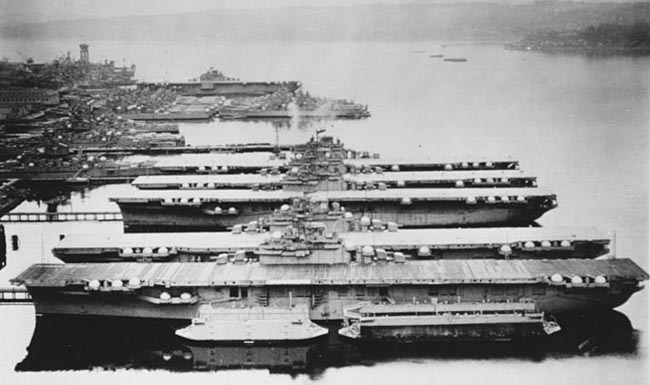
USS Essex mothballed at Puget Sound Shipyard, 1948
Popularly known in the navy as the “Two Seven-Alpha” or “Two Seven-Charlie” it really saved the whole Essex class from the scrapyard, also ensuring the best use of taxpayers money in a peace time context where the cold war was getting “hotter” several times. All in all, this endeavour, still costly, but less than building new carriers from scratch, allowed the fleet to keep a disposable stock of aircraft-carrying multipurpose platforms. They had well-understood limits, notably they only could operate first-gen jets, but not the heavier next ones for which the “super-carrier” fleet was created.
SBC-27:
The sum of modifications made on USS Oriskany, namely:
1-Flight deck structure significantly reinforced to handle 52,000 pounds (23,587 kg) planes(*)
2-Stronger, larger elevators
3-Standard, but improved hydraulic catapults)
4-Mk 5 arresting gear
5-Removal of 5-in/38 turret, all 40 mm, most 20 mm guns.
6-Eight Twin 3-inch/50 gun mounts installed with prox. fuses
7-Same new clipper bow for all ships
8-New bridge island taller, but more compact
9-Brand new electronics and radar suite
10-Ready rooms (gallery deck) moved to below the armored hangar deck
11-Large escalator starboard side amidships for flight crews up
12-Aviation fuel capacity increased to 300,000 US gallons
13-Pumping cap. to 50 US gallons (189.3 L)/minute
14-Two emergency fire and splinter bulkheads
15-Fog/foam firefighting system
16-Improved water curtains + cupronickel fire main
17-Improved electrical generating power
18-Improved weapons stowage and handling facilities
19-Removal of the armor belt
20-Fitting of blisters, 8-10 feet (2.4-3.0 m) width increase
*The twin-prop North American AJ Savage as given as an example, and this allowed to carry also later the Tracker, but also the Skywarrior and F-8 crusader fighter, while they even operated in the 1970s the modern A7 Corsair II.
SBC-27A
1-All SBC-27 modifications (two years conversion)
2-New H 8 slotted-tube hydraulic catapults
SBC-27C
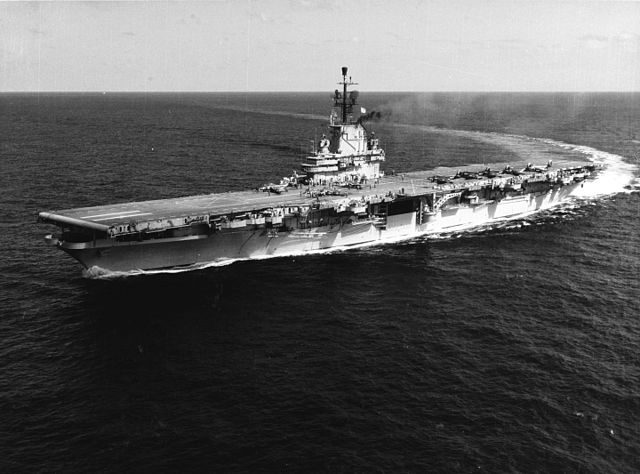
1-New C 11 steam catapults
2-Wider bulging abeam (103 feet)
3-Jet blast deflectors
4-Deck cooling
5-Fuel blending facilities
6-Emergency recovery barrier
7-Storage and handling for nuclear weapons
8-No.3 elevator to the starboard deck edge
SBC-125
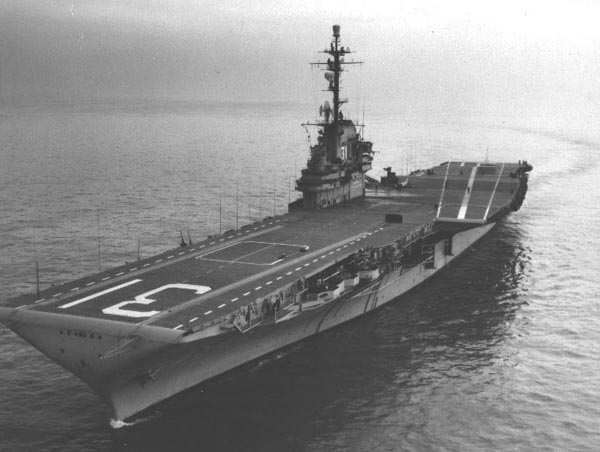
1-New Angled deck (later ported to SBC-27C ships)
2-Enclosed hurricane bow
3-More powerful C 11-1 steam catapults
4-Addition of aluminum flight-deck cladding
5-Mk 7-1 arresting gear
6-Mirror landing system
7-Primary Flight Control moved to aft end of island
8-Air conditioning
9-No.1 elevator lengthened (for SCB-27C)
10-No.3 (aft) elevator moved starboard deck edge (SCB-27A)
Later Air Groups:
![]()
CVW-19 ticonderoga air group, 1970
These will be seen much in detail in the future SBC-conversion/Cold war Essex-class page. The Essex class after the war operated virtually nearly all planes and jets types of the 1950s-60s but the heaviest, which became the norm in the mid-1960s and confined to super-carriers. Instead, they continually operated models such as the piston-planes Skyraider and A4 Skyhawk in Vietnam, all and types of helicopters. In between, they operated the F7F Tigercat, FR Fireball and F8F Bearcat from 1945, F2H Banshee, F9F Panther, F6U Pirate, F3D Skyknight during the Korean war, the TBM-3S Avenger, AF Guardian, D-W Skyraider, F9F-P Cougar, TBM-3R Avenger, HUK Huskee, HUP, HO4S/5S/HRS Chickasaw helicopters after it, and in the early 1960s, the F3D Skyknight, F9F Cougar, FJ Fury, F7U Cutlass fighters, AU Corsair, AD Skyraider, AJ Savage attackers, HUK Huskee, HSS Seabat/HUS Seahorse helicopters (also in the SCB-125/SCB-125A) which saw action in Vietnam. The very last LPH conversions of the late 1960s-early 1970s carried typically 30 to 40 helicopters (HUP, HO4S/HRS Chickasaw, HO5S, HUS Seahorse, HR2S Mojave).
The Essex clas now: Four Museum ships
Four Essex-class ships were preserved, reconsitioned and opened to the public as museums ships at New York City, in texas, California, and South Carolina, so covering three cardinal points on the east coast (2) gulf of Mexico (1) and west coast (1), later joined by USS Midway at San Diego.
USS Lexington (Corpus Christi, California)
USS Lexington at Corpus Christi, CA.
USS Intrepid, New York.
USS Intrepid museum (panoramic), NYC.
A well-known and appreciated rendez-vous point for history buffs and tourists in NyC. It present on the flight deck all types of aircraft in the USN and many more.
USS Yorktown (Patriot’s Point, South Carolina)

USS Yorktown could be visited today at Patriot’s Point, Mount Pleasant, in South Carolina.
USS Hornet, Alameda
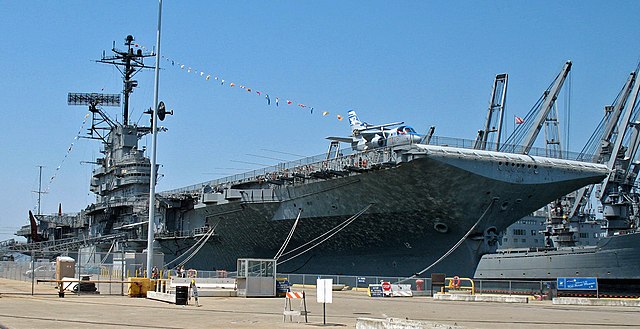
USS Hornet amchored in Alameda, California
Overall, the seventeen Essex class commissioned before V-Day and fourteen deployed in combat operations played a very large part in the victory in the Pacific, redefining the capital ship concept for the decades to come (and it’s still central today). Collectively, the Essex-class ships amassed 88 battle stars despite their entry somewhat “late” in operations. The absolute record-holder would ever be USS Enteprise and its unsurpassed 20 battle stars.
The following career list excludes aircraft carriers commissioned after the end of WW2: USS Princeton (CV-37, commissioned 18 November 1945), USS Tarawa (CV-40, 8 December 1945), USS Kearsage (CV-33) (March 1946), USS Leyte (CV-32, 11 April),USS Philippine Sea (CV-47, 11 May 1946), USS Valley Forge (CV-45, 21 November, USS Oriskany (CV-34, 25 September 1950) rebuilt and modernized before commission.
 USS Essex (CV-9)
USS Essex (CV-9)
USS Essex CV-9 leaving San Francisco on 15 April 1944
USS Essex was the first aircraft carrier of the famous class to be completed, on 31 December 1942, symbolic date that was pushed up artificially as she had been launched in July, so barely six months had passed since. For such complex ship, especially the lead vessel of a new and important, large and very complex class, that was unrealistic on a technical standpoint, only symbolic. Indeed, she made quick yard trials, which showed she needed many fixes, masking the fact she was bearly fit for service. Under her new captain, the crew trained in February-March, she made her shakedown cruise and although officially commissioned much earlier it was around April that she was ready for service and ordered to the pacific in May 1943.
After a stop at Pearl Harbor, she started her career with Task Force 16 against Marcus Island. On 31 August 1943, she became flagship of TF 14, striking also Wake Island (5 and 6 October). This was also called TG 59.18, and assembled also her sister ships USS Lexington (ii), Yorktown (ii), the fast carriers USS Cowpens, Independence, Belleau Wood, escorted by the heavy cruisers USS New Orleans, San Francisco and cleveland class USS Birmingham, Nashville, Santa Fe, Mobile, DesRon48 USS Hull, Hazelwood, Bancroft, Caldwell, Coghlan, Braine, Halford, DesDiv96 USS Kidd, Bullard, Chauncey, DesDiv49 (John Rodgers/SF,DF, Harrison, Murray) and DesDiv50 (Ringgold, Sigsbee, Schroeder, Dashiell), DesDiv91 (Conner, Burns), DesDiv92 (Boyd, Bradford) src. The operation was a preparatory strike before retaking the island, but aside the damage made to the installations, airfield and ships around, it also indirectly caused the execution of all 98 POWs from December 1941. 3/4 of the garrison were however left to starve to death when the island was completely isolated, left to “rot” until officially surrendering in September 1945.
On 11 November, USS Essex took part in carrier operations against Rabaul, a large strike with USS Bunker Hill and USS Independence. She was later assigned with Task Group 50.3 (TG 50.3) for a raid against the Gilbert Islands and took part in covering the amphibious assault of the Battle of Tarawa. She refuelled at sea and was sent with TG 50.3, this time as flagship, for the attack Kwajalein, 4 December 1943. Her After covering this second amphibious assault she mived to her next target, the Marshall Islands on 29 January-2 February 1944.
As TG 50.3 fusioned with TG 58.1 and TG 58.2 to create Task Force 58 or famous “Fast Carrier Task Force”, she participated in the largest air strike yet on Truk (17-18 February 1944). Eight Japanese warships were sunk and many frighters, oilers and other utility vessels, plus installations and airfields ravaged. While underway to the Mariana Islands in order to savage Japanese supply lines, TF 58 was spotted and attacked later by a massive bomber wave, followed by another. Launching all available fighters and using a vigoruous AA barrage, both were repelled successfully. TF 58 arrived and launched a coordinated first strike on Saipan, Tinian and Guam, all on 23 February 1944.
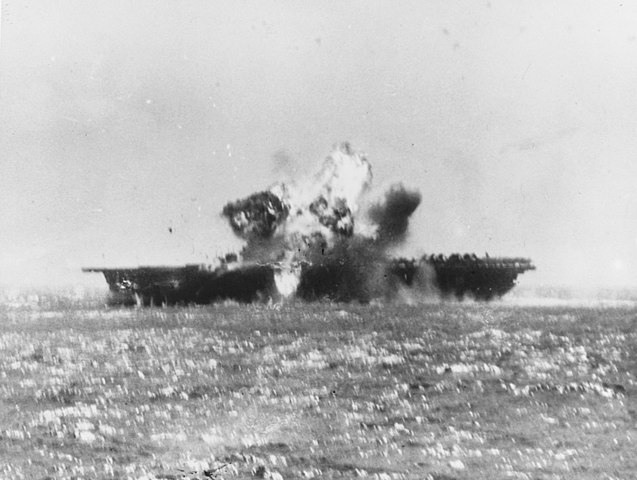
USS Essex hit by a Kamikaze, 25 November 1944
By that point, USS Essex needed an overhaul after nearly one year of service and proceeded to San Francisco for her single major overhaul in which she was also updated to the new standard set by USS Ticonderoga. Assigned Air Group 15 (“Fabled Fifteen”, David McCampbell, top scorer and ace for the USN) she trained and joined USS Wasp(ii) and San Jacinto, as part of TG 12.1. They were sent to anothr attack on Marcus Island, on 19-20 May 1944, followed by Wake, on 23 May 1944.
Joining TF 58 she was present during the gradual occupation of the Marianas, 12 June-10 August. Detached with TG 38.3 she made a strike on Palau Islands (6-8 September), and Mindanao (9-10 September) sinking enemy shipping as planned, disrupting supply in the whole area. She remained to cover landings on Peleliu. On 2 October 1944, she was struck by a typhoon and later was reassigned to Task Force 38 for the Ryukyus operations.
Until the end of the year, she was in continuous frontline action: Strikes against Okinawa (1 October), against Formosa (1-14 October), Leyte landings, Battle of Leyte Gulf (24-25 October) search for remaining escaping vessels until 30 October and back to resplenish at Ulithi. When she was back in November 1944, she started airstrikes on Manila and the northern Philippine. On 25 November, she was hit by a kamikaze which went through the CAP and AA barrage, hitting her flight deck’s port edge. By that time, parked planes were fuelled, causing extensive incendiary damage, with 15 killed, 44 wounded.
After quick repairs at sea with a USN mobile workshop she returned with TF 38 operating off Leyte. She covered the landing on Mindoro (14-16 December 1944), weathered the famous and deadly Typhoon Cobra, sendin planes in search of survivors afterwards. Detached with TG 38.3, she participated in the Lingayen Gulf campaign: Formosa, Sakishima, Okinawa, Luzon. She also searched for enemy targets in the South China Sea, and destroyed shipping wholesale, while conducting more strikes on Formosa and along the China coast as well as Hainan and Hong Kong. She weathered a third typhoon without much damage and on 20-21 January 1945 was made ready to launch another raid on Formosa, then Miyako-jima and ultimately Okinawa on 27 January.
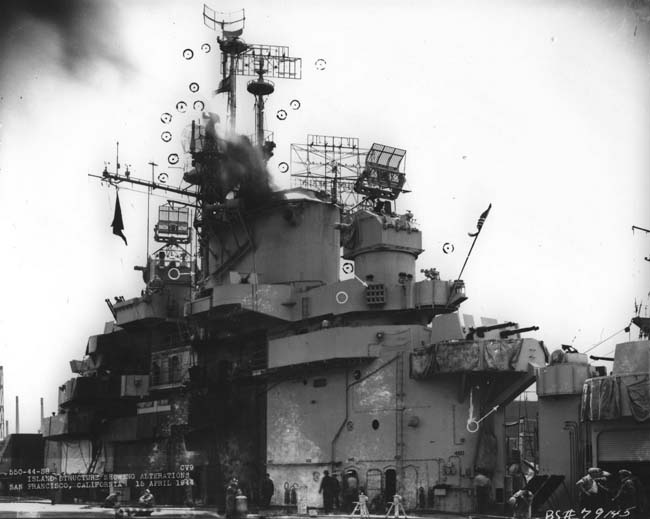
ONI photo showing USS Essex’s refits details for the island
She stayed with TF 58 for the next months, between strikes on Okinawa and nearby idlans and rampaging the Tokyo area and Japanese coast on 16-17 February. On the 25th she made strikes against airfield to negate any air support, before covering the landings at Iwo Jima, and in between resplenishing and striking the Japanese coast she stayed in support against Iwo Jima close islands. From 23 March (until 28 May) her next and last campaign was against Okinawa. In July-August as Okinawa was aslmost entirely mastered, USS Essex took part in the large raids on Japanese home islands, starting on 10 July, and concluding with the ceasefire on 15 August 1945. For her service, USS Essex won 13 battle stars, added to the Navy Expeditionary Medal (3) and National Defense Service Medal (2). However her service was only starting. She was to return every cent of the taxpayer money during her long and active life, helped by her light damage taken during her Pacific campaign.
After remaining for defensive combat air patrols until 3 September 1945 she was ordered to Bremerton (Washington) to be deactivated, carrting persobal with her, but not participating in “Magic Carpet”. On 15 September her general state was assessed and preservation measures were taken. On 9 January 1947 then officially decommissioned and placed in reserve. In 1950 she has been selected for modernization, and “unpacked”, then drydocked to proceed with a SBC-27 type Modernization, earning notably a new flight deck, new streamlined island superstructures, masts radars and air group and the fully recommissioned on 16 January 1951 (Captain A. W. Wheelock). She would take part in the Korea war, served afterwards in the Atlantic and Mediterranean fleets, then participated to the Bay of Pigs and Cuban Missile Crisis, was involved in the nautilus incident in 1966, the Tupolev Tu-16 incident in 1968, participated in the Apollo program as recovery carrier, until eventually decommissioned on 30 June 1969 at Boston.
 USS Yorktown (CV-10)
USS Yorktown (CV-10)
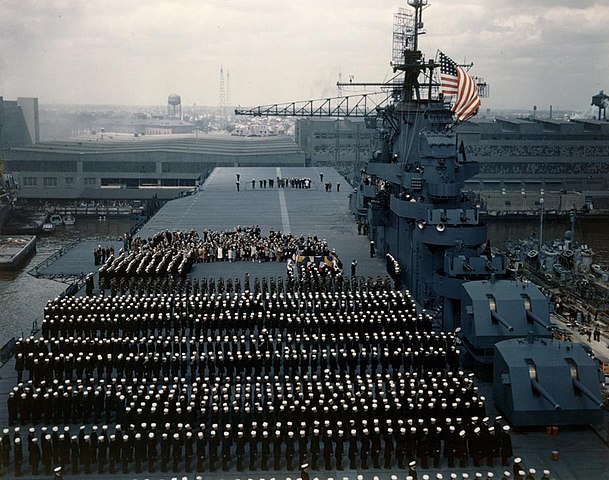
Commissioning of USS Yorktown (CV-10) on 15 April 1943
She was previously called USS Bonhomme Richard on 1 December 1941 in Newport News but renamed on 26 September 1942 to commemorate the original USS Yorktown (CV-5) lost at Midway in last June. Launched on 21 January 1943, and sponsored by the first lady, Eleanor Roosevelt, she was commissioned on 15 April 1943 under command of Captain Joseph J. Clark. She trained at Naval Station Norfolk until 21 May, then departed for a shakedown cruuiser off Trinidad. Back to Norfolk on 17 June for fixes until 1 July, then prepared for air operations off Norfolk until 6 July. She left with her air group Chesapeake Bay and headed for the Pacific Ocean via the Panama Canal, arriving in Pearl Harbor on 24 July for exercises. On 22 August, she was judged ready for her first combat mission, assigned to TF 15. She sailed to 128 miles (206 km) from Marcus Island on 31 August, making airstrikes, and back to Hawaii.
On 9 September, she was sent for the US West Coast, San Francisco to load aircraft and supplies to Pearl Harbor. USS Yorktown was back to combat on 29 September and on 5 October started a round of air strikes on Wake Island, then on 6 October until retiring to Pearl in the evening.
On 10 November, USS Yorktown met with famous Task Force 38 to participate in the invasion of the the Gilbert Islands. On 19 November she was posted off Jaluit, Mili Atoll to launch airstrikes. She also supported the amphibious assaults on Tarawa, Abemama, and Makin.
On 22 November, she concentrated upon installations and the airfield at Mili before making it back to Pearl Harbor and en route, strafing Japanese instalaltion at Wotje and Kwajalein (4 December). She spent christmas in traing and crew leave in Hawaiian waters.
Marshall campaign (Jan-Feb 1944)
On 16 January 1944, she participated in Operation Flintlock against the Marshall Islands, attached with the Fifth Fleet as TF 58, more precisely Task Group 58.1 for her own unit. On 29 January she was ready for the first airstrikes with USS Lexington(ii) and Cowpens, starting at 05:20 on Taroa airfield, Maloelap. On 30 January she was launching airstrikes against Kwajalein with the landing taking place on 31 January, followed by close support missions. In February the routine was the same, until the 4th retiring for replsnishment in Majuro Atoll.
For four months, she participated in operations in the Marianas, striking Truk Atoll (16–17 February) Saipan (22 February) and Majuro area. She operated from Espiritu Santo (New Hebrides) in March, hiting notably the Palau Islands and on 1 April, Woleai before being back to Majuro.
Technicolor USN documentary “the fighting lady” 1944
New guinea campaign (March-April 1944)
On 13 April, she headed for New Guinea and attacked Hollandia and the Wakde-Sarmi area (northern New Guinea). On 22–23 April, this was close support for assault troops. Afterwards, another strike on Truk lagoon (29-30 April) and back to Majuro on 4 May, then Oahu (11 May) for maintenance and training. On 29 May she was back to Majuro and prepared for Marianas operations, starting on 6 June with TF 58. Her launch point was to prepare the invasion of Saipan. But she also attacked airfields of Guam until 13 June. This was followed by attacks on the Bonin Islands. She then took part in the Battle of the Philippine Sea back with TF 58.
Yorktown in the battle of the Phillipines (June 1944)
On 18 June she was back with TF 58, she started intense airstrikes on Guam on 19 June. Throughout the battle, Yorktown’s air group continued to strike Guam airfields to deny any interference; She also foiled Japanese carrier raids, her pilots claiming 37 enemy planes, dropping 21 tons of bombs on Guam. On 20 June, she chased the fleeing enemy task force and contact was made at 15:40, Yorktown launching 40-plane at 16:23-16:43, later finding Ozawa’s force at around 18:40. The 20-minute attack saw her crippling IJN Zuikaku but she failed to sink her. Other ships were tarhested, hits made, but no ship sunk per se. On 21 June, the chase was out and she stopped air searches.
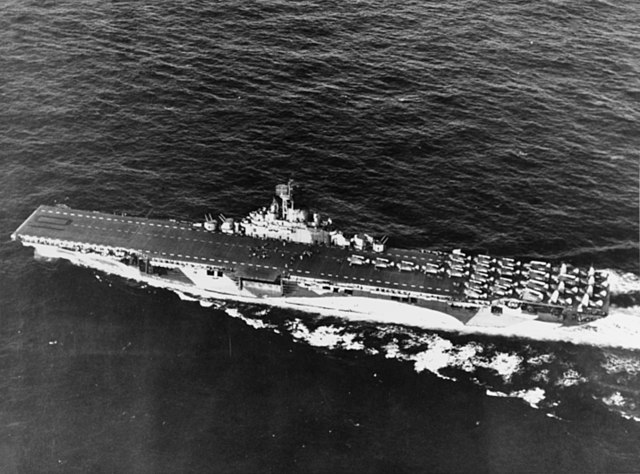
USS Yorktown CV-10 underway during the Marianas operation June 1944
Mariannas/Bonins campaign (Summer 1944)
Back to the Marianas area and resumed air strikes on Pagan Island on 22–23 June. On 24 June, she launched for the first time airstrikes on Iwo Jima. On 25 June, she headed for Eniwetok and on 30 June, ws back to complete operations in the Marianas and Bonins. On 3–4 July she made another series of striked on Iwo Jima and Chichi Jima. On 6 July, she was back for cupport operations in the Marianas until 23 July, followed by striked on Yap, Ulithi, and the Palaus on 25 July. On 31 July, she left the Mariana Islands, stopped in Eniwetok and sailed to Pearl Harbor before hading back to the United States, Puget Sound Navy Yard for an overhault srating on 17 August, lasting two-month. She was back on 6 October, departin and stopping at the Alameda NAS (11-13 October) to load her ne air group and supplies. Stopping at Pearl Harbor 18-24 October she arrived in Eniwetok on 31 October (meanwhile missing the second battle of the Philippines). She departed on 1 November for Ulithi and being assigned to TG 38.4 as flasghip.
Phillipines campaign (Fall 1944)
TG 38.1 launched air strikes in the Philippines in support of the Leyte invasion. Detached on 23 November she was in Ulithi until 10 December and back to TF 38, tready for more striked on 13 December, notably on Luzon in preparation for the main invasion planned for January. On 17 December, during her retirement she was hit by a typhoon which also sank three destroyers, so she participated in rescue operations znd was back to Ulithi on for Chritsmas, and crew’s leave, preparing for 1945 operations.
China sea operation (Jan 1945)
Back with TF 38 she launched air strikes on Formosa (now Taiwan) and the Philippines, notably around Lingayen’s airfields (3 January) and Formosa again, the other targets for the next week. On 10 January, she attacked new objectives in the South China Sea, entering via Bashi Channel. On 12 January, her air group attacked Saigon and Tourane in Japanese-occupied French Indochina. No major ship of the IJN was spotted here. TF 38 aviators neverthless gained a record tally sinking 44 enemy ships, comprising 15 warships. On 15 January, they attacked Formosa and Canton, and next, Hong Kong. On 20 January, she left the south China sea via Balintang Channel and led another raid on Formosa on 21 January, then Okinawa on 22 January, before reslpenishing in Ulithi.
Iwo Jima & Okinawa (Feb-May 1945)
USS Yorktown sortied on 10 February with TF 58 attached to the 3rd Fleet, and later becming the 5th Fleet (Raymond A. Spruance) and launching a series of raids on Iwo Jima in preparation ti the assault. On 16 February, she was detached for strikes on the Tokyo area and Honshū. On 17 February, these were the Bonins, Chichi Jima (18 February) and afterwards close support on Iwo Jima until 23 February, followed by new detached strikes on Japan. On 26 February she raided installations on Kyūshū followed by a supply stop in Ulithi (1 March).
On 14 March she resumed strikes on Japan and preliminary support work for Okinawa. On 18 March, her air groups were again rampaging over Kyūshū, Honshū and Shikoku when at circa 08:00, a single twin-engine bomber, likely a Yokosuka P1Y “Frances” pierced the defences and appeared in position to launch on her port side. Her AA damaged it and it splashed in the water on her starboard side, followed by another “Frances” also destroyed. This was the closest the aircraft carrier was to danger up to that point in the war… Three Yokosuka D4Y “Judy” dive-bombers however later appeared over her and launched an attack, with two misses and a third that his her signal bridge, going through the first deck, exploding near her hull, punching two large holes and killing five, wounding 26. Although not “a scratch” she remained fully operational. She resumed air striked until 20 March.
On 21 March, she took position off Okinawa, for softening-up strikes alla along the island on 23-28 March, before being detached for more striked in Japanese waters. On 29 March, she also made two photographic raids over Kyūshū but the same afternoon at 14:10, a single “Judy” Kamaikaze made a dive on USS Yorktown, hit by AA and splashing approx. 60 ft (18 m) from port. On 30 March, she was back to attack Okinawa and surrounding islets. On 1 April, she covered tje first assault ashore and went on for six weeks, retiring every three days for refueling but on 7 April when a Japanese task force centered round IJN Yamato was spotted steaming south.
USS Yorktown launched all her planes available, starting the onslaught on the pride of the Japanese Navy. 9 of her pilots claimed torpedo hits and at least three that their 500 lb (230 kg) bombs hit also IJN Yahagi. Strafing runs also savaged destroyers, claiming one left ablaze and probably sinking. Back to Okinawa, there was another Japanese air attack on 11 April, a single-engine plane was splahed by her AA. On 11 May she sailed to attack the Ryūkyūs, claiming another plane underway. On 11 May, TG 58.4 was sent to Ulithi for upkeep and a well-deserved crew’s rest.
Late Operation (Summer-winter 1945)
Yorktown bas back in Ulithi but departed on 24 May with TG 58.4 rejoin forces off Okinawa. On 28 May, Halsey relieved Spruance (now 3rd Fleet) but the routine went on over Okinawa alternatied with strikes on the Japanese homeland. On 4 June, she went through a typhoon and on 6–7 June, resumed Okinawa support, followed by raids on Minami Daito Shima and a sweep off Leyte, San Pedro Bay (13 June) for replenishment, upkeep and rest and back with the fast carriers force against the home islands.
From 10 July she was operated off the coast of Japan, Tokyo area and Honshū and Hokkaidō, until 15 July, then refueling retirement, heavy weather until 18 July, and a raid over Yokosuka. Until 22 July another replenishment and a raid on Kure, the Tokyo area, northern Honshū, southern Hokkaido and from 10 August back to Tokyo. On 13 August her air group attacked Tokyo for the last time and she retired to refuelling earning the end of the war a day afterwards.
Waiting for instructions, she was ordered eats of Honshū to provide cover for occupation forces landing. After mid-September and formal surrender she started to air-drop supplies to Allied POW stil not liberated and entered Tokyo Bay on the 16th, and headed for Okinawa in October, Buckner Bay to load passengers and back home.
She was in San Francisco Bay on 20 October, Alameda NAS until 31 October, then Hunters Point Navy Yard and in November reporting to take part in “Magic Carpet”, return servicemen home. She made another trip in December, stopping at Manila and back to San Francisco in January 1946. Sent later in Bremerton for deactivation and long term preservation, formally decommissioned on 9 January 1947 in the Pacific Reserve Fleet.
She left the reserve to be rebuilt to SBC-27A standards, recommssioned 2 January 1953, in Korea, then reclassified CVS-10, 1 September 1957, used in Vietnam, Decommissioned 27 June 1970, stricken June 1973. She earned 12 battle stars and the Presidential Unit Citation for her WW2 service.
 USS Intrepid (CV-11)
USS Intrepid (CV-11)
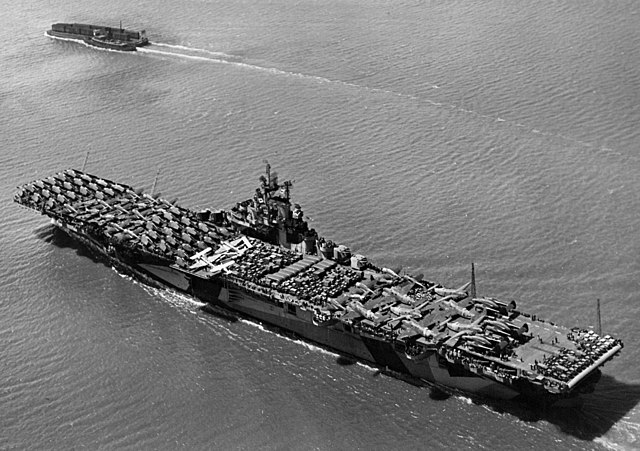
CV-11 at Hunters point, 1944
CV-11 was commissioned on 16 August 1943, undrer command of Captain Thomas L. Sprague. After sea trials and post-fixes she headed for the Caribbean for her shakedown cruiser combined with intense training. Back to Nortfolk she ws prepare for operations and departed on 3 December for San Francisco, proceeding on to Pearl Harbor (10th) and trained in Hawaiian waters before joined the active Pacific Fleet.
Central Pacific operations
She was assigned to Fast Carrier Task Force (TF 58) engaged in the Gilbert and Marshall Islands campaign. On 16 January 1944, she teamed with USS Essex and the CVL USS Cabot, departing Pearl Harbor for theior strikes on Kwajalein Atoll (29 January-2 February), destroying in common some 83 Japanese aircraft on/over Roi-Namur before the sky and ground, and supported the Marines ashore on other islands (31 January) before the proper Battle of Kwajalein. USS Intrepid was tasked to wipe out spotted defenses on Ennuebing Island ten minutes before the first wave.
it was over by 3 February and USS Intrepid prepared to launch Operation Hailstone on Truk Lagoon. It took place on 17-19 February. On the night of 17–18 February, a lone Japanese torpedo bomber escaping vigilance (“Raid Easy”) was missed by AA and dropped its torpedo, scoring a hit on her stern, 15 ft (5 m) below the waterline.
The blast jammed her port rudder, also flooding several compartments. Captain Sprague ran the port side propeller at high speed while idling the starboard screw, until high winds appeared. This compelled, after the second propeller was stopped, the crew to improvize a jury rigged sail out of scrap canvas and hatch covers (…) to allow her to sail (literraly!) back to Pearl Harbor (24 February). Temporary repairs there allowed her to move to Hunters Point Naval Shipyard (San Francisco) for permanent ones, starting on 16 March and completed by 9 June.
Western Carolines
USS Intrepid recuperated a partly rookie crew and needed intensive training for two more months before departing Pearl Harbor. When she was back in action early September 1944, USS Intrepid was reaffected to TF 38 over the western Caroline Islands; The Fast Carrier Task Force under Admiral William Halsey Jr. starting air strikes on 6-7 September on Peleliu, in preparation for the invasion propoer, and on 9-10 September Mindanao in the Philippines, and later the Visayan Sea Islands on 12-14 September. On 17 September, she was back to Pelelieu to provide air support.
USS Intrepid’s Philippines campaign
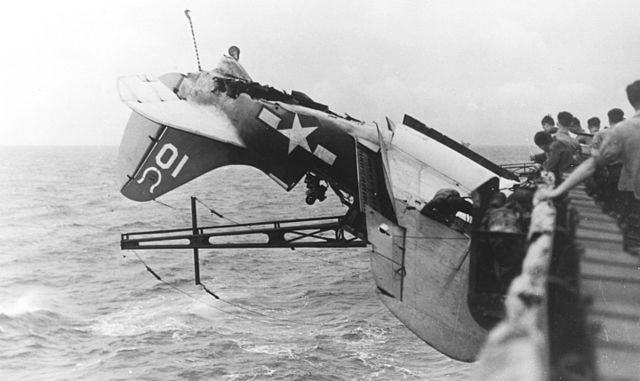
Crashed SB2C-3 Helldiver from VB-7, USS Intrepid, 30 October 1944.
USS Intrepid was attacking various objectives in the Philippines in preparation for the landings on Leyte, as part of Task Group 38.2. She was also detached to strike the islands of Formosa and Okinawa. On 20 October (Battle of Leyte), USS Intrepid air striked the island proper in close support of the troops teaming with the CVLs Cabot and Independence under Rear Admiral Gerald F. Bogan (flagship Intrepid). Like often seen in TF 38/TF 58, The ten CVLs assisted Essex class fleet carriers, generally two per Essex-class, providing CAP fighters, freeing the powerful Essex air group for strike operations only.
On 23-26 October, the Battle of Leyte Gulf developed and during the Battle of the Sibuyan Sea USS Intreprid sent eight Curtiss SB2C Helldiver dive bombers and the same number of Avengers torpedo bombers to sink IJN Musashi, arriving on her at 10:27. One 500-pound (230 kg) bomb struck Turret No. 1, but failed to penetrate (speaking volumes about her protection !). But Musashi was struck starboard amidships by one TBF Avenger torpedo from Intrepid, while two Avengers were lost to AA. CV 11 launched another eight Helldivers around noon, scoring two more hits, but two never returned, and a second batch of nine Avengers attacked this time from both sides as the Japanese battleship in conformity with tactics manoeuvered hard rudder to dodge them. They scored three torpedo hits, port. Essex and Lexington completed the job with many more bomb and torpedo hits, still at 13:30. At 15:25 there was a third wave from USS Intrepid, 37 aircraft in all assisted by some from USS Franklin and the CVL Cabot. In all they hit Musashi with 13 bombs and 11 torpedoes, loosing three Avengers and three Helldivers. Crippled, the Batleship eventually capsized and sank. Kurita’s however still had Yamato, Nagato and Haruna, the heavy cruiser Myōkō, all damaged and having to break off the operation.
As TF 38 was steaming north to intercept Ozawa’s Japanese decoy Northern Force, read admiral Bogan believed it was a feint, as others, all overruled by Halsey. On 25 October USS Intrepid and the rest of TF 38 launched an air strike on the fleeing Japanese carriers, USS Intrepid claiming almost almost alone IJN Zuihō and badly damaged Zuikaku and other ships in wha became the Battle off Cape Engaño. Meawnhile the desperate battle of San Bernardino Strait developed, without help fromp Intrepid, too far away.
From 27 October TG 38.2 was back on routine operations off Luzon, followed by a raid on Manila on 29 October 1944, and firced kamikaze attacks. One hit CV-11 on her port 5-in turret but damage was minimal (10 killed, 6 wounded however). On 25 November another saw two kamikazes crashing into USS Intrepid, killing 66 and setting her deck ablaze. Remaining on station the safety teams were able to stem the fires and she was sent for repairs to San Francisco, on 20 December.
Final Operations over Okinawa and Japan
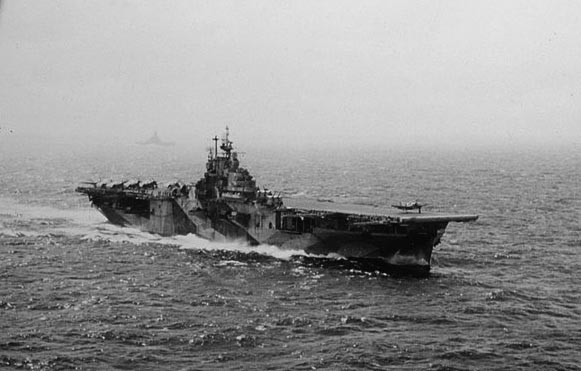
By February 1945, after an overhaul and crew’s rest, USS Intrepid departed for Ulithi, arriving on 13 March. She followed the fast carrier force for strikes directly on Japan from 14 March 1945 notably Kyūshū. A sole G4M “Betty” that day was downed by AA and exploded just 50 ft (15 m) off her forward boat crane while flaming gasoline and aircraft parts flew inside the hangar deck. As always, efficient damage control teams put them out and CV-11 was able to launch a massive airstrike on Kure, the last refuge for a largely immobile IJN. They damaged 18 warhips, notably Yamato and Amagi.
New was a serie of strikes on Okinawa and on 26-27 March followed by air attacks on the Ryūkyūs at large. Next was close support for the invasion on 1 April. On 16 April, another lone Japanese aircraft evaded both her CAP and AA, and albeit hit and destroyed by the latter, the engine and part of her fuselage ended their deadly course on the ship, killing 8, wounding 21. It took on hour tomaster the flaming, but two more for the carrier to be operational again.
On 17 April 1945 she retired for Ulithi, Pearl Harbor and San Francisco for repairs and an overhaul from 19 May to 29 June 1945. When back she launched a first strike on 6 August on Wake Island. She was resplenishing at Eniwetok when learning on 15 August the surrender. On 21 August she assisted the occupation of Japan and left on 2 December Yokosuka for San Pedro in California (15 December).
Post-war Operations
From 4 February 1946, USS Intrepid ceased operations and was ordered to San Francisco Bay, to be reduced as “commission in reserve” from 15 August. She was properly decommissioned on 22 March 1947, Pacific Reserve Fleet. On 9 February 1952, she was recommissioned, chosen for modrnization at Norfolk, to the SCB-27C standard. She had a long and eventful carrier and was eventually decommissioned on 15 March 1974, and later preserved as a museum ship in her last modernized appearance (Vietnam).
 USS Hornet (CV-12)
USS Hornet (CV-12)
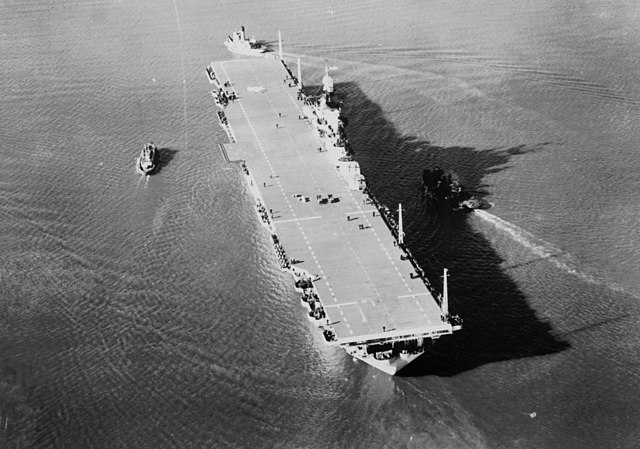
USS Hornet CV-12 off Norfolk 1943
HMS Hornet, ex-Kearsage, renamed to honor CV-8 lost at Santa Cruz on 26 October 1942, was commissioned on 29 November 1943 with Captain Miles R. Browning in command. She was one of the three Essex class ordered in anticipation of Congress two-ocean act on 10 May 1940. She made her shakedown cruiser in Bermuda before departing Norfolk in 14 February 1944 for the Pacific via Panama and Pearl Harbor in Majuro Atoll to join Task Force 58 already engaged in the Marshall Islands.
She arrived there on 20 March and condcted her first strike on the Palau Islands, Kossol Roads to threase any threat to New Guinea and the Admiralty Islands. Air groups from Hornet, Lexington and Bunker Hill made a aerial minelaying mission, and to avoid detection, the US ships went far south of Truk. Spotted on the 28th, Admiral Mineichi Koga at the head of the Combined Fleet since Yamamoto, ordered a general withdrawal to Tawi-Tawi (Philippines) while the merchant shipping was dispersed.
TF 58 approached on 30 March and launched a fighter sweep claiming 30 A6M Zero already airborne followed by an attack of the shipping by 39 Grumman TBF Avenger, carrying each two magnetic mines bottling up as intended in the lagoo the ships present in Kossol Roads. This operation was the first and last of its kind during the Pacific campaign, and very successful. Soon, air groups sank 24 merchant and auxiliary ships (130,000 GRT) and two escot destroyers, four subchasers, two repair ships until 31 March, plus 63 airbone, 100 ground aircraft. The whole operation cost 25 only aircraft on the US side. On their way back to Majuro, they attacked underway the island of Woleai on 1 April.
Departing on 13 April, Rear Admiral Joseph J. Clark claimed USS Hornet his flagship for Task Group 58.1, completed with the three CVLs Cowpens, Belleau Wood and Bataan. Their targets were Sarmi, Sawar, and Wakde Airfields, Western New Guinea while in alternance, covering amphibious landings at Hollandia. Opposition was lights and two Mitsubishi “Betty”were claimed by the CAP. Back to Seeadler Harbor, Manus Island (25 April) for replenishment, TF 58 was prpared to attack shore facilities at Truk Lagoon.
They were spotted the night of 28/29 April, and the air attack was wiped out by the 84 Grumman F6F Hellcats in the air on the morning, shooting down most of 60 Zeros. Bad weather delayed air superiority but Truk’s infrastructure were indeed pounded for two days. 9 aircraft wer lost in accidents, 27 in combat due to AA fire modtly, while claiming 59+34 air/ground. Back to Majuro, TG 58.1 cover bombardments of Satawan and Ponape, one aircraft being shot down by AA. TF 58 from 4 May resplenished and prepared for the Mariana-Palau campaign. Captain Browning was relieved on 29 May by Captain William Sample.
Mariana and Palau Islands campaign
In June, USS Hornet’s air group CVG-2 had 40 Hellcat and included for the first time four night-fighter versions. The rest were 33 Curtiss SB2C Helldiver dive bombers and 20 Avengers, an enormous 93 planes, unrivally by any navy at the time. Task Group 58.1 was reinforced by USS Yorktown, making two pairs of fleet and light carriers. TF 58 departed on 6 June and attacked on the 12th, three days before the assault on Saipan.
Hornet’s night fighters patrolled for IJN reconnaissance aircraft on 10/11 June while Mitscher decided to advance the planned air strike to achieve surprise. The CAP dealt with 30 Zeros over Guam, all down for Hornet’s 16 Hellcats lost. Destroyers were used as pickets to intercept incoming threats by radars. Hornet’s scout aircraft later spotted a seven-ship convoy east of Guam and Clark decided to wait until they were just 80 nmi (150 km; 92 mi) to attack with 20 bomb-armed Hellcats, but they modtly made near-misses, not having the training for this.
Combined Fleet’s Admiral Soemu Toyoda ordered the 1st Mobile Fleet to head for the Guimaras Island, preparing any eventuality as hs was unsure of TF 58 objectives. The goal was to start training their rookie pilots out of harm, and prepared the fleet for Operation A-Go started on 19 June 1944, when learning of the US bombardment. Meanwhile TG 58.1 struck Iwo Jima, Hahajima and Chichi Jima, Clark sending his nightfighters over Iwo Jima to shot down any reconnaissance mission or air strike. After destroying 81 aircraft, the fleet departed and was soon embrouiled in a major battle.
Hornet at Battle of the Philippine Sea
Mitscher ordered fighters from Task Group 58.1 to patrol over Orote Field and Hellcats from USS Belleau Wood were the first to engage Japanese aircraft at 07:00, reinforced by thosr from Hornet and Yorktown. At 09:30 all three claimed 45 Zeros down, for two Hellcats lost. This was the start of the infamous “mariana turkey shoot” which forged the legend of the F6F Hellcat. USS Hornet launched 17 Helldivers and 7 Avengers, 12 Hellcats on Orote. At 09:50 radar spotted an incoming Japanese air strike answered by the launch of 140 fighters over Guam, but they were recall to bolster the Combat Air Patrol over Task Force 58 and missed the main aerial engagement.
The CAP claimed 40 of the 57 Zeros. One battleship was lighlty damaged. USS Hornet’s Hellcats claimed 9 Zeros and 3 “Jill” torpedo bombers. The second wave spotted at 11:07 was repelled while Hornet’s air group was refuelled and rearmed and missed completely the third wave which was given erroneous locations and found northing, 120 nmi off to the northwest, at 12:40.
Twelve however found Task Group 58.1 at 12:56 and were engaged, USS Hornet’s Hellcats claiming 9, for a damaged Hellcat. The fourth wave also missed their locations and continued to Guam in order to land, arriving at 15:00. They were already waited by 41 Hellcats from Hornet, Essex, Cowpens and Enterprise. 40 out of 49 went in flame, five by Hornet as they attempted to land, probabky panicked rookies pilots (most were at this point in the war, explaining also the stunning kill ratio).
295 Hellcats and five Avengers, Dauntlesses, engaged the Japanese claiming a total of 208 out of the 373 carrier-borne aircraft, traded for seven Hellcats lost at sea, nine over Guam by AA, six by accidents and seven bombers lost to AA over Guam, two crashing. The final count with Guam made an exact 10:1 ratio for the USN. The fleeing Japanese were spotted again later, Mitscher ordering 54 Avengers and 51 Helldivers plus 85 Hellcats to catch and finish them off. Hornet’s badly damaged Zuikaku and co-sank Hiyō, damaging and sinking other ships, but they had to land at night, and many were lost in the process: 6 Hellcats, 35 Helldivers and 28 Avengers in all, many splashing after running out of gas.
More actions in the Marshalls
After refuelling on 22 June, the Task Force 58 headed for the Marshall Islands, Clark keeping his task group north in order to stike the Bonins Islands and prevent reinforcements. His force was spotted by a Japanese reconnaissance aircraft that day. The Japanese soon scrambled 60 Zeros and some Yokosuka D4Y “Judy” dive bombers. They soon clashed into the forward wave of 51 Hellcats and claiming six for the loss on their side of 24 Zeros and 5 Judys. The remainder was in sight of the task group but the first airstrike was wiped out by the CAP and AA barrage, while the second gruoup never found the task group and were later cught by the Helcats, claiming 10 Zeros and 7 Jills.
Task Group 58.1 was back in Eniwetok on 27 June and departed soon after for the Bonins reinforced by TG 58.2. The 3–4 July failed to sunk any ship, only causes damage, while shooting down many Japanese aircraft. Both TG 58.1 and 2 relieved TG 58.4 deplyed in close support at Saipan. After a week they made a supply run to Eniwetok and by late July, TG 58.1 attacked Yap and the Bonins again (4–5 August).
Captain Sample was relieved by Captain Austin Doyle, while Clark, unwilling to serve under Vice Admiral William Halsey was relieved by Vice Admiral John McCain, on 18 August. Her however remained aboard Hornet as an assistant to McCain and kept as a reserve carrier-experienced admiral.
USS Hornet’s Philippines campaign
Based on a agreed date to liberate the Philippines on 20 December 1944 between the navy staff, the president and MacArthur, a strategy of preliminary operations was setup, which included a first early step by “cleaning” the western Caroline Islands, and approaches to the Philippines with Yap and the Palaus. Three task groups were committed in the action, notably Hornet’s TG 38.1, scheduled to start on the Palaus on 6–8 September and Mindanao on 9–10 September. Mitscher meanwhile ws tasked of attacking the central Philippine islands with Leyte and the Visayans. On the 12–13, some 173 aircraft were shot down, 305 destroyed on the ground, 59 ships sunk. All these claims were in reality far lower based on postwar analysis of Japanese accounts.
One of Hornet’s pilots shot down was rescued by Filipino fishermen and contacted by the Filipino Resistance passing on the information was no Japanese garrison on Leyte, the intel trigerring Halsey to skip preliminary attacks and directly start with the invasion ahead of schedule, on 20 October. Nimitz however still wanted to secure the bases in the Palaus and Western Carolines.
On the 15th, TG 38.1 was sent to support the invasion of Morotai but Halsey changed his mind and redirected them to TF 38 to support his attack on Manila on 21 September. Hornet’s air group were in the second wave. Avengers sank the destroyer IJN Satsuki.
In all 110 aircraft were claimed in the air, 95 (two dozen lost in reality). Nine oil tankers were also sunk or wrecked. Halsey decided to attack Coron Ba (Calamian Islands) due to bad weather, with 38.1 and 38.3. Hornet’s air group led the airstrike. Avengers and Helldivers claimed two oilers, six freighters, several escorts and the seaplane tender Akitsushima. TG 38.1 replenished, and exchanged Air Group 2 for Air Group 11 while Clark departed on 1 October 1944.
The four carrier groups of sailed west of the Marianas on 7 October after a typhoon and Hornet’s AG 11 in its final form comprised 39 Hellcats, 25 Helldivers and 18 Avengers. American radio traffic alerted the Japanese and and air strike was conducted on the Ryukyus on 10 October (100 aircraft claimed, 21 lost to all causes), leading the Japanese to activate Sho-1 and Sho-2 variants of the grand plan for the defense of the Philippines. Carrier-based aircraft were transferred on land bases and the empty carriers would be used as a bait force. On 11 October, TG 38.1 and 38.4 launched an airstrike on Aparri, northern coast of Luzon.
Soon the Battle of Formosa took place: On 12 October at dawn, the combined TGs of TF 38 launched a fighter sweep of 199 Hellcats (48 lost to all causes) while shooting down 42 Japanese aircraft; Airstrikes followed on 13 October, buy the US lost 12 more aircraft to all causes. Durng the nigh counterattack, USS Hornet successfuly dodge a torpedo which ended its course into the hull of USS Canberra. Halsey next decided to attack the airfields westwards over Formosa. Another night atack on TG 38.1 succeeded in crippling USS Houston, but both her and Canberra under escort reached Ulithi. It was estimated the Japanese lost 492 aircraft in all, including many from the army air force.
On 18 October TG 38.1 fusioned with TG 38.4 off the eastern coast of Luzon for more operations and USS Hornet’s air grpup struck Clark Air Base and San Bernardino Strait, losing seven aircraft for 30 airbone, 29 on the ground. fter the same attack the following day, TG 38.1 retreated south to support the amphibious landings on Leyte (20 October). Halsey in between, on 19 October, decided he wanted to change the air group composition for all Essex-class carriers, including Hornet: 54 fighters, 24 Helldivers and 18 Avengers. The change took some days to take place and was acted on the 29 October.
Northern Mindanao was struck on the 20th, with little opposition but few kills. The defensive lines protecting the landing beaches were soon also attacked, but difficult due to the dense foliage, and heavy smoke in the air. There were also communications problems. On the 22th, Halsey ordered TG 38.1 to Ulithi, replenish and prepare for newt oprations from 11 November but soon the order was counter-manded as the japanese executed their plan on 23/24 October. The battle of Leyte Gulf, Sibuyan and Samar developed but due to the ruish north with Halsey, the carriers were too far away to help the beleagued escort carriers at the Battle off Samar.
On 25 October McCain’s carriers closed the distance enough to launch two long-range airstrikes with few results, loosing 14 aircraft to all causes. On the 26th, TG 38.1 and 38.2 launched 257 aircraft agains on Kurita but Avengers from Hornet and Cowpens only achieved two hits on the cruiser IJN Noshiro which later sank. TG 38.1 resumed her voyage to Ulithi on the 27th. McCain relieved Mitscher at the head of TF 38, Rear Admiral Alfred Montgomery now heading TG 38.1, still from his flagship USS Hornet. TG 38.1 to 3 returned to the Philippines in early November. They concentrated on Luzon claiming 439 aircraft ùainly on the ground, for 36 losses, the heavy cruiser Nachi, an oiler and cargo ship.
On 11 November, a troop convoy was spotted and decimated, loosing five troopships, four escorting destroyers. TF 38 attacked Manila and sank IJN Kiso four destroyers, seven merchant vessels, damaged 43 other ships, claimed 84 aircraft for the loss of 25.
A new attack was led on 19 November, and TGs 38.1-38.2 concentrated on other targets on Luzon on the 25th. They nearly sank IJN Kumano and smaller ships then retired to Ulithi. Clark hoisted his flag on Hornet, but more as a personal gesture as he was not in command. Halsey after fierce Kamikaze opposition canged the air group composition again, now of 73 fighters, 15 dive and 15 torpedo bombers. Months were necessary to implement this, and each carriers had two fighter squadrons by January 1945 instead of one previously.
Next, USS Hornet would take part in the Battle of Mindoro on 5 December, but postponed until 11 December and her air group cimprised at the time 51 Hellcats, 15 Helldivers and 18 Avengers. Air supremacy over Luzon was one of these objectives, gained from the 14th (269 aircraft claimed, merchant ships infrastructure) for 27 losses in combat, 38 to accidents. Halsey sailed unwittingly his beloved TF 38 right into Typhoon Cobra path, and many ships low on fuel rolled badly, three destroyers capsized. Many aircraft were tossed away like toys in the hangard, fire destroyed many, and the rest parked on the decks, washed away. Losses were crippling. The Third Fleet saw all operations cancelled and TF 38 returning to Ulithi.
USS Hornet’s 1945 operations
Still in TG 38.1, USS Hornet sailed for the next great raid, the south China Sea raid, underway on the 30 December. The objectives were Formosa again, French Indo-China, Luzon, the China coast, Ryukyus and Pescadores Islands, all in support of Lingayen Gulf’s landings in Luzon, 9 January 1945. The other objective was to cutoff all maritime traffic with the Japanese home islands and Southeast Asia for good. Formosa (3–4 January) as followed by Luzon (6th-7th) and back to Formosa (9th). In the South China Sea onf 9–10 January Halsey searched for the two Ise-class battleships mistakenly reported at Cam Ranh Bay. 1,500 sorties were made over French Indochina and off the coast with little result. After Formosa and Hong Kong area (15–16 January) on the 21, TF 38 left the South China Sea. In addition to reconnaissance over Okinawa, the air groups claimed 300,000 GRT of shipping, 615 aircraft for 201 losses.
Next came the Volcano and Ryukyu Islands campaign, with Spruance relieving Halsey and Clark promoted at the head of TG 58.1 again. TF 58 departed Ulithi on 10 February to strike the Tokyo area (16–17 February) and isolate Iwo Jima. 341 aircraft airborne, 190 on the ground were claimed, industrial sites were mostly unscaved however and little shipping sunk to the exception of the IJN Yamashio Maru, all traded for 88 losses.
On 19 February TG 58.1 refuelled the same day of the landings on Iwo Jima and was on site on the 20th, the sent north on the 23th to strike the Home Islands again, hampered by dad weather. Refuelled the 27th attack concentrated afterwards on Okinawa, from 1 March.
Air Group 17 suceeded AG 11 aboard USS Hornet whhc retruend off Okinawa but few planes were shot down most bein dispersed and hidden by the Japanese. Airfields in Kyushu were struck by Hornet’s FV 17, which claimed over Kanoya Air Field 25 planes. Three carriers wree damaged by Kamikaze attacks, but none under Clark’s command. Until then, luck had been remarkable for USS Hornet. Would it last ?
Kure and Kobe were the next targets for TGs 58.1, 58.3 and 58.4. During a Japanese air attack, a kamikaze crashed a thousand yards (910 meters) astern of Hornet, two other destroyed by nearby USS Bennington, but later USS Franklin was less ucky. 20 of Hornet’s Hellcats (VF 17) met their most serve resistance so far in the war: 40 fighters from the IJAAF’s elite 434rd Kokutai. The 25 minutes dogfight left six American and four Japanese fighters down, a casualty rate inverting the usual curve for the first time. The raid of Kure was not very severe and Hornet lost 13 aircraft of all causes. Attacks were renewed on 20-21 March.
Next were a wave of attacks of Okinawa, starting on 23 March. TG 581.1’s reconnaissance aircraft meanwhile spotted a Japanese convoy with two troop transports, an ammunition ship and five escorts off Amami Ōshima and bound for Okinawa. They were wiped out by a 112-aircraft airstrike. 3,095 sorties were made in the last days of March bu Kamaikaee attacks multiplied on 26-31 March also, damaging 10 ships. Between the massive CAPs and AA fire, 1,100 aircraft were destroyed.
On 1 April, Hornet’s air group provided direct support for the landing and invasion operations on Okinawa. On 6 April there was the largest air attack so far on TF 38, 700 planes, including 355 were kamikazes. Mitscher ordered his flight decks cleaned of torpedo-bombers, freed for fighters. TG 3.8.1 alone claimed 249 aircraft. But the Japanese claimed three destroyers, two ammunition ships, one LST, nine destroyers damaged. On the 7th, another massive attack damaged USS Hancock, one battleship, a destroyer.
This was followed by the IJN last offensive of the war, Operation Ten-Go. IJN Yamato led the charge with nine other Japanese surface vessels, but the fleet was spotted underway by American submarines on 6 April. TG 58.1 scrambled her air strike the followinf day. Hornet’s Avengers claimed one torpedo hit on Yamato, damaged the light cruiser Yahagi and four destroyers.
On 8 April, TF 58 was attacked by kamikaze again, with some loss, but the Japanese could no longer muster large air forces at that point. Mitscher ordered a fighter sweep over Kyushu, claiming 29 aircraft, 51 on the ground. Despite of this on 17 April, USS Intrepid was badly damaged. Back to Okinawa, nothing happened until 11 May while TG 58.1 resupplied in Ulithi from the 27th of April, back on 12 May, to attack airfields in Kyushu and Shikoku. The 14th saw USS Enterprise abadly damaged in turn, but Hornet was still unscaved.
Halsey retook the head on 27–28 May of what became again TF 38. Bad weather precluded operations until early June. Clark tried to avoid a developing typhoon but Halsey, ordered him to steer northwestwards for the planned airstrikes on Kyushu and despite multiple requests to alter course, TG.38.1 entered the typhoon eyewall. A massive wave crashed down Hornet’s bow, collapsing 25 feet (8 meters) downwards and the same happened to USS Bennington which lost her bow, as USS Pittsburgh. 76 airplanes were destroyed or lost overboard, 70 damaged, crippling both air groups.
Unable to launch both carriers were ordered by Clark to launch remaining aircraft over the stern on 7 June, providing the awaited CAP over the task group. Bennington was sent for repairs on the 8th, but Hornet participated in the Kanoya Air Field strike. On 9 April, they aslo used for the first time napalm bombs on the coastal defenses of Okidaitōjima. On 13 June, Clark left the task group, reliquishing command as USS Hornet was ordered home. She arrived in San Francisco on 7 July 1945, and the war was over during her repairs and overhaul. USS Hornet earned seven battle stars and a Presidential Unit Citation.
From 13 September 1945 CV 12 was assigned to Operation Magic Carpet and was back home to San Francisco on 9 February 1946. Decommissioned on 15 January 1947, Pacific Reserve Fleet, she was later exhumed and modernized, starting her even longer cold war carrer…
 USS Franklin (CV-13)
USS Franklin (CV-13)
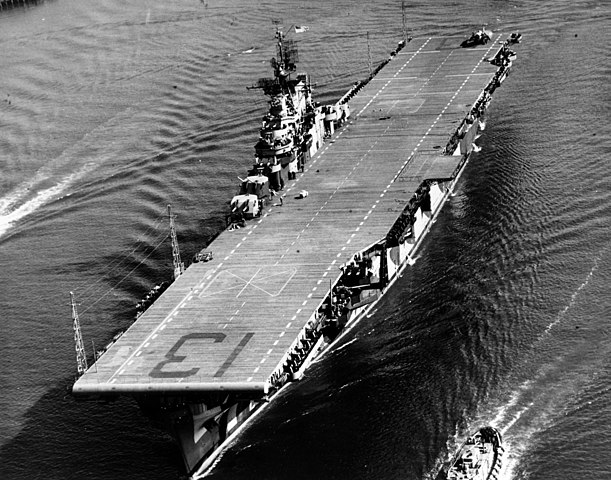
USS Franklin escorted out of yard, 1944
USS Franklin (laid down 7 December 1942, one year exactly after Pearl Harbor) in Shipway 11, Newport News Shipbuilding Company and launched on 14 October 1943, CV-13 was of course named after inventor and diplomat Benjamin Franklin, and commissioned on 31 January 1944. In command was Captain James M. Shoemaker. She sailed to Trinidad for a shakedown cruises, fixes, followed by training and preparations in San Diego, she was assigned to Task Group 27.7 before sailing again via Pamana to join Pearl Harbor in June 1944, so after nine month of intensive drills. Her first stop was Eniwetok Island and TG 58.2 where she became flagship (Rear Admiral Ralph E. Davison).
Franklin’s Bonins and Mariana Campaign
In late June 1944, she launched her air group in attack of the Bonin Islands in support of Marianas future conquest. On 4 July she launched new striked on Iwo Jima, Chichi Jima, and Haha Jima and also sinking her first large cargo vessel in the harbor. Two days after and until 21 July she attacked Guam and Rota in preparation of the invasion forces sent on Guam, then direct support on the Island. After a replenishment run at Saipan she joined Task Force 58, sending her photographic fighters in reconnaissance and air strikes on the Palau Islands group, notably on 25-26 July. USS Franklin left the area on 28 July for Saipan, and reassigned after resplenishment to TG 58.1.
She soon steamed for another Bonins strike, notably the 4 August Chichi Jima attack with fighters equipped with bombs and rockets while her strike aircrafts spotted and rampaged a convoy north of Ototo Jima. After a new supply and rest time in 9–28 August at Eniwetok she sailed with TF 16 (USS Enterprise, Belleau Wood, San Jacinto) back to the Bonins. 31 August to 2 September saw her sinking two more cargo ships, destroying enemy planes and resume her photographic surveys.
Peleliu & Leyte
![]()
On 4 September 1944, after resupplying at Saipan, she joined TG 38.1 in an air strike on Yap Island (3–6 September) and air supremacy over Peleliu to prepare the invasion, starting on the 15th. The new supply zrea was now at Manus Island, where she sailed and stopped on 21-25 September. As Flagship of TG 38.4, she sent more strikes in the Palau area making both daily and night patrols with her trained and equipped Wildcats.
On 14 September she launched a F6F sweep against Aparri in Luzon. After this, she steamed up east of the island, to rampage Japanese installations prior to the landings but the following day she ws attacked by three enemy planes, one scoring a bomb hit on the after outboard corner of the deck edge elevator. 3 ere killed, 22 injured, but the damage could be eventually repaired and there was still another lift for deck operations so this did not hampered much her activity.
She then headed northwest to take part in the intense Formosa (Taiwan) Air Battle of 12-16 October with the objective of destroying Japanese air bases supporting the defense of the Philippines, up to Okinawa and Kyushu. On 13 October, a lone, low-flying Japanese “Betty” was spotted and dealt by AA but her pilot became kamikaze and eventually hot Franklin, hitting the corner of starboard flight deck with little damage. Next, USS Franklin was mobilized for the long awaited invasion of the Philippines. Her air group took part in the attack on Manila Bay (19 October) sinking many ships and boats and a floating drydock.
The landings took place on 20 October and her air group spotted and destroyed airstrips, then sending patrols to located an incoming enemy attack force. On 24 October that became the Battle of the Sibuyan Sea, her fighters repelling waves from Takeo Kurita’s First Raiding Force and her Avengers and Helldivers helped sinking Musashi as well as damaging Fusō, Yamashiro, and Wakaba. Wit the committed air groups of TGs 38.4, 38.3, and 38.2 she was sent by Hasley in hot purduit of the distant decoy carrier force and could not help Taffy 3 engaged further south at Samar. On 25 October however her air group participated in the Battle off Cape Engaño, damaging Chiyoda and sinking Zuihō.
Action resumed after a quick resupply at sea, on 27 October, savaging a heavy cruiser and two destroyers south of Mindoro. While she was underway circa 100 miles off Samar on 30 October, Kamikaze bombers arrived in waves, six breaking through the CAP. Despite the four carriers’s AA barrier was made of about twenty escorting cruisers and destroyers, three kamikazes still plunged into their respective carriers. The one intended for USS Franklin was dislocated in flights and percuted the flight deck, crashing through to the gallery deck. The explosion killed 56, with 60 injured. Another from a second wave get through and narrowly missed Franklin, dropping two bombs and crashing into the stern of USS Belleau Wood.
Damage control teams onboard CV-13 did wonders, patched the flight deck so she could at first recuperate her flying planes, and she was declared fully operational just 76 minutes after the kamikaze hit. She however leaft the area with Belleau Woods to Ulithi Atoll, being temporary repaired here before proceeding to Puget Sound Navy Yard. She arrived there on 28 November 1944, and was also drydocked for a maintenance. During that time of long crew’s leave, on 7 November, Captain Captain Leslie E. Gehres took command. A strict disciplinarian, the crew disliked his petty attitude, in stark contrast to hid laid back predecessor, Captain Shoemaker.
March 1945 Operations
USS Franklin was ready to depart from Bremerton on 2 February 1945. With a partial rookie crew, she spent time in training exercises, also with a new air group, so proceeded to pilot qualification operations. She sailed for Pearl Harbor on 3 March 1945 and was back with her former unit, renamed TG 58.2. That phase was of strikes the Japanese homeland, in preparation for the Okinawa landings, since Iwo Jima was already invaded. She also carried Rear Admiral Ralph E. Davison and Rear Admiral Gerald F. Bogan as the head of Carrier Division 4 while also carrying Captain Arnold J. Isbell due to take command of USS Yorktown(ii). On 15 March 1945, she arrived with TF 58 and her air group soon was over Kagoshima and Izumi (South Kyūshū).
USS Franklin’s martyrdom
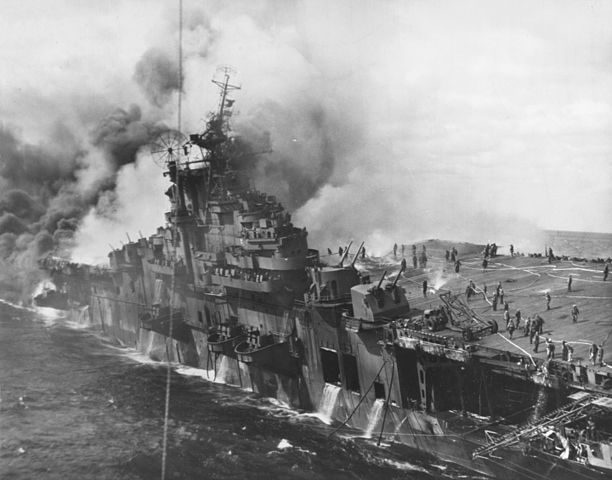
On 19 March 1945, Franklin she took a position 50 miles (80 km) of Japan, being the closest USN aircraft carrier ever since the start of the war. Her fighter sweep over Honshū was followed by a massive strike against shipping in Kure, a complete surprise which was successful. She was maintained in battle stations all that time, AA gunners staying at the post for 48h straight. Unbeknowst to her captain, USS Franklin has been spotted by a lone aircraft, which reported her position and when she was about to launch a second air strike, Japanese bomber dove on her from a thick cloud cover, making AA gunners unable to respond in time.
Two semi-armor-piercing bombs among many nrea-misses, hit her deck. Damage analysis later revealed they were 550 pounds models, one piercing in the centerline, and exploding in the hangar deck. The second and third decks also erupted in flames, the combat Information Center was disabled, preventing any air operation. The second bomb fell on the aft deck, piecing the hangar and exploding two decks below, flaming gasoline spread among 31 armed and fueled aircraft, while about 16 tons of high explosives as well as air-to-surface rockets prepared for Vought F4U Corsairs.
The hangar deck explosion ignited fuel tanks on all aircraft present, which added to the cooking of ammunitions and rockets in a serie of deflagrations which completely devastated the deck. Even places spared in the hangar until then were blasted by self-launched “Tiny Tim” rockets with 500 lb (230 kg) warheads. From all the personal present, only two crewmen survived the inferno. others will soon die also of smoke inhalation soon filling the engineering spaces, evacuated. Event the machinery was stopped, the electrical power was off, al cables cut, and USS Franklin was now dead in the water, without power of communications, radar, all AA guns frozen.
Captain Gehres measured the damage and ordered Franklin’s magazines to be flooded as fires were far from being mastered.
But since no pumps not valves could be activated, this was never done, and there was the risk of moe devastating explosions ahead.
The ships nearby were not long to intervene: USS Pittsburgh (Baltimore class) and USS Santa Fe (Atlanta class) went, with the destroyers USS Miller, Hickox, Hunt and Marshall, assisting Franklin. Rear adm. Bogan and Davison transferred their flag to USS Miller, suggesting abandoning ship, but Captain Gehres refused to scuttle is ship, despite the desperate situation. Indeed her believed there was till many men trapped alive below deck, below the fire. A race against the clock started, pending more attacks so close to the Japanese coast, or submarines drawn by the fire, visible for dozens of miles away.
Closely framed by destroyers which came to rescue the crew blown overboard or jumping off to avoid the fire, thei captains managed to gently place their bows on her side to take off more men trapped inside. Still, hundreds of officers and ratings voluntarily remained on board and tried to save the ship. The captain was later reported 924 men killed in action, the worst loss suffered by any surviving USN vessel in WW2, close to the battleship USS Arizona.
Among those who stayed on board there were many Medal of Honor recipients, some making heroic deeds saving hundreds. USS Santa Fe rescued more men from the sea and then rescued numerous burned or wounded men and all personal non essential to save the ship, notably Air Group 5 personal. At the time, USS Franklin lost 32 Vought F4U Corsair, 15 Grumman TBM Avenger, 7 Curtiss SB2C Helldiver, 5 Grumman F6F Hellcat. But the captain and his rescue team managed, after herculean efforts to indeed extinguish all fires after 6h, restore partial power after 12h, and after perhaps 24h of intense around the clock action, what was previously a burning hulk left for a total loss was sailing again to safety, although not under her own power. Amazingly not further attacks from the Japanese came, the latter promptly announcing her sinking, rightly assumed this time.
Official Navy casualties for the 19 March 1945 as reported was 724 killed and 265 wounded although Joseph A. Springer rose it to 807 killed, 487 wounded. USS Franklin nevertheless became the most damaged (and surviving) USN carrier of this war. Many Navy Cross, some posthumously were also presented for the numerous actions that day including a gold star for CDR (later rear admiral) Joseph F. “Joe” Taylor, ship’s executive officerand several Silver Stars.
USS Franklin did not saved herself alone, all her defending ships participated in a gigantic effort which resulted in the unexpected outcome: USS Santa Fe for example came alongside USS Franklin despite her crippling damage and fires threatening to detonate more ordnance, dousing water from her fire hoses while receiving stretcher cases and ambulatory wounded on stop as the destroyers. All the water poured into her eventually severaly compromised her stability, as she was already listing badly to 15° to port, compromising her stability, as she had been mad eoverweight after many wartime additions.
As soon as pumps were in working order, ballast were filled on the other side to correct the list. USS Pittsburgh eventually towed Franklin, at 5 knots until dark fell, with all ships around in high alert. Eventually, engineers managed to have her powerplant partially operational again, and she was able to steam at 25 knots on two propellers. Her planes still in the air at the time landed on other carriers in the task group. Admiral Davison also sent five destroyers to search for any survivor stranded at sea. Eventually, the crippled aircraft carrier entered Ulithi Atoll at 14 knots for emergency repairs before proceeding to Pearl Harbor for more, then headed for Panama and Brooklyn Navy Yard in New York, on 28 April 1945.
Controversy however soon arose from many in the crew which did not liked the command style of Captain Gehres, accused of desertion after having indeed jumped overboard, but to escape fire. All charges of premature “desrtions” by the crew and against Captain Gehres were dropped. Her retired as a rear admiral, but stayed at office, never seen the deck of a ship again. Repairs would take a while, and she was operational again in 1946, earning four battle stars for her service. She became a celebrity at Navy Day celebrations but was decommissioned on 17 February 1947 at Bayonne in New Jersey.
Mothballed at Bayonne and redesignated CVA-13 on 1 October 1952, then in 1953 an antisubmarine warfare support carrier (CVS-13), aircraft transport (AVT-8) in 1959, reflecting the Navy’s doubts about her operational again, she was eventually stricken on 1 October 1964, one of the only two Essex-class to be so (with USS Bunker Hill) due to severe damage, despite being successfully repaired. The Navy studied an “ultimate reconfiguration” which never took place in the post-Korea context. Their repairs in some way were taxpayer’s money waste, in hindsight. Bureau of Ships reclaimed her four turbo generators but she sold for scrap at the Portsmouth Salvage Company of Chesapeake in July 1966.
 USS Ticonderoga (CV-14)
USS Ticonderoga (CV-14)
![]()
USS Ticonderoga at Ulithi, 8 December 1944
USS Ticonderoga was commissioned at the Norfolk Navy Yard on 8 May 1944 and her first captain was Captain Dixie Kiefer. The aircraft carrier stayed in Norfolk for almost two months for outfitting while Air Group 80 arrived on biard. On 26 June 1944, she sailed for the British West Indies and her shakedown cruise with air operations and drills underway to Trinidad. Until mid-July USS Ticonderoga continued training intensively and sailed back to Norfolk (22 July) for post-shakedown fixes and and modifications. On 30 August she was declared ready for operations and headed for Panama, transiting on 4 September, steaming to San Diego to be prepared for her first leg of the voyage to Pearl Harbor, loading an additional 77 USMC aircraft and Marine Corps aviation and assocoated personal. She departed on 19 September andsteamed for Hawaii, where she arrived on the 24th.
USS Ticonderoga remained in Pearl Harbor for a month and carried out experiments in aviation bombs tranfer with the cargo ship USS Carina while her air crew also drilled intensively. Air operations consisted in day and night landings, AA defense drills, safety drills, before she was declared ready to be assigned to TF 38, proceeding on 18 October to Eniwetok, then Ulithi (Western Carolines) on the 29th. Rear Admiral Arthur W. Radford soon joined her deck as Commander, Carrier Division 6 (CarDiv 6), to be placed under orders of Rear Admiral Frederick C. Sherman (TG 38.3)
Ticonderoga’s Philippine campaign (Nov-Dec. 1944))
By that point, both the Philippines June and leyte gulf epic battles in October were over. When she started her first war sortie on 2 November 1944, her air group took off for air cover for ground forces invading Leyte, starting on 5 November. After two days of enemy shipping search and destroy operations off Luzon and destroying airfields at Zablan, Mandaluyong, and Pasig and assiting in the sinking of the heavy cruiser IJN Nachi, her CAP also claimed six Japanese aircraft, 23 damaged, mostly ion the ground.
Around 16:00 on 5 November however, she saw her first kamikaze attack: Two of these penetrated the CAP and AA barrage, targeting Lexington. But both were splashed at the last minute and USS Ticonderoga renained unscathed. On 6 November, striked resumed on Luzon airfields and enemy shipping. In all, she claimed 35 Japanese aircraft, six enemy ships, in Manila Bay. She then departed to resupply on 7 November and was back to launch other strikes from 11 November. This time she preyed on a Japanese reinforcement convoy entering Ormoc Bay, Camotes Sea. All enemy transports, four escorting destroyers were sunk, in collaboration with other air groups. On 12–13 November there was a new round of strikes at Luzon airfields and shipping, which claimed the light cruiser IJN Kiso, four destroyers and seven cargos. TF 38 made another refueling run in Ulithi.
From 22 November, CV-14 was back and resumed operations over central Luzon and over the area. IJN Kumano, a rescapee of the Battle off Samar was finished off followed by an enemy convoy spotted 15 miles (24 km) southwest of her, in Dasol Bay. The ex-Chinese cruiser IJN Yasoshima, a cargo and three Landing ships were sunk and the day concluded with an aerial battle and more planes destroyed on the ground.
After noon, a lone torpedo plane targeted, but missed the CVL USS Langley, and all Ticonderoga’s AA gunners were placed in high alert and battle stations. USS Essex was soon badly damaged by a kamikaze but Ticonderoga’s AA gunners shooting another down. She would later recovered Essex and Intrepid’s returning aircrew and planes before returing to the east with the rest if TF 38. A pause in Ulithi on 11 December was faollowed by other operations in the Philippines starting on 13 December, still against Japanese airbases on Luzon and various objectives in the central Philippines, for three days until 16 December.
But instead of the rest she craved for, TF 38 steamed directly into its most violent typhoon to date, the infamous “cobra” which cost Admiral William Halsey’s much. But USS Ticonderoga weathered it without damage and after light repairs, she was back at sea from 30 December 1944. Next objectives were Formosa and Luzon, hempared by severe weather. After refuelling at sea on 5 January strikes on Luzon were resumed, augmenting the aircraft carrier’s pilots tally to 32 enemy aircraft. After another refuelling run on 8 January, CV-14 participated in strikes on the Ryūkyūs (Lingayen assault) but TG 38.3 soon joined TG 38.2 in to attack Formosa.
South China Sea raid (January 1945)
During the night of 9–10 January, TF 38 went through the Luzon Strait before proceeding southwest to the South China Sea. USS Ticonderoga’s CAP claimed on 11 January splashing four enemy aircraft, and the formation reached a point 150-200 mi off the coast of Indochina to launch a massive air strike on 12 January of 850 aircraft. Shipping was also targeted, with 44 ships sank (300,000 tonnes). The group then proceeded further northeast and after refuelling on 13–14th, Japanese airfields on the Chinese coast were targeted, and Hong Kong’s area and shipping. Bad Weather paused them until 17 January and worsened to the point even replenishment operations were delayed until 19 January. The force then retreated through Luzon Strait via Balintang Channel.
Japanese Home islands raids (Feb-August 1945)
![]()
USS Ticonderoga (CV-14) listing after battle damage on 21 Jan 1945
After raids on Formosa and Sakishima Gunto, USS Ticonderoga caeme under heavy kamikaze attacks on 21 January 1945: After noon, USS Langley was hit while another plungedtoward Ticonderoga and crashed on her flight deck, abreast her second 5-in AA turret, just above the hangar deck. Parked aircraft nearby were destroyed by flames, and Captain Kiefer changed course to keep the wind from fanning the blaze, ordering magazines flooded and use water ballast to correct a 10° starboard list while breiefing damage control parties about other port side to douse the flames while firefighters and aircraft handlers jettisoned burning aircraft and started to clean the mess.
But it was only a brief respite as another three kamikaze were shot down by AA and crashed into the sea, while a fourth went through and hit CV-114’s starboard side, near the island. It blew up and engulfed in flames other parled aircraft, while her flight deck was devastated, and making about 100 killed or wounded. Captain Kiefer was also wounded in the process, but remained in command and everything was again under control after 14:00. But heavy damaged imposed repairs, the captain asked for. She stopped in Ulithi on 24 January to transfer wounded personal to the hospital ship USS Samaritan, and her remaining air group to USS Hancock, then embarking passengers bound for home and stopped briefly again at Pearl Harbor until reaching Puget Sound on 15 February. Captain William Sinton by then assumed command in February 1945.
On 20 April 1945 repairs has been completed, and USS Ticonderoga left for the Alameda Naval Air Station to embark aircraft, pilots and support personal of her new air group, then trained intensively up to Hawaii, and after 1 May Air Group 87 came on board in turn, completing her global air group. The trained for a week and then departed for Ulithi. On 17 May while en route, she trained her air group by sending them striking Taroa in the Marshalls. On 22 May, she arrived, assigned to the Fast Carrier Task Force in Rear Admiral Radford’s TG 58.4.
Japanese Home islands raids (May-August 1945)
![]()
Kamikaze crashed on USS Ticonderoga in 1944
At sea with TF 58 northwards, CV-13 was to spend of week of operations in home waters, starting on 2–3 June, with raids on Kyūshū in order to isolate Okinawa. After weathering her second typhoon unscathed, and providing CAPs during the refuelling of 6 June (claiming more kamikazes) she made a fighter sweep to strike airfields on southern Kyūshū two days later, then raided Minami Daito and Kita Daito. On the 13th she was back in Leyte for rest and replenisheùent followed by another sweep northwards for more raids on Japan. When she was underway, a badly damaged turbine reduction gear obliged Captain Stinson do detach and sail for Apra Harbor in Guam, to receive emergency repairs. She departed on the 19th and on the 24th, joined striked in the Inland Sea, Nagoya, Osaka, and Miko.
Her aircraft parcipated in finishing off IJN Ise, Hyūga, and Haruna, Kaiyō and two heavy cruisers. This was followed by anoher raid on 28 July on the Kure Naval Base. Next came the industrial area of central Honshū (30 July), northern Honshū and Hokkaidō (9–10 August), and the Tokyo area on 13–14 August. She only learned of the capitulation after launching another raid on the morning on the 16th. She went on patrolling the mainland, and lieke other carriers, launched searches of POW camps, dropping med and food packages along the way. On 6 September she entered Tokyo Bay.
She went back to Bremerton Navy Yard, Puget Sound and took part in Operation Magic Carpet voyages to Okinawa and back to Alameda Navy Yard (Oakland) by December 1945, then another run in Samar back to Puget Sound withiut four thousand servicemen, followed by her last run to be deactivated in Bremerton Navy Yard, mothballed provisionally the permanently from 9 January 1947 (Pacific Reserve Fleet). She was reactivated in 1952 to be converted under SBC-27C standard, served in the Mediterranean, Pacific, Vietnam, until deactivation in 1973. For her WW2 servce, she won five battle stars, but more in Vietnam.
 USS Randolph (CV-15)
USS Randolph (CV-15)
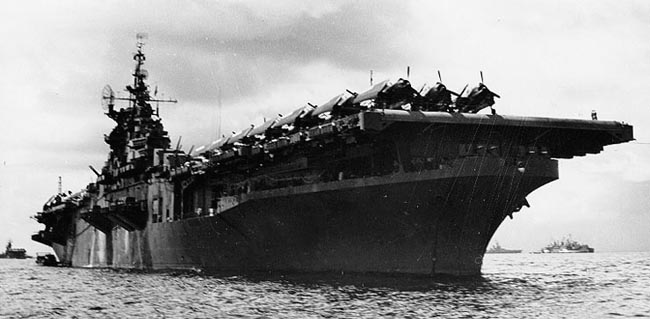
USS Randolph at anchor, western Pacific, June 1945
USS Randolph was commissioned on 9 October 1944 with Captain Felix Locke Baker in command, sailing out after trials and post-trial fixes, for her first shakedown cruise off Trinidad. Adter post-trials modifucations and preparation for upcoming operations, she was sent to the Pacific via Panama. On 31 December she entered San Francisco to receive sent on shore Air Group 87, exchanged for Air Group 12, for four months training.
After a maintenance and crew leave for the new year, she was prepared for the war, and departed on 20 January 1945 for Ulithi Atoll. She sortied on 10 February with TF 58 to make her first air strikes from 16–17 February against Tokyo airfields as well as the Tachikawa engine plant. She attacked afterwards Chichi Jima and on 20 February, supported ground forces on Iwo Jima and Haha Jima, plus usual combat air patrols above the fleet. Next she launched three major sweeps against airfields in the Tokyo area, Hachijo Jima, before sailing ut for a resupply run on 25 February to Ulithi.
While at anchor on 11 March, she was attacked by a lone Yokosuka P1Y1 “Frances” kamikaze, which managed to hit her on the starboard side, aft below the flight deck. The massive impact killed 27, wounding 105. The captain made a first initial damage assessment, later confirmed by Raymond Spruance. It was esteemed beyond the capabilities of Pearl Harbor, so she would have to sail to the west coast, making her absent from operations for five months. She completely missing the invasion of Okinawa. However Lt. Cmdr. Samuel Humphrey, at the time Randolph’s catapult officer, convinced Baker and Spruance that repairs could be completed at sea using the repair ship USS Jason (AR-8) instead, which was close.
USS Randolph from there would have the provilege to be the most extensive repair at sea ever performed by the US Navy. Humphrey’s took charge of it, moving the forward arresting-gear catapult engine aft, amazingly to replace the destroyed first engine. This bold and unconventional idea allowed the aircraft carrier to be operational again in a mere few weeks. There was limited damage on the flight deck, and little in the hangar so she still was able to launch and retrieve aircraft. Still, a lotof hard work was performed round the clock at her badly damaged stern, the torn down covering being removed and even structural steel components changed.
Many elements in the hangar deck, elevator and flight deck supports had been warped by the intense fires and engineers used 29 tons of structural steel, even I-beams from a Japanese sugar mill of Saipan to complete the work, even using 7,500 board feet of lumber on her flight deck. Charles Minter praised this decision, as this allowed the air group to remain in the forward area and even being able to launch and retrieve aircraft during repairs. Randolph’s repairs were completed, amazingly by 1 April 1945, just at the launch date of the invasion of Okinawa.
So USS Randolph could sail with TF 58 on 7 April; launch her Combat air patrol and start strikes against Okinawa, Ie Shima, and Kakeroma Islands. This was followed by a sweep in southern Kyūshū and in May, Ryukyu Islands, southern Japan, Kikai Naval Base in Amami Islands, numerous airfields installation and she even had the honor of becoming the flagship of TF 58 from 15 May, supporting the occupation of Okinawa and retired via Guam to the Philippines.
Bakk in the 3rd Fleet, USS Randolph raided like the rest of the fleet, the Japanese home islands. Air Group 16 replacing Air Group 12 and took part in eight raids from 10 July, especially over the Tokyo area, but also sinking shipping in the Tsugaru Strait area. The Honshū-Hokkaidō train ferries were also sunk and damaged, cutting off any personal moves in the area. On 18 July her air group pummeled IJN Nagato, heavily camouflaged alongside a pier at Yokosuka Naval Base, then rempaged the coast of Shikoku (24 July), destroying all spotted shipping in the Inland Sea and also bombing IJN Hyūga as well as many other objectives on Kyūshū, Honshū, and Shikoku. On 15 August, her pilots argued on 10-25 July alone they sank 25-30 ships, damaged 35-40 others. Kisarazu Airfield was her last target, on the morning.
Post-war
CV-15 headed home via the Panama Canal (late September), not giving the chance to enter Tokyo bay or support occupation operations. She entered the Naval Station at Norfolk on 15 October, inspected again and prepared for “Magic Carpet” runs, making two trips in the Mediterranean area. In 1946, she became reservists & midshipmen training ship making a Mediterranean cruise that year and another in the Caribbean in 1947, followed by a cruise to northern Europe. Decommissioned on 25 February 1948 at Philadelphia Naval Shipyard, she waited her fate.
 USS Lexington (CV-16)
USS Lexington (CV-16)
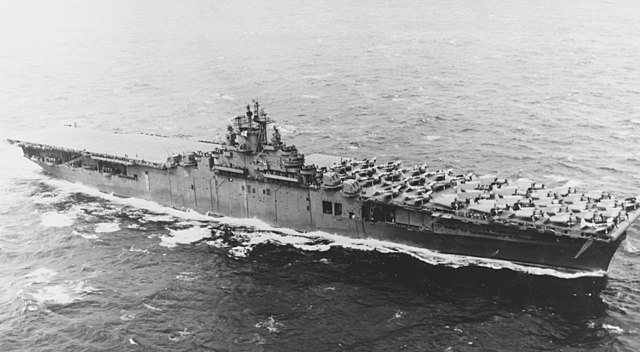
uss lexington underway 12 November 1943
USS Lexington was commissioned on 17 February 1943, and after a shakedown cruise in the Caribbean she saile via the Panama Canal to the Pacific fleet. Her first pilot lost was 1939 Heisman Trophy winner Nile Kinnick when conducting training off her deck, splashing after a serious oil leak and never recovered. USS was in Pearl Harbor on 9 August 1943. She participated first in the Tarawa raid on late September, and then Wake Island in October, then back to Pearl Harbor. Next she was deployed in the Gilbert Islands operations covering landings, as well as raids in the Marshalls on 19-24 November, claiming 29 enemy aircraft on 23-24 November.
Damage at Kwajalein (4-5 Dec. 1943)
She also participated in the raid on Kwajalein, 4 December, her aviators claming SS Kembu Maru, two cruisers damaged, 30 enemy aircraft destroyed. AA gunners also claimed two torpedo planes, later ordered during the night not to fire… as Admiral Charles Pownall believed it would betray their position (he was sacked). At 23:22, parachute flares silhouetted the carrier attacked by a torpedo plane, and hit on the starboard side. USS Lexington had her steering gear out of action. She had nine killed, including two later of the repair party, settling 5 feet by the stern and circling to port. Fortunately in a sense, she was hidden by smoke pouring from ruptured tanks aft. Damage control crews sealed the damaged compartments, welded shut and using extra heavy steel plates. Also engineers devised an hand-operated steering unitso she can sail to Pearl Harbor for emergency repairs. She sailed afterwards to Bremerton on 22 December, repairs being over on 20 February 1944. Opening fire at night was from then learnt the hard way in the Navy, and no superior officer never ever would have asked to refrain on this. The Japanese nevertheless reported her sunk.
Battle of the Philippine Sea
USS Lexington was back to Majuro in the newly formed Task Force 58, on 8 March 1944. Mitscher carrie dhis mark onboard USS Lexington, which became his flagship. The air group stoke Mille Island, and the Fast Carrier Task Force next supported landings at Hollandia on 13 April, raided Truk on 28 April. USS Lexington between her CAP and AA splashed 17 enemy fighters during several attacks, while the Japanese propaganda continued to pretend she had been sunk. Operations went on in May. The surprise strike on Saipan (11 June) dealt with air opposition and on 16 June, USS Lexington fended off another torpedo bombers attack from Guam, and again, “sunk” a third time by Japanese propaganda. The Battle of the Philippine (19–20 June) saw USS Lexington shine, not only as flagship of TF 58 as she directed the “Great Marianas Turkey Shoot” but the indicual results of her air group and AA gunners.
From Eniwetok USS Lexington operated against Guam and the Palaus, the Bonins all this summer and until late August. In the Carolinas on 7 September she operated against Yap and Ulithi, then Mindanao in the Philippines, the Visaya islands and the Manila area, the west coast of Luzon. Next she raided Okinawa on 10 October, Formosa on the 12th, opening the Philippines campaign and fending off more attacks, escaping any damage during the counter-attack after the Formosa assault.
Battle of Leyte Gulf
Deployed in cover of the Leyte landings, USS Lexington took part in the Battle of Leyte Gulf. Under constant enemy attack her air group was co-credited the destruction of IJN Musashi and the three escorting cruisers on 24 October. Combined with USS Essex aor group the following day she sank IJN Chitose, and claimed alone IJN Zuikaku, then cos-sinking IJN Zuihō. Her air group als savaged and sank the cruiser Nachi with four torpedo, on 5 November off Luzon during the search and destroy operation that followed.
The same day, a kamikaze, hut by AA crashed near her island, debris destroying most of the island structure, spraying fire which was under control in 20 minutes. She was fully operatonal afterwards and claimed another kamikaze which targeted her sister ship USS Ticonderoga. On 9 November, she was back to Ulithi to resplenish and repairs. Meawnhile… Tokyo announced her sunk, a fourth time. Casualties were light and the crew was given some rest.
1945 Operations
Next, she returned as flagship for Task Group 58.2 this time, on 11 December. First operations were against airfields of Luzon and Formosa in January 1945. She entered the South China Sea , looking for enemy shipping and airfields. Strikes followed on Saipan, then Camranh Bay (Indochina), Hong Kong, the Pescadores, and Formosa. Four merchant ships and their four escorts (the entire convoy) was registered in her tally. She also savaged another one later, destroying nearly 12 ship off Camranh Bay (12 January). She set sail on 20 January to strike Formosa the next day, then Okinawa.
After replenishing at Ulithi, on 10 February she started a long serie of striked near Tokyo, notably on 16-17 February, in order to isolate Iwo Jima for landings, starting on 19 February. Next she flew close support missions for the assaulting troops 19-22 February, alternating with the home islands in a well known pattern also repeated later at Okinawa, with in-between resuepply runs at Uilithi. She also attacked Nansei Shoto until detached to sail to Puget Sound for a well-deserved overhaul.
USS Lexington was back in the Pacific on 22 May via Alameda, Pearl Harbor, arriving in San Pedro Bay (Leyte), assigned to Rear Admiral Thomas L. Sprague’s task force. Operations focuse on the home islands, in July and up to 15 August. That day, pilots received en route orders to jettison their bombs at sea and return to the carrier at once: Japanese surrender was now official. Her air groups wrecked Honshū and Hokkaidō airfields, Yokosuka and Kure naval bases. At Kure, her F4U-1D Corsairs (VBF94) bombed and strafed IJN Ise until she sank, despite heavy enemy fire. Squadron commander Lester Wall Jr. distinguishe himself by his marksmanship, dropping his 1000lb bomb stright into her stack. This made her boilers epxploding and broke her keel, the resulting detonation matching the destruction of the Arizona, as an avenging feat. He and several men were later awarded the Navy Cross. For her service in WW2, “The Blue Ghost” won 11 battle stars and a unit presidential citation.
In September, her air group still patrolled the shore and overland. Lt.Cmdr. Wall notably located POWs on Honshū, abandoned and returned to drop them food rations, earning the Distinguished Flying Cross. In December, USS Lexington ferried troops home as part of Operation Magic Carpet, at San Francisco. She was decommissioned at Bremerton (Washington), 23 April 1947, National Defense Reserve Fleet. Redesignated CVA-16 on 1 October 1952 she was chosen for modernization, which started in September 1953 in Puget Sound. She received the SCB-27C and SCB-125 conversion and was recommissioned on 15 August 1955 for a very long career, seeing the whole cold war in addition of WW2 as she was decommissioned on 8 November 1991. Not bad for an aircraft carrier supposed to have been sunk… four times, well deserving her “ghost” nickname, to the delight of the crew that served on her.
 USS Bunker Hill (CV-17)
USS Bunker Hill (CV-17)

USS Bunker Hill CV-17 underway at sea in 1943
Commissioned 25 May 1943, USS Bunker Hill after her sea trials started wotking with her air group, notably VF-17, the fighter squadron equipped with the new F4U Corsair. Due to recent development issues and complaints from pilots about difficulties to see the flight deck due to the long nose, the Navy considered replacing it with the proven Grumman F6F Hellcat. The squadron nevertheless sticked to its Corsairs, deemed superior in the end by the flight commander and pilots alike. USS Bunker Hill sailed with VF-17 from San Diego bound to Pearl Harbor, learning underway that the Navy eventually decided to rule out the Corsair aboard carriers for standardization issues, oligating to took parts and supplies for two fighters and a still gailing approval.
They would operated on land bases only, or go on the British Royal Navy’s Fleet Air Arm’s carriers, as the latter developed new landing technique suited for it in early 1944 with a curving approach with the landing signal officer in view during the approach. It was also adopted by the USN by late 1944. VF-17 however was detached and sent to the Southwest Pacific and replaced on board by Hellcats from VF-18, ferried aboard underway to Pearl Harbor.
She sailed on 19 October for the Southwest Pacific, participating in the Rabaul raid with USS Essex and Independence (11 November 1943). VF-18 in fact worked together with CV-17 based nearby at Ondonga Airfield (Solomon Islands). Tailhooks were reinstalled on the squadron’s Corsairs to land and refuel on USS Bunker Hill, allowing them to creat a CAP in cover of the the task force and escort bombers to Rabaul. On 14 November she was redirected to Gilbert Islands, covering the invasion of Tarawa.
Air raids on Kavieng in the Bismarck Archipelago were made on 25 December 1943, and on 1st and 4th January 1944. It was followed by air raids in the Marshall (29 January – 8 February), another raid on Truk Atoll (17–18 February), raids on the Marianas Islands (Guam, Saipan, and Tinian) on 23-25 February before a trip back to Pearl Harbor and an overhaul in drydock on 4 March 1944and until 9 March. CAG-17 embarked meanshile on CVG-8 with four night fighting Hellcats (VF(N)-76). From 20 March USS Bunker Hill was in Majuro in Marshall her air group now comprising 41 F6F-3 Hellcat (VF-8), 32 SB2C-1Cs (VB-8), 22 TBF-1Cs (VT-8) plus a command (flag) F6F-3 and the four F6F-3Ns.
USS Bunker Hill next was occupied with raids on Palau, Yap, Ulithi, and Woleai (30 March to 1 April), in support of landings around Hollandia on 21–28 April, a new raid on Truk and in Satawan, Ponape, all in the Carolines from 29 April to 1 May, and patrols in the Marianas during the invasion of Saipan and Guam on 12 June – 10 August 1944. She also took part in the Battle of the Philippine Sea. On 19 June she was damaged during an attack, a Japanese bomb scattering shrapnel across her decks and side. Two killed, about 80 wounded but the damage was only superficial. Fires were quickly mastered and she remained fully operational. Her AA gunners claimed several IJN warplanes, and it was only the start of their tally.
From September 1944, USS Bunker Hill helped raiding the Western Caroline Islands befopre sweeping north, and attacking Luzon, Formosa, and Okinawa up to November. On 6 November she was redirected eastward home, to the Bremerton Naval Shipyard and her major overhaul. She also received weaponry and eletronics upgrades. The crew had a long leave for christmas. It was over 24 January 1945 and CV-17 was back in combat operations in the Western Pacific, with Air Group 84 onboard, still “green”, with VF-84, fortunately trained well by the nucleus of veterans from VF-17.
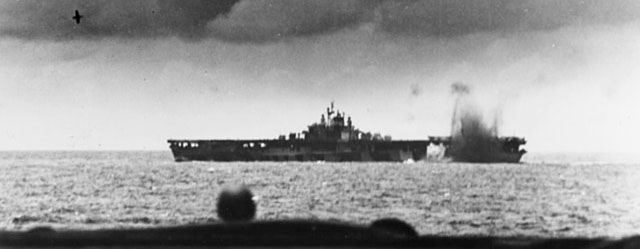
USS Bunker Hill, near-missed by a Japanese bomb Battle of the Philippine Sea, 19 June 1944
USS Bunker Hill became flagship for Task Force 58, (Vice-Admiral Marc A. Mitscher) a famous core capital ships unit that would lead the final charge against Japan. Onboard was Commodore Arleigh Burke, Mitscher skilled chief of staff. Her first assignation for 1945 was for the invasion of Iwo Jima with the 5th Fleet. She carried raids on Honshū and Nansei Shoto from 15 February to 4 March plus brough support for ground operations. On 7 April 1945, she was detached for a sweep in the East China Sea and her aircraft located the IJN Yamato, sent in a one-ticket run (Operation Ten-Go) with one light cruiser and eight destroyers. Their goal was to steam to Okinawa and beached to be use as a fixed fortress for ground support. Of course all available air groups took off and she was prioritized. USS Bunker Hill’s own Helldivers and Avengers took their share in her sinking as well as the cruiser and four destroyers.

USS Bunker Hill at sea in 1945
On 11 May 1945 USS Bunker Hill was deployed in support of Operations on Okinawa, when a major (one of many) Japanese air attack succeeded in piercing the curtain of fighters and AA. Two Kamikaze dropped their bombs, severely damaging the aircraft carrier: These were a Mitsubishi A6M Zero (Lieutenant Junior Grade Seizō Yasunori) using low cloud cover for his approach. His 550-pound (250 kilogram) bomb penetrated her flight deck, exiting from the side at gallery deck level and exploding in the ocean, fortunately, but the Zero itself crashed onto her flight deck, setting ablaze all her parked warplanes, gorged with fuel and ammunition.
The second Kamikaze hit 30 seconds later (Ensign Kiyoshi Ogawa), dropping a 550-pound bomb which impacted close to her island, as pilots were trained for. The bomb also penetrated the flight deck underneath and exploded in the pilot’s ready room. 22 VF-84 pilots were kille dinstantly, many others were badly burned.
In all, USS Bunker Hill was crippled, loosing 393 sailors and airmen that day, plus 41 missing, 264 wounded. Three officers and nine men from Mitscher’s staff were among the deads. This was a tremendous hit to the fleet as its flagship could no longer operate. The admiral relinquished command and with his staff, was transferred to the destroyer USS English and ferried from there to the old USS Enterprise.
Bunker Hill was in such state she was no longer operational, but her safety teams mastered the fires and her machinery was intact. So she steamed at 20 knots to Ulithi, rejoined underway by VMF-221, aloft at the time and in between, diverted to other carriers. Fro Ulithi, she departed for Pearl Harbor for more permanet repairs and Bremerton Naval Shipyard. The war ended while repairs proceeded. On 27 September 1945, just repaired and upgraded, USS Bunker Hill sailed for a first run of Operation Magic Carpet, with TG 16.12. She made four return trips, from pearl Harbor, the Philippines, Guam and Saipan. Oopened for visitors on Navy Day, 27 October 1945 in Seattle, WA. she spent the rest of the year there and by January 1946 was ordered to Bremerton, to be deactivted as per peace practice. She was decommissioned, in reserve on 9 January 1947. CVA-17 in October 1951 and CVS-17 in August 1953, then AVT-9 in May 1959, or “Auxiliary Aircraft Transport Carrier”, she was considered surplus (also badly damaged, like USS Franklin), so not chosen for conversion or modernization. Stricken in November 1966, she was used as a stationary electronics test platform (North Island NAS, San Diego) up to the early 1970s, and sold on 2 July 1973. Some tried to preserve her as a museum ship. For her wartime service she earned a Presidential Unit Citation for her 18 months (11 November 1943-11 May 1945), and 11 battle stars.
 USS Wasp (CV-18)
USS Wasp (CV-18)
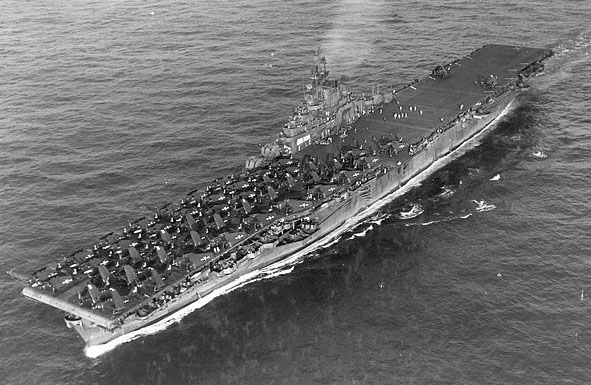
USS Wasp CV-18, Western Pacific 6 August 1945
Following her shakedown cruise until the end of 1943 (she was commissioned on 24 November 1943, leaving little time for extra training) she had in Boston a brief postcruise fixes before being considered fully operational. On 10 January 1944 she departed for Hampton Roads in Virginia and some training, the was based in Trinidad until 22 February, the back to Boston and prepared to depart for the Pacific in early March, transiting via Panama and arriving at San Diego on 21 March, reached Pearl Harbor on 4 April.
Mariana Campaign March-June 1944
Following training off Pearl Harbor USS Wasp was assigned to the force attacking the Marshall Islands and her new home base in Majuro, under orders from Rear Admiral Alfred E. Montgomery and in TG 58.6 (Vice Admiral Marc A. Mitscher) including the famous Fast Carrier Task Force (TF 58). On 14 May 1944 with Essex and San Jacinto she raided Marcus and Wake Islands for the sake of combat experience. It was notaby the occasion to have a new system battle-proven: Assigning before takeoff each pilot a specific target. The idea was also to have these islands playing no further part in the forthcoming Marianas Campaign. USS Wasp and Essex launched strikes on 19 and 20 May on the installations on Marcus Island, encountered heavy AA fire. In all the island was devastated enough to play no part in the subsequent Saipan attack.
In May after cancellation due to heavy weather the two carriers were reunited with USS San Jacinto and steamed to Wake, attacke don 24 May but also showing the system of selecting targets for each plane was wrong. Tactical air commanders from then on were delegated this responsibility, directly on site from their own planes. After Wake, and resupply to Majuro, USS Wasp returned to the Marianas and on 6 June was reassigned to TG 58.2 (Rear Admiral Montgomery) deployed in the invasion of Saipan starting on 11 June. Saipan but also Tinian were attacked but challenged by around 30 land-based fighters and intense AA fire as well.
For three days, installations on Saipan and Japanese defenses were destroyed before the assault on 15 June. 58.2 and TG 58.3 later provided close air support for the Marines. The fast carriers then departed and were replaced by escort carriers, tasked both for local air support and defence, the usual procedure of island-hopping tactics. Refueled, USS Wasp steamed to meet with TGs 58.1 and 58.4, returning from Chichi and Iwo Jima.
Battle of the Philippine Sea, 18 June 1944
Admiral Jisaburō Ozawa’s First Mobile Fleet meanwhile was mobilized to retake Saipan, and steamed from the Sulu Islands to the Marianas. Facing him was Admiral Raymond A. Spruance’s 5th Fleet. Spotted by a submarine off Tawi Tawi on 13 June, alter was given, then confirmed by other picket submarines pre-positioned kept Spruance posted on their progress. They soon arrived in the islands of the Philippines, approaching by San Bernardino Strait, when he attacked, kickstarting the Battle of the Philippine Sea.
On 18 June 1944, scout planes were deployed to precise the location of the Japanese, but the Japanese were first due to their greater range, while Ozawa escaped the Americans. On 19 June, Mitscher’s carriers were en rout to Guam and destroyed land-based planes while Ozawa launched four carrier-borne raids, all intercepted and destroyed almost completely. A single single bomb hit on South Dakota leaving little damage was the only result. American submarines spotted and sunk two enemy carriers, IJN Taihō and Shōkaku.
Three of Mitscher’s carriers headed west in search of Ozawa, while TG 58.4 was left tp cover Saipan. Its only the afternoon, 20th that Ozawa’s force was spotted almost 300 mi from the American carriers and Mitscher scrambled a massive air strike, which materilized into firced attacks two hours later. Two oilers were badly damaged and beached/scuttled, the aircraft carrier IJN Hiyō sunk and Ryuho, Junyō, Zuikaku, and their escorts were all damaged at sunset.
The long distance back and night however resulted in many planes lost, including those of USS Wasp, which lokout spotted the first returning plane at 20:30, Rear Admiral J. J. Clark famously ordering all lights turned to guide the pilots, despite the risk of posssible Japanese subs in the area. To facilitae recovery, Mitscher also gave pilots permission to land on any carrier available. Despite of all this, many ditched into the water and the frantic search for downed pilots would take weeks.
Mitscher then resume the stern chase of Ozawa’s crippled fleet, hoping to end for all the First Mobile Fleet before it reach home islands. On 21 June, Spruance detached Wasp and Bunker Hill to cover Admiral Lee’s battleships in Ozawa’s wake, leading to a two-day hunt for nothing. Thus force was sent to Eniwetok for replenishment and rest.
Philippine campaign, July-October 1944
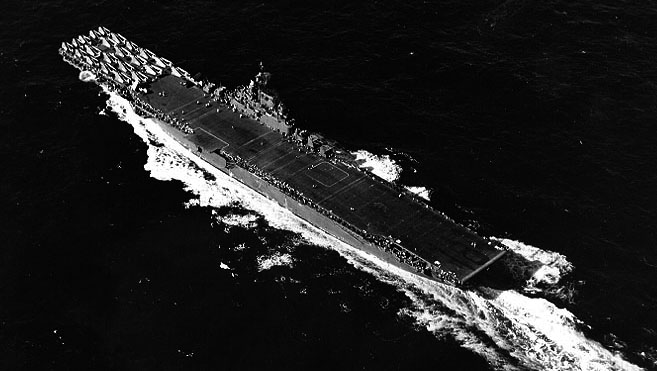
USS Wasp CV-18 underway off Trinidad 22 February 1944
On 30 June, Wasp TG 58.2 and TG 58.1 were at sea again to strike Iwo Jima and Chichi Jima again. The raid took place on 3–4 July and, claming 75 enemy aircraft, mostly airborne the rest on the ground. Iwo Jima was later pounded by cruisers, and on 5 July, this combined force was back to the Marianas, attacking Guam and Rota in preparation for the future landings. Close air support was provided then for the marines on 21 July. The 22th saw USS Wasp with TG 58.2 heading for the the Western Carolines, to raid the Palaus (25th).
Next the Bonin and Volcano Islands were attacked and USS Wasp (TG 58.2) sailed to be resenished at Eniwetok on 2 August. The Fast Carrier Task Force, redesignated TF 38 as in the 3rd fleet now, made another strike on the Palaus. On 6 September USS Wasp became flagship for Vice Admiral John S. McCain, TG 38.1 for these Palaus Operations. On 9 September, USS Wasp headed for the southern Philippines to allow assaults on Morotai, Peleliu, and Ulithi.
Wasp planes strucks Mindanao airfields on 9-10 September, followed by the Visayan Islands on 12-13 September, with almost impunity. This weak resistance conducted to a cancellation of the invasion of Mindanao (planne 16 November) and instead planners wanted to go straight to Leyte.
On 15 September USS Wasp and TG 38.1 were 50 mi (80 km) off Morotai, launching attacks, followed by Mindanao and the Visayas, before resupplying in the Admiralties on 29 September (Manus island). USS wasp was at sea on 4 October, advancing to the Philippine Sea and joining TF 38 on the the evening of 7 October 375 mi (604 km) west of the Marianas. As always, destroying airbases within operational air distance was parmamount to secure the landings on Leyte planned for 20 October. The carriers were refuelled by nine oilers on 8 October, and sailed for the Ryūkyūs on 10 October, launching strikes on arrival on Okinawa, Amami, and Miyaki. This foray was the closest approach to the Japanese home islands since Doolittle.
From 12 October, Formosa (now Taiwan) was attacked by TF 38, one of many times. The Japanese Navy mustered all what’s left to protect the latter, including her remaining carriers, stripped of aircraft. The three-day air battle over Formosa saw the destruction of more than 500 planes and 20 freighters, may other badly damaged as instalaltion al over the island. TF 38 paid this by loosing 79 planes and 64 pilots & crewmen, USS Canberra, Houston the aircraft carrier USS Franklin badly damaged by Kamikaze.
TF 38 was back in the Philippines, east of Luzon, launching new strikes on 18-19 October, notably Manila for the first time. On 20 October, troops landed as planned on Leyte, while Wasp was moved south to launch close air support missions, but enabling them to attack as well airfields on Mindanao, Cebu, Negros, Panay, and Leyte. TG 38.1 refueled on the 21 and a day later steamed to Ulithi to rearm, take provision and allowing crew’s rest, well earned.
Battle of Leyte, 24 October 1944
But the respite was short: As soon as McCain’s carriers were underway, Admiral Soemu Toyoda activated plan Sho-Go-1, leading to the epic and final Battle of Leyte Gulf. Ozawa’s carriers were to act as a decoy, to lure TF 38 north of Luzon, allowing two surface force dto arrive south through Surigao Strait and from the north, through San Bernardino Strait. On 24 October, Halsey’s carrier task groups attacked Kurita’s Force “A” (Center Force), the battle of the Sibuyan Sea until darkness, leaving IJN Musashi sunk, other ships sunk and crippled as well. They were reported Kurita’s force position and took the bait, in hot pursuit. Admiral Nishimura’s Force “C” (Southern Force) was stopped en route by Rear Admiral Jesse B. Oldendorf’s battleline and crippled. On 24 October Kurita’s Center Force retreated and Halsey’s scout planes located Ozawa’s carriers 200 mi (320 km) north of TF 38, promting his Fast Carrier Task Force, including USS Wasp away north in hot pursuit. Kurita’s Center Force meanwhile changed course, transited by night the San Bernardino Strait, arrived at the east coast of Samar and fell on the landing’s three 7th Fleet escort carrier groups present (“Taffy 1-3”) deployed along Samar’s east coast, leading to a deperate -but heroic battle, succeeding in repelling Kurita.
Admiral Halsey meanwhile was recalled to help Taffy 3 and raced toward Samar, then launching all available planes on Kurita’s ships, still 330 miles away. This played a part in Kurita’s decision to retire from Leyte and end the battle. McCain’s fast carrier force (and USS Wasp) meanwhile recuperated his planes, and prepared them for a dawn attack on Kurita’s retiring force, on 26 October. USS Wasp – TG 38.1, plus TG 38.2 (Rear Admiral Bogan) launched strikes as planned, which sank IJN Noshiro and and nearly sank Kumano. A third strike gave no results.
After the Battle, TG 38.1 stayed in the Philippines before sailing to resplenish Ulithi on 28 October. Rear Admiral Montgomery took command as McCain relieved Mitscher at the hed of TF 38, but Wasp ws soon at sea again as Leyte’s beachhead were attacked by Japanese planes on 1 November. Wasp raised Luzon air bases on 5-6 October (in total claiming with other carriers some 400 Japanese aircraft moslty on the ground. USS Wasp later was in Guam exchanging air groups with the crippled USS Lexington. She was back in the Philippines and operated until 26 October, the Army Air Force assuming responsibility for the rest of the campaign. TF 38 resplenished in Ulithi, receving new fighter planes, and until December, conducted training to optimize their response to kamikaze attacks.
Operations against Okinawa and home islands, 1945
TF 38 departed on 11 December and sailed to the east of Luzon for strikes against air bases until 16 December, notably those threating the coast of Mindoro. After refuelling at sea east of the Philippines, TF 38 weathered the typhoon cobra, battering USS Wasp and sinking three American destroyers. After repairing storm damage the force was back to Ulithi, allowing the crew to rest on Christmas Eve. More aistrikes followed on airfields in the Philippines but also Sakishima Gunto and Okinawa. They prepared the invasion of Luzon via the Lingayen Gulf. On 8-9 January 1945, Halsey took TF 38 into the South China Sea for their week’s strikes before returning to Luzon Strait (16 January 1945) and 21 January 1945 raiding Formosa, the Pescadores and Sakishima Islands, and the Ryūkyūs, before their supply run at Ulithi on 26 January.
USS Wasp next assisted in the attacks on Iwo Jima, Volcano Islands, required as an emergency landing point for crippled B-29 underway to bomb Japan. TF 58’s carriers launched before dawn on 16 February, Wasp loosing several fighters durng that mission. Bombing missions on Tokyo followed, hampered by bad weather, before swapping to the Volcano Islands and preparing an assault in Iwo Jima on19 February.
This proceeded, with in between supplt runs, more raids on Tokyo. USS Wasp from 17 to 23 March was hard at work defendng aagainst Kamikaze, deploying her CAP and having her AA gunners on high alert daily. On 19 March 1945 however, USS Wasp’s luck ran out: She was hit with a single 500 Ib AP bomb which penetrated her flight deck via the armored hangar deck, exploding in the crew’s galley were many shipmates had breakfast after being at general quarters (102 killed). The number-four fire room was also badly damaged. USS Wasp was still able to continue operations, just 27 minutes after the impact.
On 13 April 1945, she was discharged and headed for Puget Sound in Bremerton, Washington to be repaired. She steamed afterwards to Pearl Harbor and was back to report for duty on 12 July 1945. She made a strike at Wake Island and later rejoined via Eniwetok, the Fast Carrier Task Force. Strikes on the home islands went unopposed at this point. Wasp’s air group bombed and strafed Yokosuka Naval Base, airfields, hidden manufacturing centers. On 9 August USS Wasp near-avoided a catastrophy: As single gunner, cleaning his gun at this point, spotted an incoming kamikaze at low altitude to escape radars, shooting and killing the pilot, while the plane had a wing destroyed, veering off into the sea. Apart the water plume that inundated the deck, there was no other hazard. On 15 August, two Japanese planes attacked USS Wasp but CAP pilots intercepted them. These Japanese pilots were not aware (ot not willing to respect) the recently announced ceasefire and capitulation. They were probably the last Kamikaze shot down in history.
Post war and cold war career
On 25 August 1945, USS Wasp was caught by a severe typhoon, loosing approx. 30 ft (9 m) of her bow. She still continued to launch missions of mercy or patrol also dropping medicine and luxuries to POWs across Japan. Notably at Narumi, near Nagoya. She was back to Boston for Navy Day, open to public on 27 October 1945. On 30 October, she ws transforced in the yard to perform repatriations runs (Magic Carpet), until 15 November to carry 5,500 enlisted passengers and 400 officers. She was one of the rare Essex-class carriers modified to so so. She notably also brought Italian POWs back to Italy but on 17 February 1946, ran aground off the coast of New Jersey. On 17 February 1947, she was decommissioned, Atlantic Reserve Fleet. She would received in 1948-51 an SBC-27 modenrization to operate jets and served a CVS-18 from November 1956, until July 1972. She earned 8 battle stars for her service.
 USS Hancock (CV-19)
USS Hancock (CV-19)
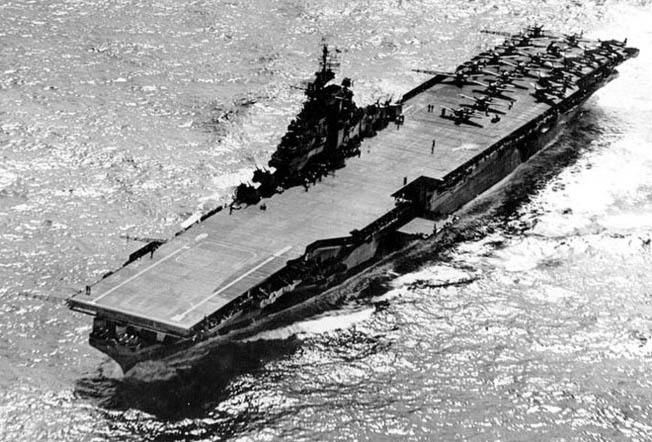
USS Hancock CV-19 Philippines, December 1944
After fitting out in Boston Navy Yard, USS Hancock made her shake-down cruise off Trinidad and Venezuela. Back to Boston for pos-shakedown fixes and alterations on 9 July 1944 (she was commissioned much earlier on 15 April 1944), she sailed on the 31th for war. Via panama and Pearl Harbor she was assigned from 5 October 1944 after much training in Hawaiian waters to Admiral W. F. Halsey’s 3rd Fleet, based in at Ulithi. She was then versed more precisely to Rear Admiral Gerald F. Bogan’s Carrier Task Group 38.2.
USS Hancock sailed to a point 375 nmi (690 km) west of the Marianas where Vice Admiral Mitscher’s TF 38 were assembling. They planned the first large scale raid in the Ryūkyūs but also Formosa and the Philippines, expecting opposition. Japanese air power here was crippled and paralyzed essentially to free General MacArthur’s push on Leyte. On 10 October 1944, Hancock’s air group took off for their first combat mission of the war, and targeted Okinawan airfields and shipping. Her pilots also claimed seven planes on the ground, and asssist destruction of a Japanese submarine tender as well as 12 torpedo boats and 2 midget submarines, but also four cargo ships and many sampans. She laso later attacked Formosa, striking all air bases on 12 October, shooting down six planes, with nine more on the ground and a cargo ship, three probable, 4-5 damaged.
Her CAP also repelled an enemy air raid and her gunners splashed their first ones, driving off many more during a continuous seven hours attack, wave after wave. The 13th, her air gropup completed the destruction by hitting all inslallation spotted. There was a second night of attack by the Japanese off Formosa, and AA fire dealt with it, but one aircraft crashed just 500 yd (460 m) off her flight deck. The 14th, the same routine started, but there was no wait for an evening attack as the fleet departed for he southeast. Underway they were attacked, and on bomb fell close to USS Hancock’s port bow. Another penetrated a gun platform but existed and exploded in the water. This was her first war damage, with no casuality.
On 18 October, her air group was scambled to hit Laoag, Aparri, and Camiguin Island (Northern Luzon) before rampaging Cebu, Panay, Negros, and Masbate, notably destrying airfields and shipping in the area. She retired the next day to Ulithi with TG 38.1 (Vice Admiral John S. McCain). On 23 October however she was recalle dunderway to Samar, in hope of assisting in the search for Japanese fleet ships reportedly closing on Leyte. However USS Hancock missed the battle and only heard about the “Taffy 3” fight off Samar.
Her planes took off in chase of the fleeing Japanese Center Force via the San Bernardino Strait. Back with TG 38.2, she struck airfields and shipping off Manila on 29 October and until 19 November, brought direct support for ground operations as well as hunting down Japanese shipping over 350 mi (560 km). She eventually had the honor of becoming flagship of the Fast Carrier Task Force (TF 38), on 17 November 1944, Admiral McCain and his staff moving on board.
Due to bad weather she had to wait until 25 November to resume operations when that day a lone kamikaze emerged out of the sun, nut she was exploded by AA some 300 ft (90 m) above her, debris falling on her deck, bursting into flames. Teamwork mastered the blaze, prevented any more damage but some burnt deck.
After a stop to Ulithi on 27 November she returned in the Philippines, in search of airfields on Luzon, preparing the assault on Mindoro. This started on 14 December with striked on the former US airfields of Clark and Angeles City and taking on many other enemy ground targets, on Salvador Island. Her air group also hit Masinloc, San Fernando, Cabanatuan, an then shipping in Manila Bay. Like the rest of TF 38, USS Hancock was battered by typhoon Cobra on 17 December. Giant waves broke over her flight deck, destrying parked planes, and doing some damage along her hull. She returned to Ulithi on 24 December and was back to attack airfields and shipping around the South China Sea, Luzon airfields (7–8 January 1945) before returning to hit Formosa (9 January) notably setting ablaze the Toko Seaplane Station.
She also savaged a convoy off Camranh Bay in Indochina (two sunk, 11 damaged), then striking airfields at Saigon, and shipping in the northeast. Operations went on on 16 January 1945 between Hainan Island (Gulf of Tonkin) and the Pescadores Islands, as well as shipping in and out of Hong Kong, then Formosa. However when back of such sortie, on 21 January, one of her planed landed and taxied abreast of the island when it exploded, killing 50 men and injuring 75 others. Fires were quickly under control but the cause remains unclear. Next, USS Jancock was mobilized to launch strikes against Okinawa, and made a stop at the end of January to Ulithi, Admiral McCain leaving her.
She resumed operations on 10 February for strikes in the area of Tokyo (16 February) and claiming 71 enemy planes in the process, 12 more a day after. She also struck Chichi Jima and Haha Jima (19th) in order to isolate Iwo Jima, and she took her station for tactical support. Like the other essex-class she also left the area to hit northern Honshū, and the Nansei-shoto islands (1 March) before a supply run to Ulithi.
Next she attacked the Kyūshū airfields, southwestern Honshū and patroling for any ship in the Inland Sea of Japan (12-18 March). She refuelled her escort, the destroyer Halsey Powell on 20 March as kamikazes just attacked in force. One was shot down and disintegrated about 700 ft (210 m) overhead, with fragments again falling on the deck, whereas with its engine and bomb landed on the the fantail of the destroyer. Another was shot down close to drop its bomb.
Her captain learned CV-19 was now reassigned to TG 58.3 for the Nansei-shoto raid on 23-27 March, Minami Daito, then Kyūshū until April.
She provided the usual close suport during the invasion of Okinawa. On 7 April a kamikaze was hit and cartwheeled across her flight deck, crashing into a group of parked planes, refuelled and reloaded, the bomb gliding up to the port catapult and eventually exploding. This caused 62 killed and 71 wounded. This time was quite serious as the fire was close to spread in the hangar as well, but it was mastered aventually after an hour. The ship reported ready for duty and resumed operations.
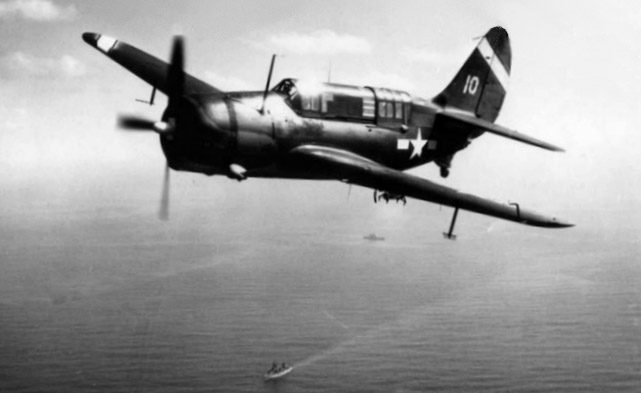
SB2C-3 from USS Hancock off Iwo Jima
USS Hancock was detached on 9 April for Pearl Harbor to be repaired and being given some limited upgrades, also allowing longer crew leave in Hawaii. She was back on 13 June 1945 for the attack of Wake Island (20 June) underway to the Philippines. There, like the rest of the fleet she was based on San Pedro Bay and departed on 1 July to attacked Tokyo airfields again, on the 10th. Operations went on along the coast, rempaging ports, installations and any opporunity or planned targets until Japan surrendered on 15 August 1945.
That day, all the Japanese units were not aware (or not willing to comply) and as it happened in multiple occasions, the Hancock small photo group (modified Hellcats) was intercepted by seven aircraft over Sagami Wan. Three were shot down, a fourth escaped, damaged. Later the same afternoon the CAP shot down probably their last incoming Japanese torpedo plane, which targeted the nearby British task force. Like other CVs her planes were now searching for POW camps, dropping supplies and medicine until 25 August. Commodore R. W. Simpson brought doctors and supplies to these based, on USS Hancock intel and many lives were saved.
Hancock’s planes flew overhead the signing of the official surrender onboard USS Missouri and she also entered Tokyo Bay on 10 September 1945, embarking later 1,500 passengers at Okinawa to land them in California (San Predo) on 21 October. She was fitted out for Operation Magic Carpet making runs to and from Manus in the Admiralty Islands in November (with 4,000 passengers) and 3,773 passengers from Manila to Alameda (California). It was on 20 January 1946. She embarked Air Group 7 at San Diego (18 February) for air operations traning off California and on 11 March embarked two air groups at Pearl Harbor to Saipan (1 April) carrying another cargo of aircraft at Guam via Pearl Harbor. After Alameda (23 April) she headed to Seattle on 29 April for inactivation. Decommissioned, reserve fleet at Bremerton she was preserved for long term reserve. After the war, in 1951 she was selected for a SBC-27C modenization, completed in 1954, becmoming CVA-19 in October 1952, recommissioned on 15 February 1954 as the first US carrier with steam catapults for jets. Her career would last until decommissioned on 30 January 1976, with a long service with the Pacific 7th fleet and a tour of duty in Vietnam. For her WW2 service she won four battle stars.
 USS Bennington (CV-20)
USS Bennington (CV-20)
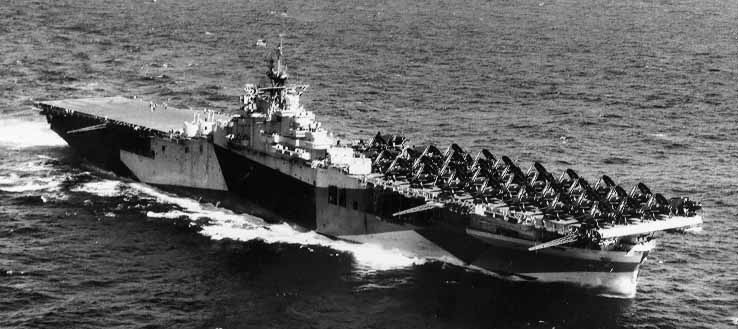
USS Bennington (CV-20) underway at sea 20 October 1944
USS Bennington was commissioned on 6 August 1944, with Captain James B. Sykes in command, completed her trials, her shakedown training, and post-shakedown fixes, so sha was resy for service by 14 December, departing New York and and transiting via the Panama Canal on 21 December to reach San Diego on 29 December. On New Year’s Day 1945, she departed for Hawaii, arriving on 7 January. Tranining followed until early February in Hawaiian waters, and she headed towards the Philippines with USS Belleau Wood, Bunker Hill, Randolph, Saratoga ecorted by the large cruiser USS Alaska, rn route to join Task Force 58 based in Ulithi Atoll.Bennington in her original configuration, 1944.
In Ulithi lagoon on 8 February, she was affected to Task Group (TG) 58.1. and departing on the 10th for her first roun of attacks on the Japanese home islands in support of the battle of Iwo Jima. First she operated in the vicinity of the Marianas for rehearsals over Tinian and launching her air group on 12 February, refueling at sea and again on the 14th, then reachine her deployment point 200 km southeast of Tokyo. On the 16th, TF 58 launched her largest combine strike on Japan.
USS Bennington struck Tokyo and Yokosuka, the major Japanese naval base. The carrier’s Combat Air Patrol (CAP) shot down three IJN incoming planes, but she lost one to AA. She retired on 18 February, refueled and steamed toward Iwo Jima for close support durng the conquest operations. This went on 20-22 February before refueling a day later, and back to Japan on 24-25, the retiring on the 26th for stroked on Okinawa airfields, on 1 March. The entire TF 58 resplenished in Ulithi on 3 March and rested for eight days.
On 14 March, after some refresher training exercises she hdeaded for Kyushu to hit airfields and naval bases in support for the upcoming assault on Okinawa, until 18 March. On the 19th her air group struck the Kure Naval Arsenal and Hiroshima area. On the 20th, her Air Group 82 (CVG-82) pounded airfield and other objectives on Kyushu. She later retired towards Okinawa, for direct support before landings. On 23 March, not only Okinawa by surrounding islalds were all attacked, VC-20 concentrating notably on Kerama Retto, west of the southern tip of Okinawa, the first objective in the invasion battle plan. These later became the main fleet anchorage and forward repair base for the whole Okinawa campaign.
The landings started on 1 April USS Bennington started a routine of alternating between close support and strikes on Okinawa and surrounding area, and raids on the Japanese home islands (Kyushu in particular) for distant support. On 7 April she was present during the last major action of the IJN, launching a one-ticket mission with the battleship Yamato, Yahagi and eight destroyers. Spotted on the 6th and confrmed underway on the 7th by patrol planes, TF 58 scrambled any avilable planes to launch a massive attack, in which Bennington’s air group participated. Only four destroyers, damaged, escaped, reaching Sasebo Naval Arsenal. Bennington claimed two torpedo hits on Yamaot but lost a single plane.
Her mission went on, striking spotted airfields at the origin of kamikaze attacks and direct support on Okinawa, plus the local combat air patrols intercepting Kamikaze. On 28 April she left with TG 58.1 for some rest in Ulithi until 9 May. She made a round of exercises directed at mastering AA fire against Kamikazes and match their tactics. She was back in the vicilinty of Okinawa on the 10th, resuming support, and alternating with sweeps against the Kyushu airfields. Her first serious damage was in June, when weathering the Typhoon Connie. She had notably her whole forward section of the flight deck completely submarge by an anormous wave and bended down. Tis was so bad she had to leave on 9 June for Leyte Gulf, to be repairs, between the 11th and 27th at San Pedro Bay. On 1 July she was back with TF 38.
She would remain off the Japanese home islands this summer with operations ranging from from Hokkaido, way north, to Kyushu, way south, and Honshu in between. Countless industrial complexes, military and naval installations, or shipping were blasted. On 15 August her air group was concentrated on Honshu when they were ordered to come back, as Japan surrendered.
USS Bennington stayed afterwards in support of occupation forces, making routine patrols and searches for POWs. On 10 September she entered Tokyo Bay and remained here until mid-October, heading for home via Saipan to disembark her air group, then Pearl Harbor and San Francisco Bay (7 November 1945). In January 1946 she was back in Hawaii with a load of planes and men to serve them, plus a modernized air group. After training operations she was back to San Francisco on 30 March. In April she sailed again, with CVG-19 on board, transited the Panama Canal to reach Norfolk in Virginia, on 22 April, and on 8 November was decommissioned, berthed and presered for the Atlantic Reserve Fleet.
USS Bennington remained remained there until 29 October 1950, then moved to the New York Naval Shipyard to be modernized, with the SCB-27A scheme. In October 1952 she made her sea trials ad fixes before being recommissioned, as CVA-20 and on 13 November, had her new captain, David. B. Young taking command. She would be dpliye in the Mediterranean and Pacific and made a tour of duty in Vietnam. She was decommissioned in January 1970, winning 3 battle stars for her service in WW2.
 USS Boxer (CV-21)
USS Boxer (CV-21)
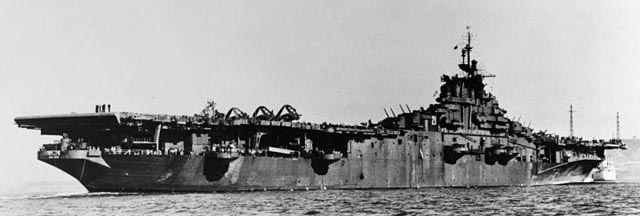
USS Boxer CV-21 at sea c1945
USS Boxer was commissioned on 16 April 1945. Her first captain was D. F. Smith. After sea trials, she made her shakedown cruise, however she was not ready due to training before Japan surrendered on 15 August. Nevertheless, the headed for Pearl Harbor via San Diego in August 1945, and Guam to become the centerpiece and flagship of Task Force 77 until 23 August 1946. She visited Japan, Okinawa, the Philippines, and China uduring her pacific tour of duty.
Back to San Francisco on 10 September 1946, she embarked a new Air Group, AG19 equipped with the brand new Grumman F8F Bearcat. USS Boxer started peacetime patrols alternated with training missions off the coast of California in 1947. USS Boxer made another tour of duty in the Pacific and readiness back on the West Coast and Hawaii in between. In 1948, she started a serie of short cruises, with US Navy Reserve personnel. On 10 March 1948, she was used as a test aicraf carrier for the new FJ-1 Fury jet, first jet catapult launch on any USN carrier. This opened the door to other experiments, notably high speed landings, and trials with a small jets squadron to evaluate jet operations. USS Boxer therefore participated in the making of the USN jet doctrine. Until 1949, she participated in several battle drills and became the de facto jet training carrier for the USN.
She made her last tour of duty in the Far East on 11 January 1950 and joined the 7th Fleet, with a goodwill visit to South Korea, havng onbard the South Korean president Syngman Rhee and his wife, notably showing jets desmonstrations. She sailed back to San Diego on 25 June 1950, just as the Korean war started. She could have been sent back right away, but she was overdue for a major overhaul since 1945, and a maintenance, so she was drydocked anyway.
Staying “in her juice” she was sent right afterwards and participated to the Korean war and subsequent operations of the 7th fleets in the 1950s until converted as CVS-21, specialized ASW carrer in 1956. She was decommissioned eventually in 1968, after 25 years of service.
 USS Bon Homme Richard (CV-31)
USS Bon Homme Richard (CV-31)
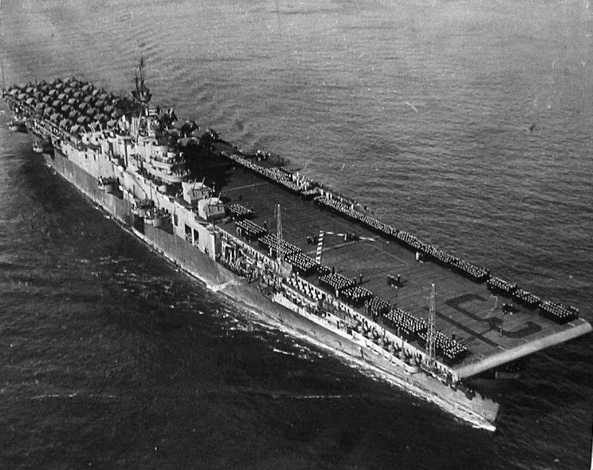
USS Bon Homme Richard 20 October 1945
Bon Homme Richard (CV-31) was the first Essex-class carrier built at the New York Navy Yard, launched 29 April 1944 and commissioned 26 November 1944. Captain A. O. Rule Jr. was first in command as the ship trained and made her shakedown cruiser in the Carribean. She departed Norfolk on 19 March 1945 afterwrds, ordered to the Pacific Fleet, Pearl Harbor arriving on 5 April 1945. She made additional training in Hawaiian waters until her captain esteemed she was ready to join TF 38 at the time operating off Okinawa, on 6 June 1945. She was assigned with Carrier Air Group 91 (CVG-91), launching her first strikes in support on 7–10 June over Okidaitōjima. Versed to the 3rd Fleet she took part in air strikes against the Japanese homeland on 2 July-15 August and remained off Japanese coast until the 15 of August, learning the end of hostilities.
She operated there on 16 September 1945 in support to the occupation, and patrolling Japanese waters until a refresher training off Guam. She then proceeded to San Francisco, reached on 20 October and dpartin on the 29th for Pearl Harbor. There, she undewent a conversion for troop transport duties. From 8 November 1945, until 16 January 1946 she made two “Magic Carpet” Operation runs. Back home, she was placed in inactive status, ad properly decommissioned on 9 January 1947, mothballed at Puget Sound Naval Shipyard in the state of Washington.
At that point she won two battle stars, but her career was far from over: Recommissioned on 15 January 1951 she made a tour of duty off Korea during the war, was modernized (SCB-27C), served in Vietnam and was decommissioned in 1972, mothballed but only sold for scrap in March 1992, after 48 years at sea.
 USS Antietam (CV-36)
USS Antietam (CV-36)
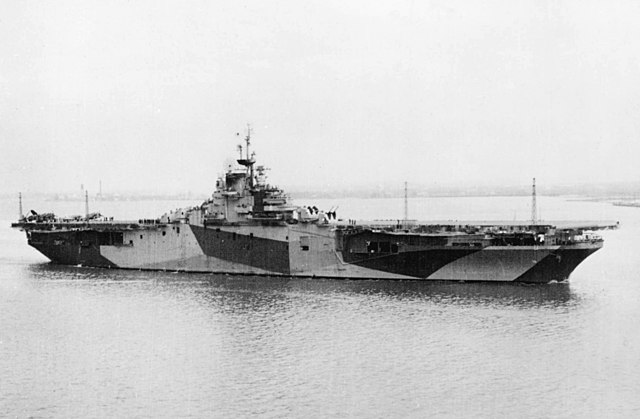
USS Antietam off Philadelphia Navy Yard, March 1945
USS Antietam was commissioned on 28 January 1945, her first commanding officer being Captain James R. Tague. After fitting out at Philadelphia, until 2 March 1945, she sailed out for her shakedown cruise off Hampton Roads three days after, conducting operations from Norfolk then off Chesapeake Bayn before sailing for Trinidad. When Tagie estimated her crew was trained well enough, she saild back for Philadelphia on 28 April, for post-shakedown fixes and preparations for subsequent operations in the Pacific.
On 19 May 1945, she departed Philadelphia, stopped in Norfolk, then headed for the Panama Canal with the destroyers USS Higbee, George W. Ingram, and Ira Jeffery. Stopping in Cristóbal on 31 May 1944, she crossed it and eventullaly reached San Diego, California. On 13 June she departed for the first leg, of her voyage, reaching Pearl Harbor on 19. She trained in Hawaiian waters until 12 August before departing for the western Pacific, but just three days underway she received news of the Japanese reddition.
She arrived in Eniwetok Atoll on 19 August and her new task was now to support the occupation troops safe passage and support. On 21 August, she sailed with USS Cabot for Japan but suffered internal damage en route forced a detour into Apra Harbor, Guam. The inspection revealed minimal damage so she was freed to resume her trip on 27 August, redirected in between to the Chinese coast, stopping at Okinawa on 30 August and arriving at Shanghai soon after. USS Antietam remained there for three years, in Yellow Sea.
She covered the occupation of North China, Manchuria, and Korea and the last year, her air group stayed as observers in the conncluding phases of the Chinese civil war. They were there when Mao Zedong’s People’s Republic of China became the sold continental power. In between, USS Antietam made resplenishment runs to Japan but the Philippines and also Okinawa, and visits in the Mariana Islands. The year 1949 was the last as she sailed back to the United States, deactivated and decommissioned eventually on 21 June 1949. Never totally modernized but cionverted as an Anti-submarine warfare carrier for the Atlantic fleet and decommissioned on 8 May 1963.
 USS Shangri-La (CV-38)
USS Shangri-La (CV-38)
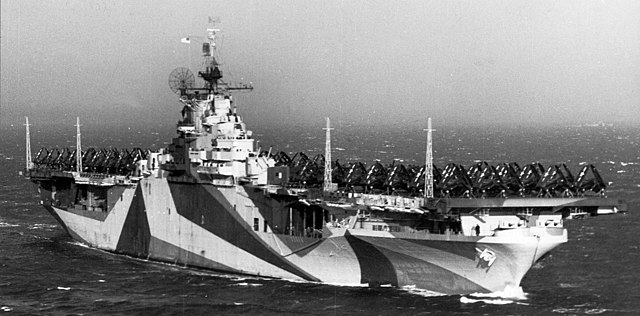
Leaving Nortfolk, 17 January 1945
Shangri-La was commissioned on 15 September 1944, with her first command Captain James D. Barner in command. Related to the “Chijese connection” of early war, she was christened by James H. Doolittle christens while launched at Norfolk Navy Yard in Virginia by 24 February 1944. After fitting out at Norfolk she started her shakedown cruise to Trinidad (15 September-21 December 1944) and was back to Norfolk for post-shakedown fixes. From 17 January 1945, she trained off Hampton Roads before teaming with her bodyguard, the large cruiser USS Guam, flanked by the destroyer USS Harry E. Hubbard, all three proceeding to Panama.
From Cristobal on 23 January and transiting to the Pacific the following day, they departed Balboa for San Diego, California (4 February), loaded passengers, stores, and extra planes before sailing to Hawaii on 7 February. From the 15th, two months of training and pilot qualifications started.
On 20 April, they arrived in Ulithi Atollto started operations, VC-38 departing with USS Haggard and Stembel to join Task Force 58 and reaffected to Task Group 58.4 on the 24th meeting later TG 50.8. USS Shangri La scrambled her air group CVG-85 for her first strike on Okino Daito Jima, southwest of Okinawa. They destroyed radar and radio installations and then sailed for Okinawa, providing a CAP and close air support for the 10th Army progessing on Okinawa before a resplenishment run to Ulithi on 14 May.
USS Shangri-La became flagship for Carrier Task Force 2 (Vice Admiral John S. McCain) from 18 May. With TG 58.4 becoming TG 38.4, McCain relieving Mitscher at its head, he nevertheless remained on USS Shangri-La and early June, TG 58.4 launched air strikes on Kyūshū. Airborne resistance was fierce, giving the occasion to Shangri-La’s airmen and AA crews to down and splash a considerable number of IJN aircraft, but with heavy losses. On 4–5 June, the TG steamed northwest, dodging a rapidly approaching typhoon and on 6 June 1944 they brought close air support over Okinaw, then on 8 June, rampaged Kyūshū, before being back to Okinawa and leaving the area for Leyte Gulf, San Pedro Bay on 13 June for maintenance and rest.
On 1 July, USS Shangri-La returned to combat also hosting en route the oath of office of Assistant Secretary of the Navy by John L. Sullivan, first and last ceremony of its type in a combat zone. Air strikes followed around Tokyo from there until 15 August, starting on 10th July, Honshū and Hokkaidō on 14-15 July, Tokyo on the 18th, savaging IJN Nagato in Yokosuka.
On 20–22 July, USS Shangri-La joined a repenishement fleet at sea rand on the 24 July, her pilots looked for shipping off Kure, two more days of this followed by a replenishment on 26–27 July. Later her air group badly damaged IJN Ōyodo and IJN Haruna, the latter was beached and never recovered, so as good as sunk. Tokyo was hit on 30 July followed by a resplenishement from 31 July to 1 August.
USS Shangri-La stayed until a typhoon passed and was underway again on 9 August, delayed because of bad weather, for strikes on Honshū and Hokkaido, followed by Tokyo and central Honshū, replenished and weathered another Typhoon on 11–12 August. On 13 August, they struck Tokyo again, replenished on 14 August, before destroying airfields around Tokyo on the morning of 15 August 1945, elearning duinrg their return about the Japanese capitulation. On 15–23 August, she still patrolled off the Honshū area and until 16 September, sorties were mainly for air-dropping supplies to Allied POWs as roads were cluttered and the acccupation army advanced too slowly.
USS Shangri-La was in Tokyo Bay on 16 September, until 1 October. She headed for Okinawa (4-6 Octoberà before proceeding for home with Task Unit 38.1.1. via San Pedro Bay (21 October) and Long Beach for three weeks. Next she sailed for San Diego, and Bremerton (Washington), Puget Sound (9 December) then back to San Diego for normal peace time operations, notably pilot carrier landing qualifications. By May 1946, she was back in the Central Pacific for Operation Crossroads, the atomic bomb tests in Bikini. After a training cruise to Pearl Harbor they spend the winter in Puget Sound Naval Shipyard. By March 1947, she went to Pearl Harbor and visited Sydney fo the first time, and back home on 7 November 1947, she was decommissioned, placed in Reserve Fleet, San Francisco. Recomm. in 1951, CV-38 became CVA-38, operated in the Pacific, Atlantic and Mediterranean, became anti-submarine carrier (CVS) and earned three battle stars for her service in Vietnam War, decomm. 1971 and sold in 1988.
 USS Lake Champlain (CV-39)
USS Lake Champlain (CV-39)
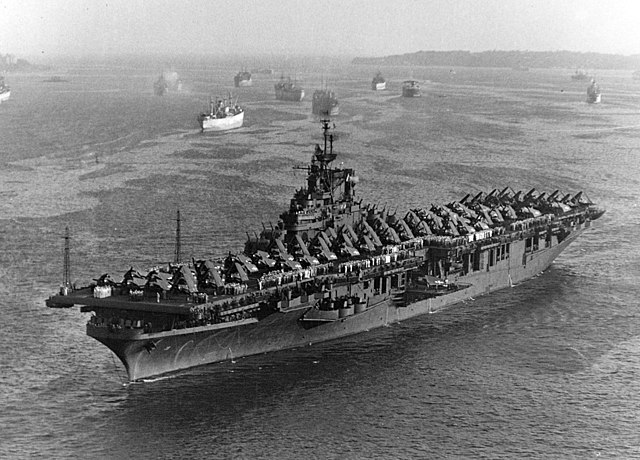
USS Lake Champlain in August 1945, off Norfolk.
USS Lake Champlain, built as a “long-hull” Essex-class in Norfolk Navy Yard (Portsmouth, Virginia) was launched on 2 November 1944 and commissioned on 3 June 1945, under command of Captain Logan Ramsey. After sea trials, post trials fixes, the shakedown and training between visits to New York and Philadelphia, USS Lake Champlain was still training when Japan capitulated. She was affected right away to “Magic Carpet” runs repatriate vets and personnel, but not the Pacific. Indeed she departed for her first run in the Atlantic, arriving in Southampton on 19 October, embarking veterans, carried back to New York. For her second run, she established a speed record for an aircraft carrier at 32.048 knots on average for the Atlantic crossing ending on 26 November 1945 at Norfolk, from Gibraltar, so 3360.3 nautical miles in just four days, eight hours and 51 minutes, a record that was still standing when broke by SS United States in 1952. After tatraining operations in 1946 she was sent to be deactivated in the reserve fleet, Norfolk, on 17 February 1947. Reactivated for the Korean war she was modernized SCB-27A and served woth NATO Med, Atlantic and middle east, project mercury & apollo, cuban crisis, until stricken in 1969, scrapped 1972.
Sources and goodies
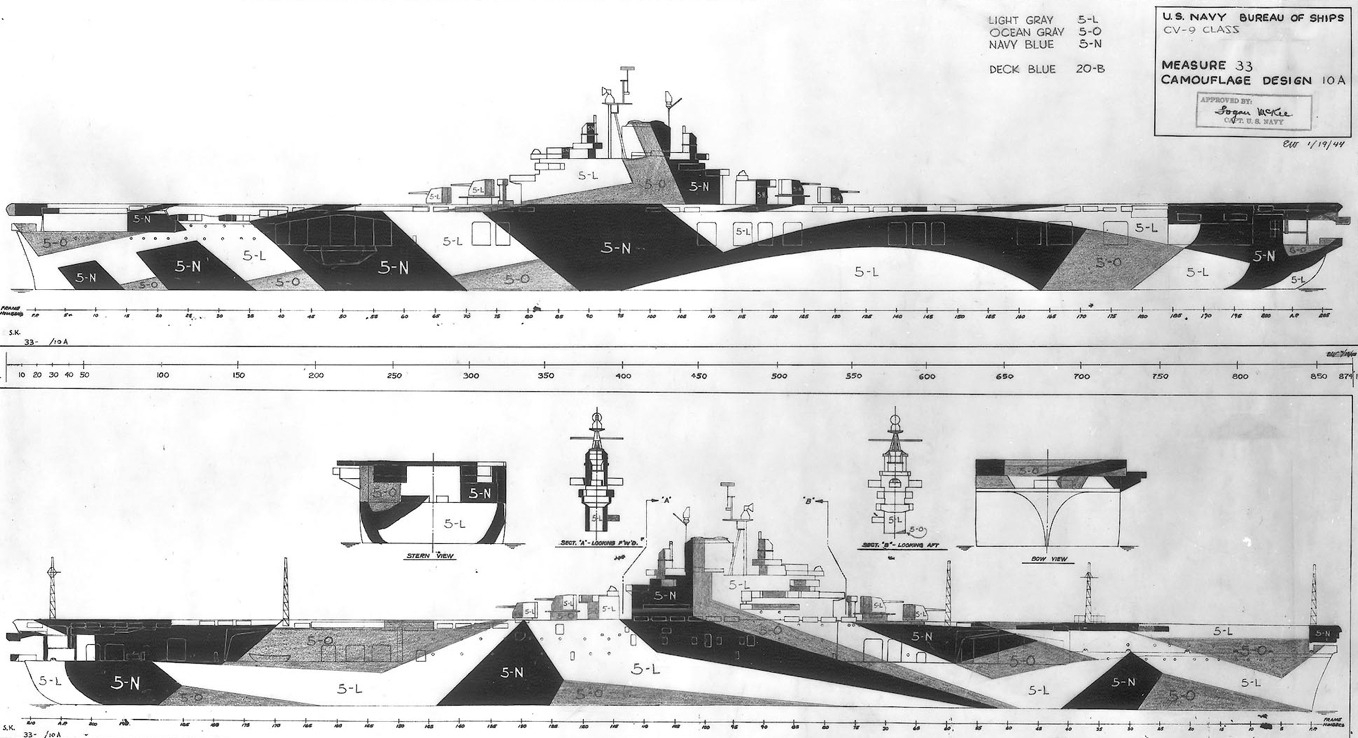
10A camouflage plate CV-36 USS Shangri-La
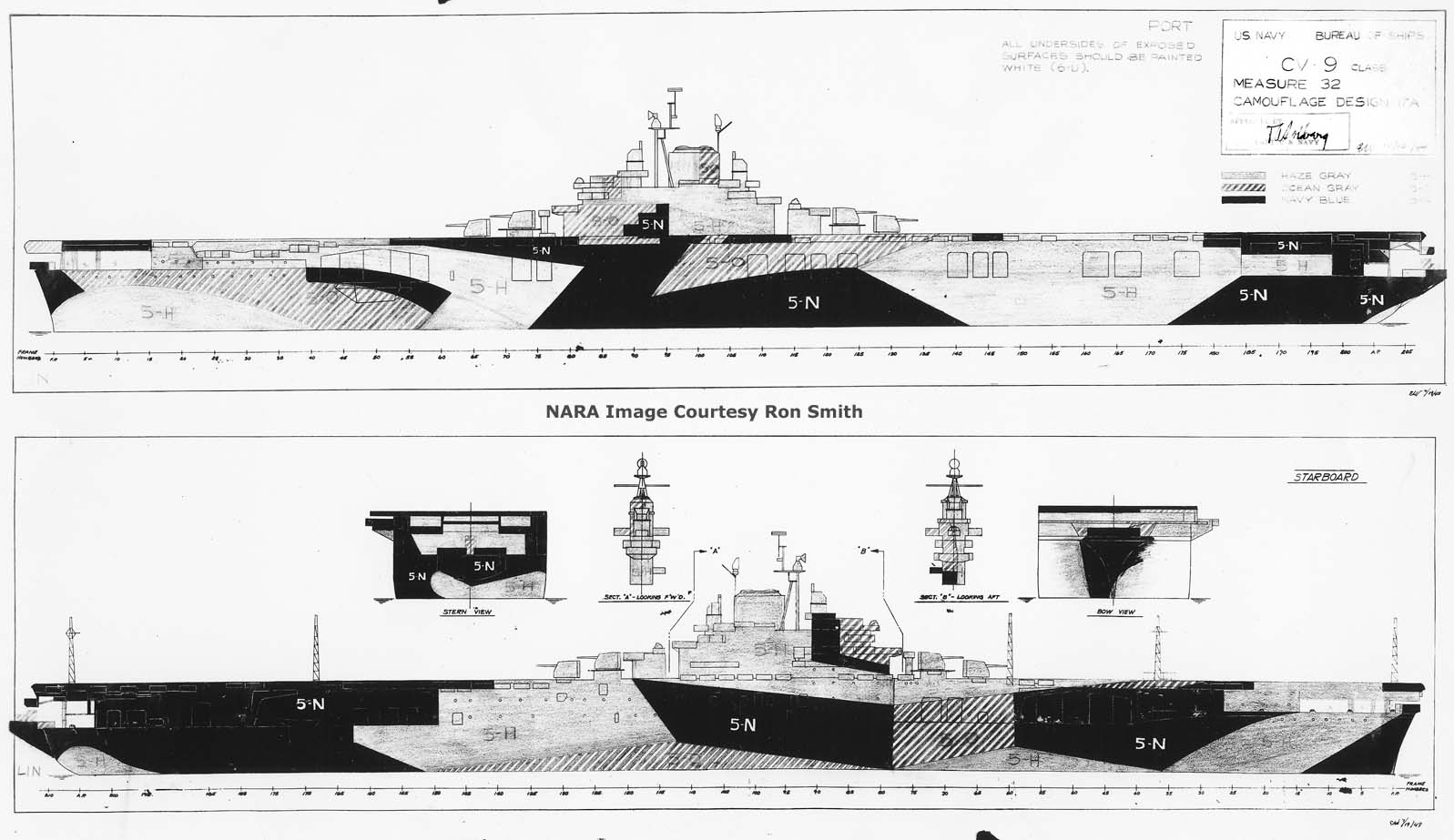
M32 17A camouflage plate CV-19 USS Antietam
Profiles

USS Intrepid in 1944, old author’s illustration: More modern and HD awaited.
Books
Donald, David; Daniel J. March (2001). Carrier Aviation Air Power Directory. Norwalk, Connecticut: AIRtime Publishing.
Fahey, James (1950). The Ships and Aircraft of the U.S. Fleet (Sixth ed.). Washington, DC: Ships and Aircraft.
Faltum, Andrew (1996). The Essex Aircraft Carriers. Baltimore, Maryland: The Nautical and Aviation Publishing Company of America.
Friedman, Norman (1983). U.S. Aircraft Carriers: An Illustrated Design History. Annapolis, Maryland: Naval Institute Press.
Raven, Alan (1988). Essex-Class Carriers. Annapolis, Maryland: Naval Institute Press.
Roberts, John (1982). Anatomy of the Ship: The Aircraft Carrier Intrepid. London: Conway Maritime Press.
Sowinski, Lawrence (2000). “The Essex Class Carriers”. Warship Volume II. Annapolis, Maryland: Naval Institute Press.
St. John, Philip (1999). USS Essex (CV/CVA/CVS-9). Nashville, TN: Turner Publishing Company.
St. John, Philip (2000). USS Randolph (CV/CVA/CVS-15). Nashville, TN: Turner Publishing Company.
United States Navy, Bureau of Ships (1999). “Design Histories of United States Warships of World War II: The Essex Class CV-9-21, 31-40, 45-47 (Part 1)”. Warship International.
Wright, C. C. (1999). “Technical Annex (Part 2)–Essex (CV-9) Class Selected Ship Characteristics”. Warship International. XXXVI (4)
Huggins, Mark (May–June 1999). “Setting Sun: Japanese Air Defence of the Philippines 1944–1945”. Air Enthusiast (81)
Potter, E.B. (2005). Admiral Arliegh Burke. U.S. Naval Institute Press.
Reynonds, Clark (1968). The Fast Carriers. U.S. Naval Institute Press.
Taylor, Theodore (1954). The Magnificent Mitscher. Naval Institute Press.
Willmott, H.P. (1984). June, 1944. Blandford Press.
The aicraft carrier Intrepid by John Roberts
Essex class carriers by Alan Raven
Warship perspective -Essex class CVs i WW2 by Glenn R. Arnold
The Essex aircraft carriers by Andrew faltum
US aircraft carriers, an illustrated design history, ships plans by AD Baker III.
Essex class carriers in action, Osprey warships N°10 Sqn signal
essex class 1943-91 by Leo Marriott, Images of war coll.
Links
On seaforces.org
On navypedia.com
USS Essex on navsource.org
TF38 on pacific.valka.cz
TF58 on pacific.valka.cz
USS Oriskany assoc.
Navsource main CVs galleries
On seaforces.org
Essex class on steelnavy.com
On uboat.net
On USN radars
Organization on 1st May 1945, history.navy.mil
On cybermodeler.com
VA-93 Blue Blazers
USS Bennington’s air groups
wik SBC 27
wik Essex
The essex class on ww2db
The Essex class on weaponsandwarfare.com
The class on ibiblio.org
Video: Essex class carriers by Drachinifels
Video: Essex class by the navyreviewer
Video: design stages – TheShipYard channel
Video footage: carriers hit Tokyo 1945/03/19
3D renditions

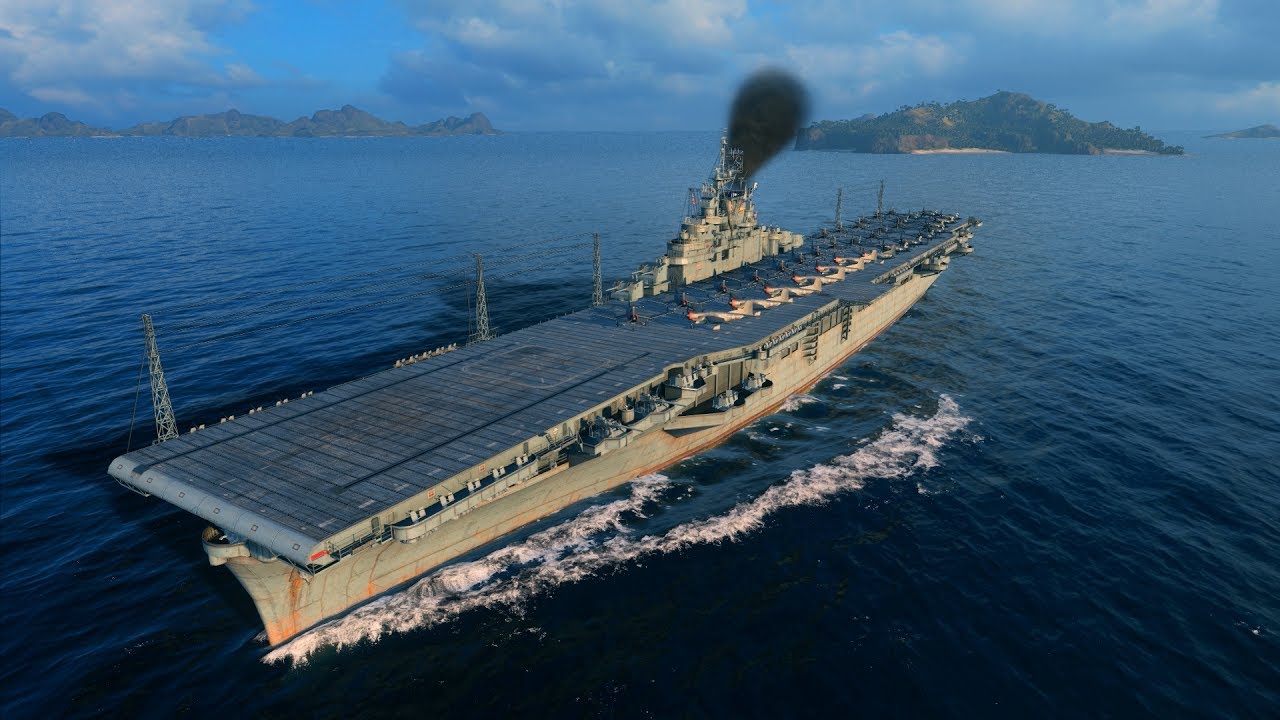
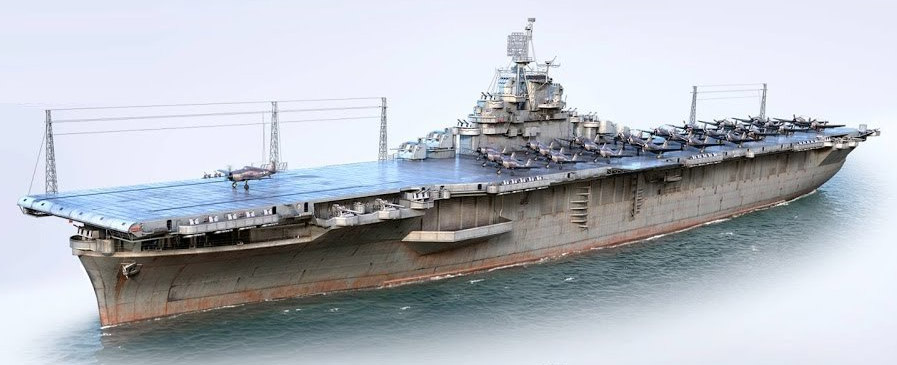
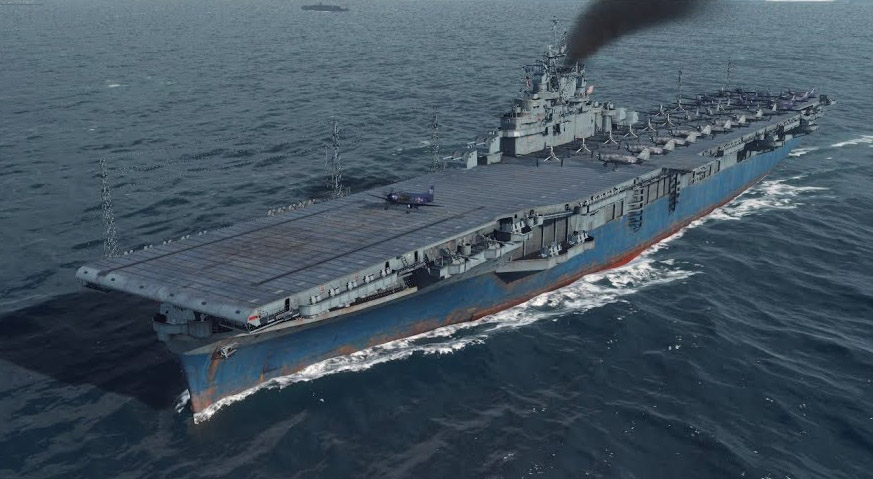
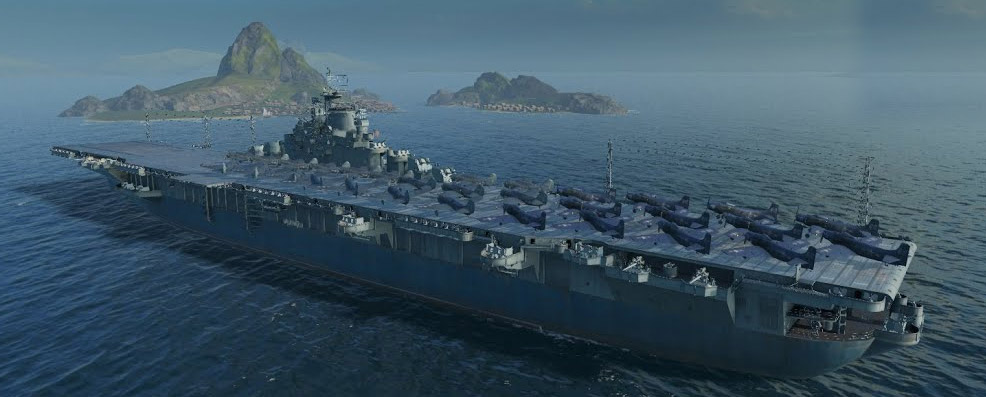
Various renditions, world of warship.
Model kits

Trumpeter 1/350 scale kit
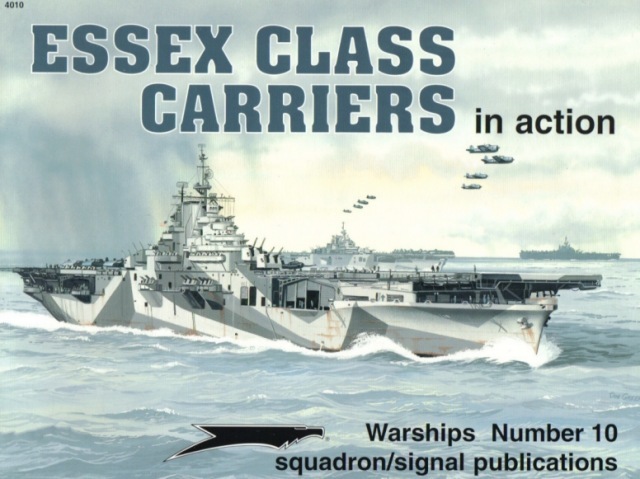
Essex class in action, Sqn. signal book cover
Scrathbuilt gallery 1/350 USS Bunker Hill
navsource gallery uss antietam
Camouflage measures for the Essex class
On steelnavy.com, trumpeter kit review and a list of modellers books
Modelwarship review of essex in action by squadon signal
“Essex” on scalemates search engine


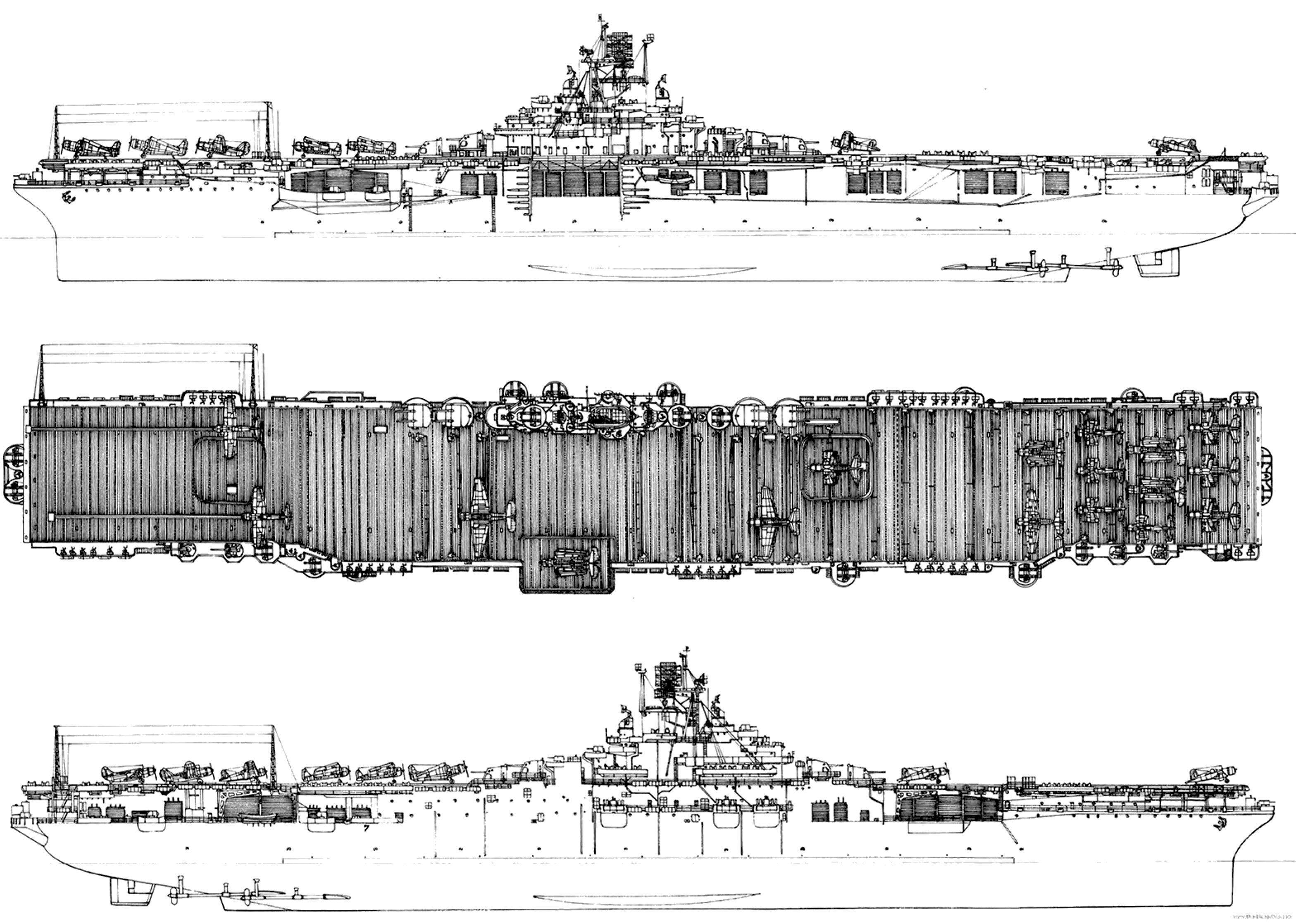
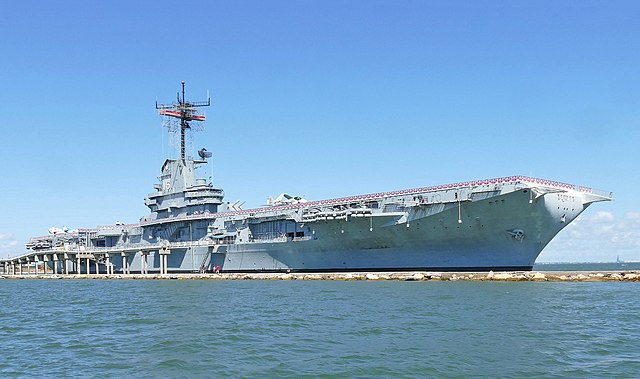

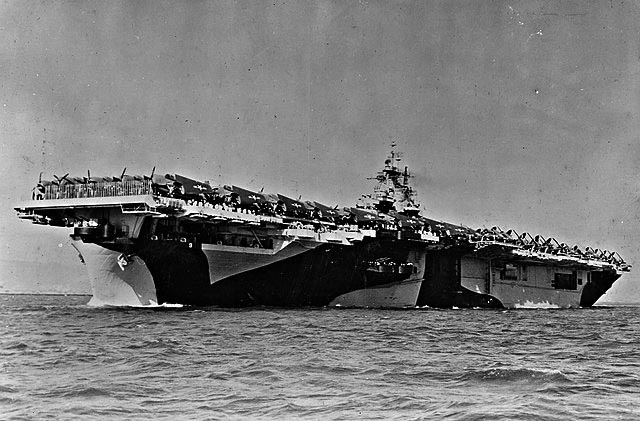
 Latest Facebook Entry -
Latest Facebook Entry -  X(Tweeter) Naval Encyclopedia's deck archive
X(Tweeter) Naval Encyclopedia's deck archive Instagram (@navalencyc)
Instagram (@navalencyc)





 French Navy
French Navy Royal Navy
Royal Navy Russian Navy
Russian Navy Armada Espanola
Armada Espanola Austrian Navy
Austrian Navy K.u.K. Kriegsmarine
K.u.K. Kriegsmarine Dansk Marine
Dansk Marine Nautiko Hellenon
Nautiko Hellenon Koninklije Marine 1870
Koninklije Marine 1870 Marinha do Brasil
Marinha do Brasil Osmanlı Donanması
Osmanlı Donanması Marina Do Peru
Marina Do Peru Marinha do Portugal
Marinha do Portugal Regia Marina 1870
Regia Marina 1870 Nihhon Kaigun 1870
Nihhon Kaigun 1870 Preußische Marine 1870
Preußische Marine 1870 Russkiy Flot 1870
Russkiy Flot 1870 Svenska marinen
Svenska marinen Søværnet
Søværnet Union Navy
Union Navy Confederate Navy
Confederate Navy Armada de Argentina
Armada de Argentina Imperial Chinese Navy
Imperial Chinese Navy Marinha do Portugal
Marinha do Portugal Mexico
Mexico Kaiserliche Marine
Kaiserliche Marine 1898 US Navy
1898 US Navy Sovietskiy Flot
Sovietskiy Flot Royal Canadian Navy
Royal Canadian Navy Royal Australian Navy
Royal Australian Navy RNZN Fleet
RNZN Fleet Chinese Navy 1937
Chinese Navy 1937 Kriegsmarine
Kriegsmarine Chilean Navy
Chilean Navy Danish Navy
Danish Navy Finnish Navy
Finnish Navy Hellenic Navy
Hellenic Navy Polish Navy
Polish Navy Romanian Navy
Romanian Navy Turkish Navy
Turkish Navy Royal Yugoslav Navy
Royal Yugoslav Navy Royal Thai Navy
Royal Thai Navy Minor Navies
Minor Navies Albania
Albania Austria
Austria Belgium
Belgium Columbia
Columbia Costa Rica
Costa Rica Cuba
Cuba Czechoslovakia
Czechoslovakia Dominican Republic
Dominican Republic Haiti
Haiti Hungary
Hungary Honduras
Honduras Estonia
Estonia Iceland
Iceland Eire
Eire Equador
Equador Iran
Iran Iraq
Iraq Latvia
Latvia Liberia
Liberia Lithuania
Lithuania Mandchukuo
Mandchukuo Morocco
Morocco Nicaragua
Nicaragua Persia
Persia San Salvador
San Salvador Sarawak
Sarawak Uruguay
Uruguay Venezuela
Venezuela Zanzibar
Zanzibar Warsaw Pact Navies
Warsaw Pact Navies Bulgaria
Bulgaria Hungary
Hungary

 Bundesmarine
Bundesmarine Dutch Navy
Dutch Navy Hellenic Navy
Hellenic Navy Marina Militare
Marina Militare Yugoslav Navy
Yugoslav Navy Chinese Navy
Chinese Navy Indian Navy
Indian Navy Indonesian Navy
Indonesian Navy JMSDF
JMSDF North Korean Navy
North Korean Navy Pakistani Navy
Pakistani Navy Philippines Navy
Philippines Navy ROKN
ROKN Rep. of Singapore Navy
Rep. of Singapore Navy Taiwanese Navy
Taiwanese Navy IDF Navy
IDF Navy Saudi Navy
Saudi Navy Royal New Zealand Navy
Royal New Zealand Navy Egyptian Navy
Egyptian Navy South African Navy
South African Navy






























 Ukrainian Navy
Ukrainian Navy dbodesign
dbodesign